Volume II – Worship
Church Building
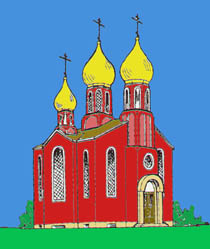
In the long history of the Orthodox Church a definite style of church architecture has developed. This style is characterized by the attempt to reveal the fundamental experience of Orthodox Christianity: God is with us.
The fact that Christ the Immanuel (which translated means “God with us”) has come, determines the form of the Orthodox church building. God is with man in Christ through the Holy Spirit. The dwelling place of God is with man. “The Most High does not dwell in houses made with hands,” says Saint Stephen quoting the Old Testament prophets. Saint Paul says that men are the temples of God:
“Christ Jesus himself [is] the cornerstone, in Whom the whole structure is joined together and grows into a holy temple in the Lord; in Whom you also are built into it for a dwelling place of God in the Spirit” (Eph.2:21–22).
The words of Saint Peter are very much the same.
“Come to him [Christ] to that living stone . . . and like living stones be yourselves built into a spiritual house . . . to offer spiritual sacrifices acceptable to God through Jesus Christ” (1Pet.2:4–5).
“We are the temple of the living God . . .” (2Cor.6:16). And it is exactly this conviction and experience that Orthodox Church architecture wishes to convey.

Orthodox Church architecture reveals that God is with men, dwelling in them and living in them through Christ and the Spirit. It does so by using the dome or the vaulted ceiling to crown the Christian church building, the house of the Church which is the People of God. Unlike the pointed arches which point to God far up in the heavens, the dome or the spacious all-embracing ceiling gives the impression that in the Kingdom of God, and in the Church, Christ “unites all things in himself, things in heaven and things on earth,” (Eph.1:10) and that in Him we are all “filled with all the fullness of God” (Eph.3:19).
The interior of the Orthodox Church building is particularly styled to give the experience of the unity of all things in God. It is not constructed to reproduce the upper room of the Last Supper, nor to be simply a meeting hall for men whose life exists solely within the bounds of this earth. The church building is patterned after the image of God’s Kingdom in the Book of Revelation. Before us is the altar table on which Christ is enthroned, both as the Word of God in the Gospels and as the Lamb of God in the eucharistic sacrifice. Around the table are the angels and saints, the servants of the Word and the Lamb who glorify him – and through him, God the Father – in the perpetual adoration inspired by the Holy Spirit. The faithful Christians on earth who already belong to that holy assembly “. . . fellow citizens with the saints and members of the household of God . . .” (Eph.2:19) enter into the eternal worship of God’s Kingdom in the Church. Thus, in Orthodox practice the vestibule symbolizes this world. The nave is the place of the Church understood as the assembly and people of God. The altar area, called the sanctuary or the holy place, stands for the Kingdom of God.

Altar Table
We have mentioned how the entire church building is centered around the altar table. The altar table does not merely symbolize the table of the last supper. It is the symbolic and mystical presence of the heavenly throne and table of the Kingdom of God; the table of Christ the Word, the Lamb and the King of the ever-lasting life of God’s glorified dominion over all of creation.

The Book of the Gospels is perpetually enthroned on the altar table. It is on the altar table that we offer the “bloodless sacrifice” of Christ to the Father. And from the altar table we receive the Bread of Life, the Body and Blood of the Lord’s Passover Supper. This table is the “table of God’s Kingdom” (Lk.13:29).
In Orthodox Tradition the altar table is often carved wood or stone. It is usually vested with colorful material to show its divine and heavenly character. It should always be a simple table of proportional dimensions, often a perfect cube, and is always free-standing so that it may be encircled.
On the altar table one always finds the antimension. This is the cloth depicting Christ in the tomb which contains the signature of the bishop and is the permission for the local community to gather as the Church. “Antimension” means literally “instead of the table.” Since the bishop is the proper pastor of the Church, the antimension is used instead of the bishop’s own table which is, obviously, in his own church building, the cathedral – the place where the bishop has his chair (cathedra).
The antimension usually contains a relic (normally a part of the body) of a saint which shows that the Church is built on the blood of the martyrs and the lives of God’s holy people. This custom comes from the early Church practice of gathering and celebrating the eucharist on the graves of those who have lived and died for the Christian faith. Usually, a relic of a saint is embedded in the altar table itself as well.
Also on the altar table there is a tabernacle, often in the shape of a church building, which is a repository for the gifts of holy communion that are reserved for the sick and the dying. Behind the altar table there is usually a seven-branched candle stand which comes from the Old Testamental tradition of the Jewish temple. Generally speaking, the Jerusalem temple is highly valued in the Orthodox Christian tradition of worship and church construction as a “prototype” of the true worship “in spirit and truth” of the Kingdom of God (Jn.4:23).
Oblation Table
As we face the altar area the table of oblation on which the bread and wine are prepared for the liturgy stands on the left side of the altar table. The chalice – the cup for the wine – and the diskos – the round plate, elevated on a stand, for the bread – are kept on this table. These vessels are normally decorated with iconographic engravings, Christian symbols, and the sign of the cross.
On this table there is also a special liturgical knife – symbolically called the spear – which is used for cutting the eucharistic bread, and a liturgical spoon for administering holy communion to the people. There are also special covers for the chalice and diskos and a cruciform piece of metal called the star which holds the cover over the eucharistic bread on the diskos. A sponge and cloths for drying the chalice after the liturgy are also usually kept here. The oblation table is decorated in a manner similar to that of the altar table.
Above the table of oblation (the table on which the gifts for holy communion are prepared), which stands in the altar area to the left of the altar table, one might find various icons. A favorite one is that of Christ praying in Gethsemene: ‘Let this cup pass. . . .’ Another is that of the Nativity, although this is due to a symbolical interpretation of the Divine Liturgy which is not indicative of the fundamental liturgical tradition of the Church.
Icons
In the Orthodox Church the icons bear witness to the reality of God’s presence with us in the mystery of faith. The icons are not just human pictures or visual aids to contemplation and prayer. They are the witnesses of the presence of the Kingdom of God to us, and so of our own presence to the Kingdom of God in the Church. It is the Orthodox faith that icons are not only permissible, but are spiritually necessary because “the Word became flesh and dwelt among us” (Jn.1:14). Christ is truly man and, as man, truly the “icon of the invisible God” (Col.1:15; 1Cor.11:7; 2Cor.4:4).
The iconostasis or icon screen in the Orthodox Church exists to show our unity with Christ, his mother and all the angels and saints. It exists to show our unity with God. The altar table, which stands for the Banquet Table of the Kingdom of God, is placed behind the so-called royal gates, between the icons of the Theotokos and Child and the glorified Christ, showing that everything which happens to us in the Church happens in history between those “two comings” of Christ: between his coming as the Saviour born of Mary and His coming at the end of the age as the King and the Judge.
The icons on the royal gates witness to the presence of Christ’s good news, the gospel of salvation. The four evangelists who recorded the gospels appear, and often also an icon of the Annunciation, the first proclamation of the gospel in the world. In Greek the gospel is the evangelion, the authors of the gospels the evangelistoi, the annunciation the evangelismos.
Over the doors we have the icon of Christ’s Mystical Supper with his disciples, the icon of the central mystery of the Christian faith and the unity of the Church in the world. It is the visual witness that we too are partakers in the “marriage supper of the lamb” (Rev.19:9), that we too are blessed by Christ “to eat and drink at my table in my kingdom” (Lk.22:30), blessed to “eat bread in the Kingdom of God” (Lk.14:15).
Over and around the central gates are icons of the saints. The deacon’s doors in the first row (for the servants of the altar) usually have icons depicting deacons or angels, God’s servants. The first row also has an icon of the person or event in whose honor the given building is dedicated, along with other prominent saints or events. Depending on the size of the iconostasis, there may be rows of icons of the apostles, the major feasts of the Church, the prophets and other holy people blessed by God, all crowned on the top by the cross of Christ.
In recent centuries the iconostasis in most Orthodox churches became very ornate and developed into a virtual wall, dividing the faithful from the holy altar rather than uniting them with it. In recent years this development has happily been altered in many places. The iconostasis in many church buildings now gives first place to the icons themselves and has become once more an icon “stand” or “screen” (stasis) rather than a solid partition.
Besides the iconostasis, Orthodox Church buildings often have icons or frescoes on the walls and ceilings. The “canon” of Church design is to have the icon of Christ the Almighty in the center of the building, and the icon of the Theotokos with Christ appearing within her found over the altar area. This latter icon is called the “image of the Church” since Mary is herself the prototype of the entire assembly of believers in whom Christ must dwell. In the altar area it is also traditional to put icons of the saints who composed Church liturgies and hymns. Directly behind the altar table there is usually an image of Christ in glory – enthroned or transfigured or resurrecting, and sometimes offering the eucharistic gifts.
Sign of the Cross
Also found on the altar table is a small hand cross used for blessing and for veneration by the faithful. The sign of the cross is used throughout the church building: on the holy vessels, stands, tables, and vestments.

The cross is the central symbol for Christians, not only as the instrument of the world’s salvation by the crucified Christ, but also as the constant witness to the fact – that men cannot be Christians unless they live with the cross as the very content of their lives in this world. “If any man would come after me, let him deny himself and take up his cross and follow me” (Mk.8:34).
For these reasons Christians place upon themselves the sign of the cross. The Orthodox place their first two fingers and thumb together to form a sign of the Triune God and cross themselves from the head to the breast and from shoulder to shoulder, right to left. This unique and all-embracing symbol shows that the cross is the inspiration, power and indeed the very content of our lives as Christians; and that man’s mind, heart and strength must be given to the love of God and man.
Vestments
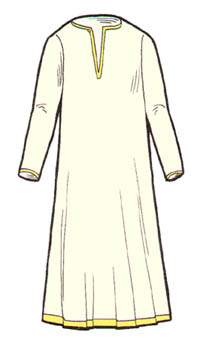
In the Orthodox Church the clergy vest in special clothing for the liturgical services. There are two fundamental Christian vestments, the first of which is the baptismal robe. This robe, which is worn by bishops and priests at the service of holy communion and which should always be white, is the “robe of salvation”: the white garment in which every Christian is clothed on his day of baptism, symbolizing the new humanity of Jesus and life in the Kingdom of God (Rev.7:9ff).

The second fundamental vestment for Christian clergy is the stole or epitrachelion which goes around the neck and shoulders. It is the sign of the pastoral office and was originally made of wool to symbolize the sheep – that is, the members of the flock of Christ – for whom the pastors are responsible. Both bishops and priests wear this vestment when they are exercising their pastoral office, witnessing to the fact that the ministers of the Church live and act solely for the members of Christ’s flock.

As the Church developed through history the vestments of the clergy grew more numerous. Special cuffs for deacons, priests, and bishops were added to keep the sleeves of the vestments out of the way of the celebrants during the divine services. When putting on their cuffs, the clergy read lines from the psalms reminding them that their hands belong to God.
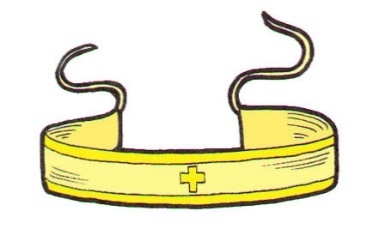
A special belt was added as well to hold the vestments in place. When putting on the belt the clergy say psalms which remind them that it is God who “girds them with strength” to fulfill their service. Only the bishops and priests wear the liturgical belt.
All orders of the clergy wear a special outer garment. Deacons, sub-deacons, and readers wear a robe called a sticharion. It is probably the baptismal garment, decorated and made more elaborate. Deacon and sub-deacons also wear a stole called the orarion, probably originally a piece of material upon which were inscribed the liturgical litanies and prayers (orare means to pray). The deacon still holds up the orarion in a position of prayer when he intones his parts of the divine services. The sub-deacon’s orarion is placed around his back in the sign of the cross.
Priests wear their white baptismal robe over which they have their pastoral stole, cuffs and belt. They also wear a large garment called a phelonion which covers their entire body in the back and goes below their waist in front. This vestment was probably developed from the formal garments of the early Christian era and, under the inspiration of the Bible, came to be identified with the calling of the priestly life. When putting on his phelonion, the priest says the lines of Psalm 132:
Thy priests, O Lord, shall clothe themselves in righteousness, and the saints shall rejoice with joy always now and ever and unto ages of ages. Amen.
The bishops traditionally probably also wore the phelonion over which they placed the omophorion, the sign of their episcopal office as leading pastor of the local church. When the Christian empire was captured by the Turks in the fifteenth century, however, the Christian bishops of the East were given civil rule over all Christians under Turkish domination. At that time, since there was no longer a Christian empire, the bishops adopted the imperial insignia and began to dress as the Christian civil rulers used to dress. Thus, they began to wear the sakkos, the imperial robe, and the mitre, the imperial crown. They also began to stand upon the orlets (the eagle) during the divine services and to carry the staff which symbolized more their secular power than their pastoral office. At that time as well, the word despota (vladyko or master) – a title for temporal rather than spiritual power – was used in addressing the bishops, and the clergy began to grow long hair which was also a sign of earthly rule in former times. In the seventeenth century, during the reform of Patriarch Nikon, the Russian Church adopted these same forms for its bishops.
In the Church some of these new insignia were “spiritualized” and given a Biblical meaning. Thus, the mitres became signs of Christian victory, for the saints receive their crowns and reign with Christ (Rev.4:4). The eagle became the sign of the flight to the heavenly Jerusalem since it is the classical Biblical symbol of Saint John and the fourth gospel (Rev.4:7; Ezek.1:10). The staff became the symbol of Aaron’s rod (Ex.4:2), and so on. It should be understood, however, that these particular insignia of the bishop’s office are of later and more accidental development in the Church.

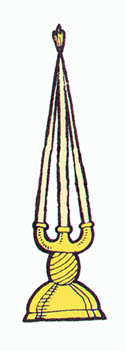
In relation to the bishop’s service in the Orthodox Church, the use of two special candelabra with which the bishop blesses the faithful also developed. One of these candelabra holds three candles (trikiri – on right) while the other holds two candles (dikiri – on left). These candelabra stand for the two fundamental mysteries of the Orthodox faith: that the Godhead is three Divine Persons; and that Jesus Christ, the Saviour, has two natures, being both perfect God and perfect man.
Bishops and priests in the Orthodox Church also wear other special garments. There are, first of all, two pieces of cloth: one square (nabedrennik) and one diamond-shaped (epigonation or palitsa). The former is worn only by priests as a sign of distinction, while the latter is always worn by bishops and is given to some priests as a special distinction of service. Probably these cloths were originally “liturgical towels.” Their symbolical meaning is that of spiritual strength: the sword of faith and the Word of God. They hang at the sides of their wearers during divine services.
There are also clerical hats which carry special meaning in some Orthodox Churches – the pointed hat (skufya) and the cylindrical one (kamilavka). The kamilavka is normally worn by all Greek priests, but only by some clergy in other national Orthodox churches as a special distinction. The kamilavka may be black or purple; monks, and by extansion all bishops, wear it with a black veil. The skufya is worn by monks and, in the Russian tradition, by some of the married clergy as a special distinction, in which case the hat is usually purple. Also in the Russian tradition certain married clergy are given the honor of wearing a mitre during liturgical services. In other Orthodox churches the mitre is reserved only for bishops and abbots of monasteries (archimandrites). Generally speaking, especially in the West, the use of clerical headwear is declining in the Orthodox Church.
Finally, it must be mentioned that bishops and priests wear the cross. The bishops also wear the image of Mary and the Child (panagia – the “all holy”). In the Russian tradition all priests wear the cross. In other churches it is worn liturgically only by those priests given the special right to do so as a sign of distinction.
As the various details of clerical vestments evolved through history, they became very complex and even somewhat exaggerated. The general trend in the Church today is toward simplification. We can almost certainly look forward to a continual evolution in Church vestments which will lead the Church to practices more in line with the original Christian biblical and sacramental inspiration.
The Orthodox Church is quite firm in its insistence that liturgical vesting is essential to normal liturgical worship, experienced as the realization of communion with the glorious Kingdom of God, a Kingdom which is yet to come but which is also already with us in the mystery of Christ’s Church.
Christian Symbols
The Orthodox Church abounds with the use of symbols. These symbols are those realities which have the power and competence of manifesting God to men, signs which carry us beyond ourselves and themselves into the genuine union and knowledge of things eternal and divine.
Among the Christian symbols we have already mentioned are the icons, the sign of the cross, and the vestments of liturgical celebration. In addition, we can mention the use of various colors which have their particular significance, as well as the use of light, normally the natural light of candles, which leads us to Christ, the Light of the world and of the Kingdom of God. Generally speaking, light is a universal symbol for the mystical presence of God as the True, the Beautiful and the Good. This is witnessed in almost all religions, philosophies, and artistic expressions.
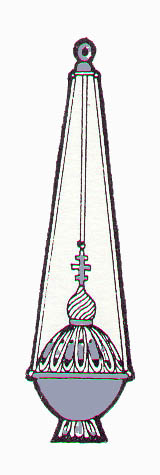
The Orthodox Church follows the Bible in its use of incense (Ex.30:8, Ps.141:2; Lk.1:9; Rev.8:3). Incense is the symbol of the rising of prayers, of spiritual sacrifice and of the sweet-smelling fragrance of the Kingdom of God.
The Church also uses bread, wine, wheat, oil, water, flowers and fruits as signs of God’s love, mercy, goodness, life and the very presence given to man in creation and salvation. Indeed, all elements of creation find the “truth” of their very being and existence as expressions and manifestations of God, as “symbols” of his presence and action in the world for man. This is the reason for their use in this way in the Church.

Among the more graphic Christian symbols in the Church are the initials and letters of Christ’s name; the triangle of the Trinity; the circle of eternity; the fish which stands for Jesus Christ, Son of God, Saviour; the eye of God’s omnipresence; the anchor of hope; the rock of faith; the flame of God’s consuming presence; the vine which Jesus named himself – “I am the vine, you are the branches” (Jn.15.5); the alpha and the omega (Rev.1.8); the crown and staff of Christ’s kingship; and many others – all of which indicate some aspect of the saving presence and action of God in the world.
The use of symbols is a mode of revelation and communion which passes beyond that of mere verbal or intellectual communication. The death of symbols comes when they are artificially invented, rationally explained, or reduced to mere “illustrations” whose meaning is not immediately grasped by man on the level of his living spiritual vision and experience.
The Sacraments
The sacraments in the Orthodox Church are officially called the “holy mysteries.” Usually seven sacraments are counted: baptism, chrismation (or confirmation), holy eucharist, penance, matrimony, holy orders and the unction of the sick.
The practice of counting the sacraments was adopted in the Orthodox Church from the Roman Catholics. It is not an ancient practice of the Church and, in many ways, it tends to be misleading since it appears that there are just seven specific rites which are “sacraments” and that all other aspects of the life of the Church are essentially different from these particular actions. The more ancient and traditional practice of the Orthodox Church is to consider everything which is in and of the Church as sacramental or mystical.
The Church may be defined as the new life in Christ. It is man’s life lived by the Holy Spirit in union with God. All aspects of the new life of the Church participate in the mystery of salvation. In Christ and the Holy Spirit everything which is sinful and dead becomes holy and alive by the power of God the Father. And so in Christ and the Holy Spirit everything in the Church becomes a sacrament, an element of the mystery of the Kingdom of God as it is already being experienced in the life of this world.
Viewing the Church as the new and eternal life of the Kingdom of God given to man by God through Jesus Christ in the Holy Spirit, we understand first of all that for life to exist there must be birth. The birth into the eternal life of God is the mystery of baptism. But birth is not enough for living; there must be the ongoing possibility of life: its power, energy and force. Thus, the mystery of chrismation is the gift of the power to live the life of Christ which is born in man by baptism. It is the gift of the “all-holy and good and life-creating Spirit” to man.
Life also must be sustained. This is normally done by eating and drinking. Food is the nourishment which keeps us alive. It is man’s communion with creation which keeps him existing. But, naturally speaking, our normal eating and drinking does not keep us alive forever. Our natural communion with the world is a communion to death. We need eating and drinking of a special food which nourishes us for eternal life. This food is the “mystical supper of the Son of God,” the body and blood of Christ, the mystery of the holy eucharist – the communion to Life Itself.
For life to be truly perfect, holy and good, there must also be a particular mystery about marriage and the bearing of children. In this world all who are born are born to die, and even the most perfect of human love stands under the condemnation: “. . . until death do you part.” The mystery of Christian marriage transforms human love, childbearing, and family communities into realities of eternal proportion and significance. In marriage we are blessed by God for unending friendship and love. We are blessed so that the fruit of our love, the begetting of our children and the life of our families will be not “unto death” but unto life everlasting.
Until the final establishment of the Kingdom of God, our life remains under the attack of its demonic enemies: sin, sickness, suffering, sorrow and death. The mystery of penance is the remedy for spiritual sickness. It allows us to turn again to God, to be taken back, to be forgiven and to be received once more into the life of God from which our sins have separated us. And the mystery of holy unction is the remedy for our physical sickness which is the power of sin over our bodies, our inevitable union with suffering and death. Holy unction allows us to be healed; to suffer, not “unto death” but, once more, unto life everlasting. It is the incorporation of our wounds into the life-creating cross of Christ.
The mystery, finally, which allows the perfection of divine life to be ours in all of its fullness and power in this world is the mystery of the Church itself. And most specifically within the Church, we have the mystery of holy orders: the sacrament of priesthood, ministry, teaching and pastoral care. The clergy of the church – bishops, priests, and deacons – exist for no other purpose than to make manifest, present and powerful in the Church the divine life of the Kingdom of God to all men while still living in this world.
Thus, from birth to death, in good times and bad, in every aspect of worldly existence, real life – life as God has created and saved and sanctified it to be – is given to us in the Church. This is Christ’s express purpose and wish, the very object of his coming to the world: “I came that they may have life, and have it abundantly” (Jn.10:10).
The Church as the gift of life eternal is by its very nature, in its fullness and entirety, a mystical and sacramental reality. It is the life of the Kingdom of God given already to those who believe. And thus, within the Church, everything we do – our prayers, blessings, good works, thoughts, actions – everything participates in the life which has no end. In this sense everything which is in the Church and of the Church is a sacrament of the Kingdom of God.
Baptism
The practice of baptism as a religious symbol did not begin with Jesus. Baptism, which means literally the immersion in water, was practiced among the people of the Old Testament as well as the people who belonged to pagan religions. The universal meaning of baptism is that of “starting anew,” of dying to an old, way of life and being born again into a new way of life. Thus, baptism was always connected with repentance which means a moral conversion, a “change of mind,” a change in living from something old and bad to something new and good.
Thus, in the Gospel we find John the Baptist baptizing the people as a sign of repentance in preparation for the Kingdom of God which was coming to men with Christ the Messiah. Christ himself was baptized by John not because he was sinful and needed to repent, but because in allowing himself to be baptized he showed that indeed he was God’s “Beloved Son,” the Saviour and Messiah, the “Lamb of God who takes upon himself the sins of the world” (See Mt.3, Mk.1, Lk.3, Jn.1–3).
In the Christian Church the practice of baptism takes on a new and particular significance. It no longer remains merely a sign of moral change and spiritual rebirth. It becomes very specifically the act of a person’s death and resurrection in and with Jesus. Christian baptism is man’s participation in the event of Easter. It is a “new birth by water and the Holy Spirit” into the Kingdom of God (Jn.3:5).
Baptism in the Church begins with the rejection of Satan and the acceptance of Christ. Before being baptized, a person – or his sponsors or godparents for him – officially proclaims the symbol of Christian faith, the Creed. Because the godparent speaks on behalf of the child, sponsors his entrance into the Church and “receives” the child out of the baptismal waters into the Church and cares for his spiritual life, the godparent himself must be a member of the Church.
After the proclamation of faith, the baptismal water is prayed over and blessed as the sign of the goodness of God’s creation. The person to be baptized is also prayed over and blessed with sanctified oil as the sign that his creation by God is holy and good. And then, after the solemn proclamation of “Alleluia” (from Hebrew, meaning “God be praised”), the person is immersed three times in the water in the name of the Father, the Son and the Holy Spirit.
Through the act of immersion, the baptized person dies to this world and is born again in the resurrection of Christ into eternal life. He is clothed with the “garments of salvation” symbolized by the white baptismal robe which is the “new humanity” of Jesus himself who is the new and heavenly Adam (See Jn.3, Rom.5, 1Cor.15). Thus, the words of the Apostle Paul are chanted as the newly-baptized is led in procession around the baptismal font three times as the symbol of his procession to the Kingdom of God and his entrance into eternal life: “For as many as have been baptized into Christ have put on Christ. Alleluia” (Gal.3:27).
In ancient times this procession was made from the baptistery to the church where the newly-baptized received Holy Communion at the celebration of the Divine Liturgy. Baptisms were normally done in connection with the Easter Liturgy; our present procession around the church building on Easter night is nothing more than our remembrance that we are baptized, that we have left the life of this world to enter the eternal life of the Risen Christ in the Kingdom of God. This new life is given to us in the life of the Church, most specifically in the Divine Liturgy.
Before the baptismal procession and the reading of the Epistle and the Gospel is fulfilled in the reception of Holy Communion, however, the newly-baptized is given the gift of the Holy Spirit in the sacrament of Chrismation.
Chrismation
In the sacrament of Chrismation we receive “the seal of the gift of the Holy Spirit” (See Rom.8, 1Cor.6, 2Cor.1:21–22). If baptism is our personal participation in Easter – the death and resurrection of Christ, then chrismation is our personal participation in Pentecost – the coming of the Holy Spirit upon us.
The sacrament of chrismation, also called confirmation, is always done in the Orthodox Church together with baptism. Just as Easter has no meaning for the world without Pentecost, so baptism has no meaning for the Christian without chrismation. In this understanding and practice, the Orthodox Church differs from the Roman Catholic and Protestant churches where the two sacraments are often separated and given other interpretations than those found in traditional Orthodoxy.
Chrismation, the gift of the Holy Spirit, is performed in the Orthodox Church by anointing all parts of the person’s body with the special oil called holy chrism. This oil, also called myrrh is prepared by the bishops of the Church on Holy Thursday. It is used in chrismation to show that the gift of the Spirit was originally given to men through the apostles of Christ, whose formal successors in the world are the bishops of the Church (see Acts.8:14, 19:1–7).
In chrismation a person is given the “power from on high” (Acts.1–2), the gift of the Spirit of God, in order to live the new life received in baptism. He is anointed, just as Christ the Messiah is the Anointed One of God. He becomes – as the fathers of the Church dared to put it – a “christ” together with Jesus. Thus, through chrismation we become a “christ,” a son of God, a person upon whom the Holy Spirit dwells, a person in whom the Holy Spirit lives and acts – as long as we want him and cooperate with his powerful and holy inspiration.
Thus, it is only after our chrismation that the baptismal procession is made and that we hear the epistle and the gospel of our salvation and illumination in Christ.
After the baptism and chrismation the person newly-received into God’s family is tonsured. The tonsure, which is the cutting of hair from the head in the sign of the cross, is the sign that the person completely offers himself to God – hair being the symbol of strength (Jud.16:17). Thus, until the fifteenth century the clergy of the Orthodox Church – the “professional Christians,” so to speak – wore the tonsure all their lives to show that their strength was in God.
The Rite of Churching
Together with being baptized and chrismated, the new-born child is also “churched.” The rite of churching imitates the offering of male children to the temple according to the law of the Old Testament, particularly the offering of Christ on the fortieth day after his birth (Lk.2:22). Because of this fact, baptism in the Orthodox tradition came to be prescribed for. the fortieth day or thereabouts. In the New Testament Church both male and female children are formally presented to God in the Church with special prayers at this time.
Also at this time, once more in imitation of Old Testament practice, the mother of the new-born child is also “churched.” Here we have the specific example of the purification ritual of Jesus’ mother Mary (Lk.2:22). In the Orthodox tradition the churching of the mother is her re-entry into the assembly of God’s people after her participation with God in the holy act of birth and after her separation from the Liturgy during her confinement. Thus, the mother is blessed to enter once more into communion with the mystery of Christ’s Body and Blood in the Divine Liturgy of the Church from which she has been necessarily absent.
The new mother should be churched before the baptism of her infant so that she can be present at the sacramental entrance of her child into the Kingdom of Christ. The official service book indicates that this should be done.
It is also the Orthodox tradition that the mysteries of baptism and chrismation, called officially “holy illumination,” are fulfilled in the immediate reception by the “newly-enlightened” of Holy Communion in the eucharistic liturgy of the Church. This is the case with infants as well as adults.
The Epistle of Baptism-Chrismation
Do you not know that all of us who have been baptized into Christ Jesus were baptized into His death? We were buried therefore with Him by baptism into death, so that as Christ was raised from the dead by the glory of the Father, we too might walk in newness of life. For if we have been united with Him in a death like his, we shall certainly be united with Him in a resurrection like His. We know that our old self was crucified with Him so that the sinful body might be destroyed, and we might no longer be enslaved to sin. For He who has died is freed from sin. But if we have died with Christ, we believe that we shall also live with Him. For we know that Christ being raised from the dead will never die again; death no longer has dominion over Him. The death He died he died to sin, once for all, but the life He lives he lives to God. So you also must consider yourselves dead to sin and alive to God in Christ Jesus. (Rom.6:3–11)
The Gospel of Baptism-Chrismation
Now the eleven disciples went to Galilee, to the mountain to which Jesus had directed them. And when they saw him they worshipped him; but some doubted. And Jesus came and said to them, “All authority in heaven and on earth has been given to Me. Go therefore and make disciples of all nations, baptizing them in the name of the Father and of the Son and of the Holy Spirit, teaching them to observe all that I have commanded you; and lo, I am with you always, to the close of the age.” (Mt.28:16–20)
Holy Eucharist
The Holy Eucharist is called the “sacrament of sacraments” in the Orthodox tradition. It is also called the “sacrament of the Church.” The eucharist is the center of the Church’s life. Everything in the Church leads to the eucharist, and all things flow from it. It is the completion of all of the Church’s sacraments – the source and the goal of all of the Church’s doctrines and institutions.
As with baptism, it must be noted that the eucharistic meal was not invented by Christ. Such holy ritual meals existed in the Old Testament and in pagan religions. Generally speaking the “dinner” remains even today as one of the main ritual and symbolic events in the life of man.
The Christian eucharist is a meal specifically connected with the Passover meal of the Old Testament. At the end of his life Christ, the Jewish Messiah, ate the Passover meal with his disciples. Originally a ritual supper in commemoration of the liberation of the Israelites from slavery in Egypt, the Passover meal was transformed by Christ into an act done in remembrance of him: of His life, death and resurrection as the new and eternal Passover Lamb who frees men from the slavery of evil, ignorance and death and transfers them into the everlasting life of the Kingdom of God.
At the supper Christ took the bread and the wine and ordered his disciples to eat and drink it as his own Body and Blood. This action thus became the center of the Christian life, the experience of the presence of the Risen Christ in the midst of his People (see Mt.26; Mk.14; Lk.22; Jn.6 and 13; Acts.2:41–47; 1Cor.10–11).
As a word, the term eucharist means thanksgiving. This name is given to the sacred meal-not only to the elements of bread and wine, but to the whole act of gathering, praying, reading the Holy Scriptures and proclaiming God’s Word, remembering Christ and eating and drinking his Body and Blood in communion with him and with God the Father, by the Holy Spirit. The word eucharist is used because the all-embracing meaning of the Lord’s Banquet is that of thanksgiving to God in Christ and the Holy Spirit for all that he has done in making, saving and glorifying the world.
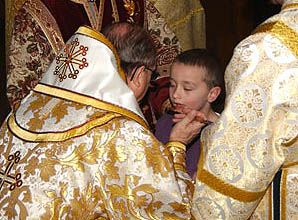
The sacrament of the eucharist is also called holy communion since it is the mystical communion of men with God, with each other, and with all men and all things in him through Christ and the Spirit. The eucharistic liturgy is celebrated in the Church every Sunday, the Day of the Lord, as well as on feast days. Except in monasteries, it is rarely celebrated daily. Holy Communion is forbidden to all Orthodox Christians on the week days of Great Lent except in the special communion of the Liturgy of the Pre-sanctified Gifts (see below) because of its joyful and resurrectional character. The eucharist is always given to all members of the Church, including infants who are baptized and confirmed. It is always given in both forms – bread and wine. It is strictly understood as being the real presence of Christ, His true Body and Blood mystically present in the bread and wine which are offered to the Father in his name and consecrated by the divine Spirit of God.
In the history of Christian thought, various ways were developed to try to explain how the bread and the wine become the Body and Blood of Christ in the eucharistic liturgy. Quite unfortunately, these explanations often became too rationalistic and too closely connected with certain human philosophies.
One of the most unfortunate developments took place when men began to debate the reality of Christ’s Body and Blood in the eucharist. While some said that the eucharistic gifts of bread and wine were the real Body and Blood of Christ, others said that the gifts were not real, but merely the symbolic or mystical presence of the Body and Blood. The tragedy in both of these approaches is that what is real came to be opposed to what is symbolic or mystical.
The Orthodox Church denies the doctrine that the Body and the Blood of the eucharist are merely intellectual or psychological symbols of Christ’s Body and Blood. If this doctrine were true, when the liturgy is celebrated and holy communion is given, the people would be called merely to think about Jesus and to commune with him “in their hearts.” In this way, the eucharist would be reduced to a simple memorial meal of the Lord’s last supper, and the union with God through its reception would come only on the level of thought or psychological recollection.
On the other hand, however, the Orthodox tradition does use the term “symbols” for the eucharistic gifts. It calls, the service a “mystery” and the sacrifice of the liturgy a “spiritual and bloodless sacrifice.” These terms are used by the holy fathers and the liturgy itself.
The Orthodox Church uses such expressions because in Orthodoxy what is real is not opposed to what is symbolical or mystical or spiritual. On the contrary! In the Orthodox view, all of reality – the world and man himself – is real to the extent that it is symbolical and mystical, to the extent that reality itself must reveal and manifest God to us. Thus, the eucharist in the Orthodox Church is understood to be the genuine Body and Blood of Christ precisely because bread and wine are the mysteries and symbols of God’s true and genuine presence and manifestation to us in Christ. Thus, by eating and drinking the bread and wine which are mystically consecrated by the Holy Spirit, we have genuine communion with God through Christ who is himself “the bread of life” (Jn.6:34, 41).
I am the living bread which came down from heaven; if anyone eats of this bread, he will live forever; and the bread which I shall give for the life of the world is my flesh (Jn.6:51).
Thus, the bread of the eucharist is Christ’s flesh, and Christ’s flesh is the eucharistic bread. The two are brought together into one. The word “symbolical” in Orthodox terminology means exactly this: “to bring together into one.”
Thus we read the words of the Apostle Paul:
For I received from the Lord what I also delivered to you, that the Lord Jesus on the night when He was betrayed took bread, and when He had given thanks, He broke it, and said, “This is My body which is broken for you. Do this in remembrance of Me.” In the same way also the cup, after supper, saying, “This cup is the new covenant in My blood. Do this, as you drink it, in remembrance of Me.” For as often as you eat this bread and drink this cup, you proclaim the Lord’s death, until He comes. Whoever, therefore, eats the bread and drinks the cup in an unworthy manner will be guilty of profaning the body and blood of the Lord (1Cor.11:23–26).
The mystery of the holy eucharist defies analysis and explanation in purely rational and logical terms. For the eucharist – and Christ Himself – is indeed a mystery of the Kingdom of Heaven which, as Jesus has told us, is “not of this world.” The eucharist – because it belongs to God’s Kingdom – is truly free from the earth-born “logic” of fallen humanity.
Penance
The sacrament of penance is our formal act of reconciliation with God in the Church when sin has severed us from the Church’s life. Because penance is the way to communion with God when that communion has been broken by sin, it is often referred to in Church Tradition as the renewal of baptism, or as the reestablishment of that condition of life with God which was given to men in the basic sacraments of inauguration into the Christian life.
Not every sin requires the necessity of formal penance through sacramental ritual. This is obvious because Christians are never completely without sin. Certain grave sins or the prolonged separation from Holy Communion, however, do call for the act of sacramental penance. Also, Christians living in communion with Christ are expected to make use of this sacrament periodically in order to humble themselves consciously before God and to receive guidance in the Christian life from their pastor in the Church. It is the teaching of the Orthodox Church that sacramental penance is necessary for those receiving Holy Communion when they have committed grave sins or when they have been separated from the eucharistic meal for a long time.
The sacrament of penance exists in the Church to allow for the repentance and reconversion of Christians who have fallen away from the life of faith. There are three main elements to the act of formal penance. The first is a sincere sorrow for sins and for the breaking of communion with God. The second is an open and heartfelt confession of sins. At one time this confession was done publicly before all men in the midst of the Church, but in recent times it is usually done only in the presence of the pastor of the Church who stands in behalf of all. The third element of penance is the formal prayer of absolution through which the forgiveness of God through Christ is sacramentally bestowed upon the repentant sinner.
The fulfillment of penance consists in the reception of Holy Communion and the genuine reconciliation of the repentant sinner with God and all men according to the commandments of Christ. From this there obviously follows the necessity of a sincere attempt by the penitent to refrain from sin and to remain in faithful obedience to God and in uprightness of life before Him and all people.
The sacrament of penance, like all sacraments, is an element of the life of the Church which presupposes a firm belief and conviction that Christ himself is present in the Church through his Holy Spirit. A person without the experience of Christ in the Church will not understand the meaning of sacramental penance and the need for the open and public confession of sins. When the Church is experienced as the new life in Christ and as the genuine communion with God in his kingdom already present with men in sacrament and mystery, then not only will sacramental penance and the confession of sins be understood, but it will be cherished as the great mystery of God which it is: the unique possibility for reunion with God through the forgiveness of Christ who has come to save sinners who confess their sins and who sincerely desire to change their lives according to the ways which he himself has given.
In a word, the Orthodox Church strictly adheres to the teaching of the Bible that only God can forgive sins, that he does so through Christ in the Church, that his conditions are genuine repentance and the promise of change which are witnessed by confession; and that confession, by definition, is the open and public acknowledgment of sin before God and all mankind.
Holy Unction
Christ came to the world to “bear the infirmities” of men. One of the signs of his divine messiahship was to heal the sick. The power of healing remains in the Church since Christ himself remains in the Church through the Holy Spirit.
The sacrament of the unction of the sick is the Church’s specific prayer for healing. If the faith of the believers is strong enough, and if it is the will of God, there is every reason to believe that the Lord can heal those who are diseased.
Is any among you sick, let him call for the presbyters of the church, and let them pray over him, anointing him with oil in the name of the Lord; and the prayer of faith will save the sick man, and the Lord will raise him up; and if he has committed sins, he will be forgiven. Therefore, confess your sins to one another and pray for one another, that you may be healed (Jas.5:14–16; see also Mk.6:13).
The sacrament of anointing is a “sobornal” sacrament in the traditional Orthodox practice. This means that as many of the faithful as possible are gathered to participate in the prayers. The rite itself calls for seven priests, seven readings from the epistles and gospels, seven prayers and seven anointings with oil specifically blessed for the service. Although it is not always possible to perform the sacrament in this way, the normal procedure is still to gather together as many priests and people as possible.
The express purpose of the sacrament of holy unction is healing and forgiveness. Since it is not always the will of God that there should be physical healing, the prayer of Christ that God’s will be done always remains as the proper context of the sacrament. In addition, it is the clear intention of the sacrament that through the anointing of the sick body the sufferings of the person should be sanctified and united to the sufferings of Christ. In this way, the wounds of the flesh are consecrated, and strength is given that the suffering of the diseased person may not be unto the death of his soul, but for eternal salvation in the resurrection and life of the Kingdom of God.
It is indeed the case that death inevitably comes to man. All must die, even those who in this life are given a reprieve through healing in order to have more time on the earth. Thus, the healing of the sick is not itself a final goal, but is merely “instrumental” in that it is given by God as a sign of his mercy and as a grace for the further opportunity of man to live for him and for others in the life of this world.
In the case where a person is obviously in the final moments of his earthly life, the Church has special prayers for the “separation of soul and body.” Thus, it is clear that the sacrament of holy unction is for the sick-both the physically and mentally sick-and is not reserved for the moment of death. The sacrament of unction is not the “last rites” as is sometimes thought; the ritual of the anointing itself in no way indicates that it should be administered merely in “extreme” cases. Holy unction is the sacrament of the spiritual, physical, and mental healing of a sick person whatever the nature or the gravity of the illness may be.
Marriage

The Wedding at Cana
Marriage was not invented or instituted by Christ. The Lord, however, gave a very specific meaning and significance to human marriage. Following the Old Testament Law, but going beyond its formal precepts in His messianic perfection, Jesus taught the uniqueness of human marriage as the most perfect natural expression of God’s love for men, and of his own love for the Church.
According to Christ, in order for the love of a man and woman to be that which God has: perfectly created it to be, it must be unique, indestructible, unending and divine. The Lord himself has not only given this teaching, but he also gives the power to fulfill it in the sacrament of Christian marriage in the Church.
In the sacrament of marriage, a man and a woman are given the possibility to become one spirit and one flesh in a way which no human love can provide by itself. In Christian marriage the Holy Spirit is given so that what is begun on earth does not “part in death” but is fulfilled and continues most perfectly in the Kingdom of God.
For centuries there was no particular ritual for marriage in the Church. The two Christians expressed their mutual love in the Church and received the blessing of God upon their union which was sealed in the holy eucharist of Christ. Through the Church’s formal recognition of the couple’s unity, and its incorporation into the Body of Christ, the marriage became Christian; that is, it became the created image of the divine love of God which is eternal, unique, indivisible and unending.
When a special ritual was developed in the Church for the sacrament of marriage, it was patterned after the sacrament of baptism-
chrismation. The couple is addressed in a way similar to that of the individual in baptism. They confess their faith and their love of God. They are led into the Church in procession.
They are prayed over and blessed. They listen to God’s Word. They are crowned with the crowns of God’s glory to be his children and witnesses (martyrs) in this world, and heirs of the everlasting life of his Kingdom. They fulfill their marriage, as all sacraments are fulfilled, by their reception together of holy communion in the Church.
There is no “legalism” in the Orthodox sacrament of marriage. It is not a juridical contract. It contains no vows or oaths. It is, in essence, the “baptizing and confirming” of human love in God by Christ in the Holy Spirit. It is the deification of human love in the divine perfection and unity of the eternal Kingdom of God as revealed and given to man in the Church.
The Christian sacrament of marriage is obviously available only to those who belong to the Church; that is, only for baptized communicants. This remains the strict teaching and practice of the Orthodox Church today. Because of the tragedy of Christian disunity, however, an Orthodox may be married in the Church with a baptized non-Orthodox Christian on the condition that both members of the marriage sincerely work and pray for their full unity in Christ, without any coercion or forceful domination by either one over the other. An Orthodox Christian who enters the married state with a non-Orthodox Christian must have the sacramental prayers and blessings of the Church in order to remain a member of the Orthodox Church and a participant in the sacrament of holy communion.
According to the Orthodox teaching, only one marriage can contain the perfect meaning and significance which Christ has given to this reality. Thus, the Orthodox Christian tradition encourages widows and widowers to remain faithful to their spouses who are dead to this world but alive in Christ. The Orthodox tradition also, by the same principle, considers temporary “living together,” casual sexual relations, sexual relations with many different people, sexual relations between members of the same sex, and the breakdown of marriages in separation and divorce, all as contrary to the human perfection revealed by God in Christ. Through penance, however, and with the sincere confession of sins and the genuine promise of a good life together, the Orthodox Church does have a service of second marriage for those who have not been able to fulfill the ideal conditions of marriage as taught by Christ. It is the practice of the Church as well not to exclude members of second marriages from the sacrament of holy communion if they desire sincerely to be in eucharistic fellowship with God, and if they fulfill all other conditions for participation in the life of the Church.
Because of the realization of the need for Christ in every aspect of human life, and because, as well, it is the firm Christian conviction that nothing should, or even can, be done perfectly without Christ or without his presence and power in the Church by the Holy Spirit, two Christians cannot begin to live together and to share each other’s life in total unity – spiritually, physically, intellectually, socially, economically – without first placing that unity into the eternity of the Kingdom of God through the sacrament of marriage in the Church.
According to the Orthodox teaching as expressed in the sacramental rite of marriage, the creation of children, and the care and love for them within the context of the family, is the normal fulfillment of the love of a man and woman in Christ. In this way, marriage is the human expression of the creative and caring love of God, the perfect Love of the Three Persons of the Holy Trinity which overflows in the creation and care for the world.
This conviction that human love, imitative of divine love, should overflow itself in the creation and care for others does not mean that the procreation of children is in itself the sole purpose of marriage and the unique and exclusive justification and legitimization of its existence. Neither does it mean that a childless couple cannot live a truly Christian life together. It does mean, however, that the conscious choice by a married couple not to have a family for reasons of personal comfort and accommodation, the desire for luxury and freedom, the fear of responsibility, the refusal of sharing material possessions, the hatred of children, etc., is not Christian, and can in no way be considered as consonant with the biblical, moral and sacramental teachings and experience of the Orthodox Church about the meaning of life, love and marriage.
In light of the perspective offered above, the control of the conception of children in marriage is a very delicate matter, discouraged in principle and considered as perhaps possible only with the most careful examination of conscience, prayer and pastoral guidance.
The abortion of a child already conceived is strictly forbidden in the Orthodox Church, and cannot be justified in any way, except perhaps with the greatest moral risk and with the most serious penitence in the most extreme cases such as that of irreparable damage to the mother or her probable death in the act of childbirth. In such extreme situations, the mother alone must take upon herself the decision, and all must be prepared to stand before God for the action, asking His divine mercy.
Holy Orders
It is the conviction of the Orthodox that Christ is the only priest, pastor and teacher of the Christian Church. He alone guides and rules his people. He alone forgives sins and offers communion with God, his Father.
It is also the Orthodox conviction that Christ has not abandoned his people, but that he remains with his Church as its living and unique head. Christ remains present and active in the Church through his Holy Spirit.
The sacrament of holy orders in the Christian Church is the objective guarantee of the perpetual presence of Christ with his people. The bishops, priests, and deacons of the Church have no other function or service than to manifest the presence and action of Christ to his people. In this sense, the clergy do not act in behalf of Christ or instead of Christ as though he himself were absent. They are neither vicars of Christ, nor substitutes for Christ nor representatives of Christ.
Christ is present now, always, and forever in his Church. The sacramental ministry of the Church – the bishops, priests, and deacons – receive the gift of the Holy Spirit to manifest Christ in the Spirit to men. Thus, through His chosen ministers, Christ exercises and realizes His unique and exclusive function as priest, perpetually offering Himself as the perfect sacrifice to the Father on behalf of His human brothers and sisters. Through His ministers in the Church, Christ also acts as teacher, Himself proclaiming the divine words of the Father to men. He acts as the good shepherd, the one pastor who guides His flock. He acts as the forgiver and healer, remitting sins and curing the ills of men – physical, mental and spiritual. He acts as bishop, overseeing the community which He has gathered for Himself (1Pet.2:25). He acts as deacon (which means servant or minister) for He alone is the suffering servant of the Father Who has come “not to be served, but to serve, and to give His life as a ransom for many” (Mt.20:28).
The sacrament of holy orders takes its name from the fact that the bishops, priests and deacons give order to the Church. They guarantee the continuity and unity of the Church from age to age and from place to place from the time of Christ and the apostles until the establishment of God’s Kingdom in eternity.
As the apostles received the special gift of God to go forth and to make Christ present to men in all of the manifold aspects of his person and work, so the clergy of the Church receive the gift of God’s Spirit to maintain and to manifest Christ’s presence and action in the churches.
It is the doctrine of the Church that the clergy must strive to fulfill the grace given to them with the gift of the “laying on of hands” in the most perfect way possible. But it is also the doctrine of the Church that the reality and effectiveness of the sacraments of the Church ministered by the clergy do not depend upon the personal virtue of the ministers, but upon the presence of Christ who acts in his Church by the Holy Spirit.
Bishops
The bishops are the leading members of the clergy in the sense that they have the responsibility and the service of maintaining the unity of the Church throughout the world by insuring the truth and unity of the faith. and practice of their respective churches with all of the others. Thus, the bishops represent their particular churches or dioceses to the other churches or dioceses, just as they represent the Universal Church to their own particular priests, deacons, and people.
In the Orthodox Church, the office of bishop is the leading Church ministry. The word bishop (episkopos, in Greek) means overseer. Each of the bishops has exactly the same service to perform. No bishop is “over any other bishop in the Church” and, indeed, the bishop himself is not “over” his church, hut is himself within and of the Church as one of its members. He is the one who is responsible and answerable before God and man for the life of his particular church community.
All bishops of the Orthodox Church are bishops of a particular geographical territory called a diocese. They usually receive their title from the main city in the territory. A bishop of the chief city of a region which has within it other bishops with their own particular dioceses is usually called the metropolitan or archbishop. “Metropolitan” merely means “bishop of the metropolis,” the main city. The title of archbishop means “leading bishop” of an area, but sometimes the title is given to certain bishops for personal or honorary reasons. The title of patriarch belongs to the bishop of the capitol city of a region containing other metropolitanates and dioceses. Today this usually means a national church.
When the bishops of an area meet in council, as they must do periodically according to Church Law, the metropolitan presides; or in the case of a large territory or national church, the patriarch. Once again, however, it must be clearly understood that sacramentally all bishops are identical and equal. None is “higher” than the others as far as their sacramental position is concerned; none is “over” the others as far as their life in the Church is concerned.
In purely human and practical matters, the metropolitans and patriarchs guide and preside over areas greater than their own particular dioceses, but they are not superior or more powerful as far as their bishop’s office is concerned. No bishop in Orthodoxy is considered infallible. None has any “powers” over or apart from his priests, deacons and people or the other bishops. All are servants of Christ and the Church.
Since the sixth century it has been the rule in the Orthodox Church that the bishops be single men or widowers. They are also usually in at least the first degree of monastic orders.
Priests
The priests of the Church, also called presbyters, are those who assist the bishop in his work. In the present day, the priests normally exercise the function of pastors of the local churches or parishes, a function which was normally done by the bishops in early times. The priests head the local congregations of Christians. They preside at the celebration of the liturgy. They teach, preach, counsel and exercise the ministries of forgiveness and healing.
The priests in the Church are assigned by the bishop and belong to the specific congregations which they serve. No one receives the gift of the priesthood personally or individually. Apart from his bishop and his own particular parish community, the priest has no “powers” and, indeed, no services to perform. Thus, on the altar table of each Christian community headed by the priest as pastor, there is the cloth called the antimension signed by the bishop which is the permission to the community to gather and to act as the Church of God. Without the antimension, the priest and his people cannot function legitimately, and the actions of the assembly cannot be considered as being authentically “of the Church.”
In the Orthodox Church a married man may be ordained to the priesthood. His marriage, however, must be the first for both him and his wife, and he may not remarry and continue in his ministry if his wife should die. If a single man is ordained, he may not marry and retain his service.
Deacons
The deacons of the Church originally assisted the bishops in good deeds and works of charity. In recent centuries the diaconate has become almost exclusively a liturgical function in which the deacons assist at the celebration of the divine liturgy and other Church services. In more recent times, the diaconate has been extended to many as a permanent position for full or part-time service to the work of the Church. In the office of deacon, the men may now not only assist the priest and bishop in liturgical services, but will often head educational programs and youth groups, do hospital visitation and missionary work and conduct projects of social welfare. In these cases the deacons are not necessarily taken from the professional schools of theology, but are chosen directly from the local parish community. The Church’s rules about marriage are the same for the deacons as they are for the priests.
In addition to the bishops, priests and deacons who comprise the central ordained ministries in the Church, the Orthodox tradition also has special blessings for the particular ministries of sub-deacons and readers. In the early church there were also special prayers and blessings for other Church ministries such as exorcists, doorkeepers, deaconesses, and lay-preachers; the latter still function in some churches today. Also in most churches today there are special ceremonies of blessing and installation of lay workers in the Church such as members of the parish council, catechists, choir singers and leaders of various organizations and projects.
Funeral
The funeral service in the Orthodox Church, although not considered as specifically sacramental, belongs among the special liturgical rites of the People of God.
We have already seen that the Church has a particular sacramental service for the consecration of human suffering, and special prayers for the departure of the soul from the body in death. When a person dies, the Church serves a special vigil over the lifeless body, called traditionally the parastasis or panikhida, both of which mean a “watch” or an “all-night vigil.”
The funeral vigil has the basic form of Matins. It begins with the normal Trisagion Prayers and the chanting of Psalm 91, followed by the special Great Litany for the dead. Alleluia replaces God is the Lord, as in Great Lent, and leads into the singing of the funeral troparion.
The troparion and the kontakion of the dead, as all hymns of the funeral vigil, meditate on the tragedy of death and the mercy of God, and petition eternal life for the person who is “fallen asleep.”
Thou only Creator Who with wisdom profound mercifully orderest all things, and givest unto all that which is useful, give rest, O Lord, to the soul of Thy servant who has fallen asleep, for he has placed his trust in Thee, our Maker and Fashioner and our God (Troparion).
With the saints give rest, O Christ, to the soul of Thy servant where sickness and sorrow are no more, neither sighing, but life everlasting (Kontakion).
Psalm 119, the verbal icon of the righteous man who has total trust in God and total devotion and love for his Divine Law – the verbal icon of Jesus Christ – is chanted over the departed, with its praises and supplications for life in God. It is this same psalm which is chanted over the tomb of Christ on Great Friday.
It is the psalm which sings of the victory of righteousness and life over wickedness and death.
My soul cleaves to the dust, give me life according to Thy word (119:25).
Turn my eyes from looking at vanities; and give me life in Thy ways (119:37).
Behold, I long for Thy precepts; in Thy righteousness give me life (119:40).
Thy testimonies are righteousness forever; give me understanding that I may live (119:144).
Plead my cause, and redeem me; give me life according to Thy promise (119:154).
This entire psalm together with the verses and prayers that go with it, the canon hymns of the service, and the special funeral songs of Saint John of Damascus all are a meditation on life and death. They are, in the context of the new life of the Risen Christ who reigns in the Church, a lesson of serious instruction for those who are immune to the full tragedy of sin and its “wages” which are death.
Sometimes men criticize the funeral vigil for its supposed morbidity and gloom; they say that there should be more words of resurrection and life. Yet the vigil itself is not the Church’s “final word” about death. It is simply the solemn contemplation upon death’s tragic character, its horrid reality and its power as that of sin and alienation from God. The realization of these facts, which particularly in the modern age is so strikingly absent, is the absolute condition for the full appreciation and celebration of the victorious resurrection of Christ and his gracious gift of eternal life to mankind. Without such a preparatory meditation on death, it is doubtful whether the Christian Gospel of Life can be understandable at all.
Thus it is not at all ironic that the same Saint John of Damascus who wrote the joyful canon sung by the Church on Easter Night is also the author of the Church’s songs of death, which are indeed unyielding in their gravity and uncompromising in their bluntness and realism about the inevitable fact of the final fate of fallen human existence.
What earthly sweetness remains unmixed with grief? What glory stands immutable on the earth? All things are but feeble shadows, all things are most deluding dreams, yet one moment only, and death shall supplant them all. But in the light of Thy countenance, O Christ, and in the sweetness of Thy beauty, give rest to him whom Thou hast chosen, for as much as Thou lovest mankind.
I weep and lament when I think upon death, and behold our beauty created in the likeness of God lying in the tomb disfigured, bereft of glory and form. O the marvel of it! What is this mystery concerning us? Why have we been delivered to corruption? Why have we been wedded unto death? Truly, as it is written, by the command of God Who giveth the departed rest (Funeral Hymns).
As the funeral service is now nornally served, the Beatitudes are chanted after the canon and the hymns of Saint John, with prayer verses inserted between them on behalf of the dead. The epistle reading is from First Thessalonians (4:13–17). The gospel reading is from Saint John (5:24–30). A sermon is preached and the people are dismissed after giving their “final kiss” with the singing of the final funeral song: Eternal Memory.
It has to be noted here that this song, contrary to the common understanding of it, is the supplication that God would remember the dead, for in the Bible it is God’s “eternal memory” which keeps man alive. Sheol or Hades or the Pit, the biblical realm of the dead also called Abaddon, is the condition of forsakenness and forgottenness by God. It is the situation of non-life since in such a condition no one can praise the Lord; and the praise of the Lord is the only content and purpose of man’s life; it is the very reason for his existence. Thus, this most famous and final of the Orthodox funeral hymns is the prayer that the departed be eternally alive in the “eternal rest” of the “eternal memory” of God – all of which is made possible and actual by the resurrection of Jesus Christ which is the destruction of the Pit of Death by the splendor of Divine Righteousness and Life (see Ps.88; Hos.13:14; 1Cor.15; Eph.4:9; Phil.2:5–11; 1Pet.3).
The vigil of the dead should normally be fulfilled in the eucharistic liturgy in which the faithful meet the Risen Lord, and all those who are alive in him, in the glory of his Kingdom of Life. The fact that the funeral vigil, in recent years, has lost its preparatory character and has simply been transformed into the funeral service itself, separated from the eucharistic liturgy, is a sad fact which allows neither for the proper appreciation of the vigil itself nor for the full Christian vision of the meaning of life, death and resurrection in Christ, the Church and the Kingdom of God.
The fact that the Divine Liturgy, when it is preserved with the funeral vigil, is served before it and is made into something mournful, converted into a “requiem mass” offered “on behalf of the dead,” is also an innovation of recent centuries under old Roman Catholic influence which further distorts the Christian understanding and experience of death in Christ.
Monasticism

Although not considered as one of the sacraments of the Church since it is not essential to the Christian life as such and is not a necessary element for the very existence of God’s People, monasticism has played an important role in Christian history and is highly valued by the Orthodox Church.
In the Orthodox Tradition the monastic calling is considered to be a personal gift of God to the individual soul for his salvation and service to the Body of Christ. The monastic vocation is the calling to personal repentance in a life dedicated solely to God. The ultimate Christian virtue of love is sought by the monk or nun primarily through prayer and fasting, and through the exercise of the Christian virtues of poverty, chastity, humility and obedience.
The monastic Christian does not normally exercise any particular ministry in the Church such as that of priest, pastor, teacher, nurse or social worker. The monk is normally a layman and not a cleric, with each monastery having only enough clergy to care for the liturgical and sacramental needs of the community itself.
In Orthodox Christian history many missionaries, teachers and bishops have come from men with monastic vocations. For centuries the bishops have been traditionally selected from among the monks. These additional callings, however, are considered to be acts of God’s will expressed in his people, and are not the purpose or intention of the monastic vocation as such. Indeed, one must enter a monastery only in order to repent of his sins, to serve God and to save his soul according to the ideals of monastic ascetism. The ceremony of monastic profession indicates this very clearly. Thus, for example, Saint Herman of Alaska was first dedicated to the monastic life, and only then, in obedience to his spiritual father, left his solitude to become a great missionary.
The Monastic Ranks
The Orthodox monastic tradition has four classical ranks that apply equally to men and to women. The first step is that of novice, which in church terminology is called the rank of obedience. At this first stage the candidate for monastic profession simply lives in the monastery under the direction of a spiritual father or mother.
The second step is that of riasa-bearer, which means that the person is more formally accepted into the community, and is given the right to wear the monastic robe, called the riasa. At this stage the candidate is not yet fully committed to the monastic life.
The third rank is that of the small schema which means that the person is a professed monastic. He or she now receives a new name and wears the monastic schema (a cloth with the sign of the cross), the veil and the mantle (mantia). At this stage the person pledges to remain in the monastic community in perpetual obedience to the spiritual leader and to the head of the monastery, called the abbot or abbess (igoumenos or igoumenia). The service of profession, in addition to the hymns and prayers, includes a long series of formal questioning about the authenticity of the calling, the tonsuring (i.e., the cutting of the hair), and the vesting in the full monastic clothing.
The final rank of the monastic order is that of the great schema. This last step is reserved for very few, since it is the expression of the most strict observance of the monastic ideals, demanding normally a state of life in total seclusion in perpetual prayer and contemplation. With this final profession a new name is again received, and a new monastic insignia – the great schema – is worn.
In the Orthodox tradition there is no prescribed length of time that a person must remain in one or another of the monastic ranks. This is so because of the radically personal character of the vocation. Thus, some persons may progress rapidly to profession, while others may take years, and still others may never be formally professed while still remaining within the monastic community. The decision in these matters is made individually in each case by the spiritual director and the head of the community.
Types of Monasticism
Although the Orthodox Church does not have religious orders as the Latin Church does, there are in Orthodoxy different styles of monastic life, both individually and in community. Generally speaking some monasteries may be more liturgically oriented, while others may be more ascetic, while still others may have a certain mystical tradition, and others be more inclined to spiritual guidance and openness to the world for the purpose of care and counseling. These various styles of monasticism, which take both a personal as well as a corporate form, are not formally predetermined or officially legislated. They are the result of organic development under the living grace of God.
In addition to the various spiritual styles of monastic life, three formal types of organization may be mentioned. The first is that of coenobitic monasticism. In this type all members of the community do all things in common. The second form is called idiorhythmic in which the monks or nuns pray together liturgically, but work and eat individually or in small groups. In this type of monasticism the persons may even psalmodize and do the offices separately, coming together only for the eucharistic liturgy, and even then, perhaps, only on certain occasions. Finally, there is the eremitic type of monasticism where the individual monks or nuns are actually hermits, also called anchorites or recluses. They live in total individual seclusion and never join in the liturgical prayer of the community, except again perhaps on the most solemn occasions. In the rarest of cases it may even happen that the Holy Eucharist is brought to the monk or nun who remains perpetually alone.
In the Orthodox Church today in the Western world there are only a few communities with a genuinely monastic life. In the traditional Orthodox countries monasticism still thrives, although with greatly reduced numbers due to the political and spiritual conditions. In recent years, in some places, there has been a renewed interest in monasticism, particularly among the more educated members of the Church.
Prayer
Prayer is essential to Christian life. Jesus Christ himself prayed and taught men to pray. One who does not pray to God cannot be a follower of Christ.
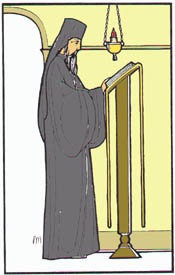
In the Orthodox Church all prayer is Trinitarian. We pray in the Holy Spirit, through Jesus the Son of God, and in his name, to God the Father. We call God “our Father” because Jesus has taught us and enabled us to do so. We have the capability of addressing God as Father because we are made sons of God by the Holy Spirit (see Rom 8).
In the Church we also address prayers to Christ and the Holy Spirit, the Divine Persons who are one with God the Father and exist eternally in perfect unity with him, sharing his divine being and will.
In the Church we also pray to the saints – not in the same way as we pray to the Persons of the Holy Trinity, but as our helpers, intercessors, and fellow-members of the Church who are already glorified with God in his divine presence. Foremost among the saints and first among the mere humans who are glorified in God’s Kingdom is Mary, the Theotokos and Queen of Heaven, the leader among our saintly intercessors before God. We can also pray to the holy angels to plead our cause before God.
In the traditional catechism of the Church three types of prayer are listed: asking, thanking, and praising. We can add a fourth type which can be called lamenting before God, questioning him about the conditions of life and the meaning of our existence, particularly in times of tragedy and confusion. We very often find all four kinds of prayer in the Bible.
Sometimes prayer is defined as a dialogue with God. This definition is sufficient if we remember that it is a dialogue of silence, carried on in the quiet of our hearts. In the Orthodox Church a more ancient and traditional definition of prayer calls it the lifting of the mind and heart to God, the standing in his presence, the constant awareness and remembrance of his name, his existence, his power and his love. This is the kind of prayer which is also called “walking in the presence of God.”
The purpose of prayer is to have communion with God and to be made capable of accomplishing his will. Christians pray to enable themselves to know God and to do his commandments. Unless a person is willing to change himself and to conform himself to Christ in the fulfillment of his commandments, he has no reason or purpose to pray. According to the saints, it is even spiritually dangerous to pray to God without the intention of responding and moving along the path that prayer will take us.
Praying is not merely repeating the words of prayers. Saying prayers is not the same as praying. Prayer should be done secretly, briefly, regularly, without many words, with trust in God that he hears, and with the willingness to do what God shows us to do (see Mt.6:5–15; Lk.11and 18; Jn.14–17).
The Orthodox Church follows the Old Testament practice of having formal prayers according to the hours of the day. Christians are urged to pray regularly in the morning, evening and at meal times, as well as to have a brief prayer which can be repeated throughout the day under any and all circumstances. Many people use the Jesus Prayer for this purpose: “Lord Jesus Christ, Son of God, have mercy on me, a sinner!” Of course, the form of the prayer is secondary and may vary from person to person. It is the power of the prayer to bring us to God, and to strengthen us in doing his divine will that is essential.
The prayers of a person at home differ from those in church, since personal prayer is not the same as the communal prayer of the Church. The two types of prayer are different and should not be confused.
When we go to church to pray, we do not go there to say our private prayers. Our private prayers should be said at home, in our room, in secret, and not in church (Mt.6:5–6). This does not mean that we do not bring our personal cares, desires, troubles, questions and joys to the prayer of the Church. We certainly can, and we do. But we bring ourselves and our concerns to church to unite them to the prayer of the Church, to the eternal prayer of Christ, the Mother of God, the saints and the brothers and sisters of our own particular church community.
In church we pray with others, and we should therefore discipline ourselves to pray all together as one body in the unity of one mind, one heart and one soul. Once again this does not mean that our prayers in church should cease to be personal and unique; we must definitely put ourselves into our churchly prayer. In the Church, however, each one must put his own person with his own personal uniqueness into the common prayer of Christ with his Body. This is what enriches the prayer of the Church and makes it meaningful and beautiful and, we might even say, “easy” to perform. The difficulty of many church services is that they are prayers of isolated individuals who are only physically, and not spiritually, united together.
The formal Church services are normally rather long in the Orthodox Church. This is so because we go to church not merely to pray. We go to church to be together, to sing together, to meditate on the meaning of the faith together, to learn together and to have union and communion together with God. This is particularly true of the Divine Liturgy of the Church (see “The Divine Liturgy,” below). If a person wants merely to pray in the silence of his heart, he need not – and, indeed, he should not go to the church services for this purpose. The church services are not designed for silent prayer. They exist for the prayerful fellowship of all God’s people with each other, with Christ and with God.
Vespers
In the Orthodox Church the liturgical day begins in the evening with the setting of the sun. This practice follows the Biblical account of creation: “And there was evening and there was morning, one day” (Gen.1:5).
The Vespers service in the Church always begins with the chanting of the evening psalm: “. . . the sun knows it’s time for setting, Thou makest darkness and it is night . . .” (Ps.104:19–20). This psalm, which glorifies God’s creation of the world, is man’s very first act of worship, for man first of all meets God as Creator.
Bless the Lord, oh my soul, O Lord my God, Thou art very great . . .
O Lord, how manifold are Thy works! In wisdom hast Thou made them all. The earth is full of Thy creatures (Ps.104:24).
Following the psalm, the Great Litany, the opening petition of all liturgical services of the Church is intoned. In it we pray to the Lord for everyone and everything.
Following this litany a number of psalms are chanted, a different group each evening. These psalms normally are omitted in parish churches though they are done in monasteries. On the eve of Sunday, however, sections of the first psalm and the other psalms which are chanted to begin the week are usually sung even in parish churches.
Psalm 141is always sung at Vespers. During this psalm the evening incense is offered:
Lord, I call upon Thee, hear me. Hear me, O Lord
.
Let my prayer arise in Thy sight as incense.
And let the lifting up of my hands be an evening sacrifice. Hear me, O Lord (Ps.141:1–2).
At this point special hymns are sung for the particular day. If it be a Church feast: songs in honor of the celebration are sung. On Saturday evenings, the eve of the Lord’s Day, these hymns always praise Christ’s resurrection from the dead.
The special hymns normally end with a song called a Theotokion which honors Mary, the Mother of Christ. Following this, the vesperal hymn is sung. If it be a special feast or the eve of Sunday, the celebrant will come to the center or the church building with lighted candles and incense. This hymn belongs to every Vespers service.
O Gladsome Light of the holy glory of the Immortal Father, heavenly, holy, blessed Jesus Christ. Now we have come to the setting of the sun and behold the light of evening. We praise God: Father, Son, and Holy Spirit. For it is right at all times to worship Thee with voices of praise, O Son of God and Giver of Life, therefore all the world glorifies Thee.
Christ is praised as the Light which illumines man’s darkness, the Light of the world and of the Kingdom of God which shall have no evening (Is.60:20, Rev.21:25).
A verse from the Psalms, the prokeimenon, follows – a different one for each day, announcing the day’s spiritual theme. If it be a special day, three readings from the Old Testament are included. Then more evening prayers and petitions follow with additional hymns for the particular day, all of which end with the chanting of the Song of Saint Simeon:
Lord, now lettest Thou Thy servant depart in peace according to Thy word, for mine eyes have seen Thy salvation: which Thou hast prepared before the face of all people. A light for revelation to the Gentiles, and to be the glory of Thy people Israel (Lk.1:29–32).
After proclaiming our own vision of Christ, the Light and Salvation of the world, we say the prayers of the Thrice-Holy (trisagion) through to the Our Father. We sing the main theme song of the day, called the Troparion, and we are dismissed with the usual benediction.
The service of Vespers takes us through creation, sin, and salvation in Christ. It leads us to the meditation of God’s word and the glorification of his love for men. It instructs us and allows us to praise God for the particular events or persons whose memory is celebrated and made present to us in the Church. It prepares us for the sleep of the night and the dawn of the new day to come. On the evening before the Divine Liturgy, it begins our movement into the most perfect communion with God in the sacramental mysteries.
Matins
The morning service of the Church is called Matins. It opens with the reading of six morning psalms and the intoning of the Great Litany. After this, verses of Psalm 118 are sung:
God is the Lord and has revealed himself unto us.
Blessed is he who comes in the name of the Lord.
The Troparion is then sung and, if it be a monastery, various groups of psalms which differ each day are read. Once again there are hymns on the theme of the particular day. On major feast days, special praises and psalms are sung, which on the Lord’s Day sing of Christ’s resurrection from the dead. On major feasts and on Sundays, the Gospel is also read.
After the Gospel there is a long intercessory prayer followed by a set of hymns and readings called the Canon. These songs are based on the Old Testamental canticles and conclude with the song of Mary, the so-called Magnificat (Lk.1:46–55). The Great Doxology is chanted followed by the morning litanies. The troparion is also repeated once again before the congregation is dismissed to begin the activities of the day.
The Matins service of the Church unites the elements of morning psalmody and prayer with meditation on the Biblical canticles, the Gospel reading, and the particular theme of the day in the given verses and hymns. The themes of God’s revelation and light are also always central to the morning service of the Church. Sometimes, particularly in churches of the Russian tradition, the Matins and the Vespers services are combined to form a long vigil service. On special feast days, the blessing of bread, wheat, wine, and oil is added to the Vespers, even when it is served separately from Matins. The faithful partake of the blessed food and are anointed with the oil as a sign of God’s mercy and grace.
Hours, Compline and Nocturne
In addition to the liturgical services of Vespers and Matins, there are also the services of the Hours, Compline, and Nocturne. These services are chanted in monasteries but are seldom used in parish churches except perhaps during Lent and Holy Week, and on special feast days.
The services of Hours are called the First, Third, Sixth and Ninth. These “hours” conform generally to the hours of six and nine in the morning, noon, and three in the afternoon. The services consist mostly of psalms which are generally related to the events in the passion of Christ which took place at that particular hour of the day. The Third Hour also refers to the coming of the Holy Spirit to the disciples on Pentecost.
The troparia of the given day or of the feast being celebrated are added to the Hours. During the first days of Holy Week as well as on certain major feasts, the Gospel is also read during the Hours. On days when there is no Divine Liturgy, the so-called Typical Psalms which include elements of the Divine Liturgy such as the liturgical psalms, the Beatitudes, and the Creed are read after the Ninth Hour.
Compline is called the “after-dinner” service of the Church. Its name, both in Greek and Slavonic, indicates this. It is a service of psalms and prayers to be read following the evening meal; after Vespers has been served. On days when Vespers is connected to the Divine Liturgy, such as the eves of Christmas and Epiphany, Great Compline is added to Matins to form a Vigil service. During the first week of Great Lent, the Penitential Canon of Saint Andrew of Crete is read at the Compline Service.
Nocturne is the midnight service of the Church. In monasteries it usually begins the all-night vigil of the monks. It contains a number of psalms together with the normal prayers found in other services, such as the call to worship, the Thrice-Holy, the Our Father, the Troparion, etc. Its theme is obviously the night and the need for vigilance. In the parishes, it is known almost exclusively as the service preceding Easter Matins at which the winding-sheet depicting the dead Saviour is taken from the tomb and is placed on the altar table.
Church Year
Although the first of September is considered the start of the Church year, according to the Orthodox Church calendar, the real liturgical center of the annual cycle of Orthodox worship is the feast of the Resurrection of Christ. All elements of Orthodox liturgical piety point to and flow from Easter, the celebration of the New Christian Passover. Even the “fixed feasts” of the Church such as Christmas and Epiphany which are celebrated according to a fixed date on the calendar take their liturgical form and inspiration from the Paschal feast.
The Easter cycle of worship begins with the season of Great Lent, preceded by the special pre-lenten Sundays. The lenten order of worship fulfills itself in Holy Week and the Great Day of Christ”s Resurrection. Following Easter there are the fifty days of paschal celebration until the feast of Pentecost. Every week of the year is then considered in the Church”s worship as a “Sunday after Pentecost.” The weeks are counted in this way (First Sunday, Second Sunday, etc.) until the pre-lenten season begins again when the weeks are given their name and central content of worship in view of the annual return of Easter.
There are two special liturgical books for the Easter cycle of worship, the Lenten Triodion and the Easter Triodion (literally the Flower Triodion), which is also called the Pentecostarion. These books are called Triodions because of the “three odes” which are often sung during the church services of these seasons.
The Sundays and weeks following Pentecost also have their special book called the Octoechos which literally means the “eight tones.” The Octoechos contains the services for each day of the week. Sunday is always dedicated to the Resurrection of Christ. Wednesdays and Fridays commemorate Christ’s suffering and crucifixion. Monday’s theme is the “bodiless powers”the angels. Tuesday is dedicated to the memory of John the Baptist, Thursday to the apostles and Saint Nicholas, and Saturday to the Theotokos with the memory of the departed.
On each day of the week, beginning with the eve of the Lord’s Day, the services are sung in the same “tone” or musical melody. There are eight sets of services in eight different “tones” (hence, the name Octoechos), sung in a revolving pattern throughout the year. Thus, for example, on the 2nd Sunday after Pentecost there would be Tone 1; the 3rd Sunday after Pentecost, Tone 2; the 4th Sunday after Pentecost, Tone 3, and so on until the 10th Sunday which is again Tone 1. This cycle of “tones” exists for every week of the year, although when the lenten season approaches the emphasis falls once more upon the preparation for the celebration of Easter.
In addition to the Easter cycle of worship with the “weeks after Pentecost,” and existing together with it, is the Church’s worship for each particular day of the year, each of which is dedicated to certain saints or sacred events. Each month has a special liturgical book called the Menaion which contains the specific service for each day of that month. The solemnity of the day is proportionate to the importance and popularity of the given saints or events to be commemorated.
There are twelve major feast days of the Church which are universally celebrated: the Nativity, Epiphany, Presentation to the Temple (called the “Meeting of the Lord”) and Transfiguration of Christ; the Nativity, Annunciation, Presentation to the Temple and Dormition of Mary; the Exaltation of the Cross; and, from the Paschal cycle, the feast of the Lord’s entry into Jerusalem, the feast of the Lord’s Ascension and the feast of Pentecost. Easter is not counted among the twelve major feasts of the Church since it is considered by itself as “the feast of feasts.”
Different Orthodox churches emphasize the other days of the year according to their particular relevancy and significance. Thus, the day of Saint Sergius would be greatly celebrated in Russia, Saint Spiridon in Greece, and Saint Herman in America. Some days, such as Saints Peter and Paul, Saint Nicholas, and Saint Michael, also enjoy a universal popularity in the church.
| Major Feasts of the Church | |
| September 8 | The Nativity of Mary the Theotokos |
| September 14 | The Exaltation of the Cross |
| November 21 | The Presentation of the Theotokos to the Temple |
| December 25 | The Nativity of Christ |
| January 6 | The Epiphany: The Baptism of Christ |
| February 2 | The Meeting of Christ in the Temple |
| March 25 | The Annunciation |
| August 6 | The Transfiguration of Christ |
| August 15 | The Dormition of the Theotokos |
| Calculated according to the Spring Equinox and the Jewish Passover | |
| Palm Sunday | The Entry into Jerusalem |
| PASCHA | Christ’s Resurrection |
| Ascension | The Ascension of Christ |
| Pentecost | The Descent of the Holy Spirit |
The feast of Christmas has its own cycle of prayer patterned after Easter. There is a forty-day lent preceding it and a post-feast celebration following it. The feasts of Mary’s Dormition and Saints Peter and Paul also have traditional lenten preparations of shorter duration. Most of the major feasts have a prefestal preparation of liturgical prayer, and a post-festal glorification. This means that the feast is called to mind and is glorified in the Church’s liturgical services in anticipation of its coming and is also celebrated in songs and prayers for some days in the Church after its passing.
Pre-Lent
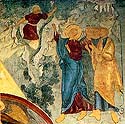
The paschal season of the Church is preceded by the season of Great Lent, which is itself preceded by its own liturgical preparation. The first sign of the approach of Great Lent comes five Sundays before its beginning. On this Sunday the Gospel reading is about Zacchaeus the tax-collector. It tells how Christ brought salvation to the sinful man and how his life was greatly changed simply because he “sought to see who Jesus was” (Lk.19:3). The desire and effort to see Jesus begins the entire movement through lent towards Easter. It is the first movement of salvation.
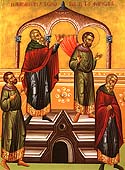
The following Sunday is that of the Publican and the Pharisee. The focus here is on the two men who went to the Temple to pray – one a pharisee who was a very decent and righteous man of religion, the other a publican who was a truly sinful tax-collector who was cheating the people. The first, although genuinely righteous, boasted before God and was condemned, according to Christ. The second, although genuinely sinful, begged for mercy, received it, and was justified by God (Lk.18:9). The meditation here is that we have neither the religious piety of the pharisee nor the repentance of the publican by which alone we can be saved. We are called to see ourselves as we really are in the light of Christ’s teaching, and to beg for mercy.

The next Sunday in the preparation for Great Lent is the Sunday of the Prodigal Son. Hearing the parable of Christ about God’s loving forgiveness, we are called to “come to ourselves” as did the prodigal son, to see ourselves as being “in a far country” far from the Father’s house, and to make the movement of return to God. We are given every assurance by the Master that the Father will receive us with joy and gladness. We must only “arise and go,” confessing our selfinflicted and sinful separation from that “home” where we truly belong (Lk.15:11–24).

The next Sunday is called Meatfare Sunday since it is officially the last day before Easter for eating meat. It commemorates Christ’s parable of the Last Judgment (Mt.25:31–46). We are reminded this day that it is not enough for us to see Jesus, to see ourselves as we are, and to come home to God as his prodigal sons. We must also be his sons by following Christ, his only-begotten divine Son, and by seeing Christ in every man and by serving Christ through them. Our salvation and final judgment will depend upon our deeds, not merely on our intentions or even on the mercies of God devoid of our own personal cooperation and obedience.
. . . for I was hungry and you gave Me food, I was thirsty and you gave Me drink, I was a stranger and you took Me in, I was naked and you clothed Me, I was sick and in prison and you visited Me. For truly I say to you, if you did it to one of the least of these my brothers, you did it to Me (Mt.25).
We are saved not merely by prayer and fasting, not by “religious exercises” alone. We are saved by serving Christ through his people, the goal toward which all piety and prayer is ultimately directed.
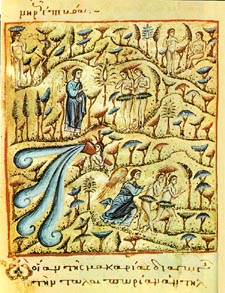
Finally, on the eve of Great Lent, the day called Cheesefare Sunday and Forgiveness Sunday, we sing of Adam’s exile from paradise. We identify ourselves with Adam, lamenting our loss of the beauty, dignity and delight of our original creation, mourning our corruption in sin. We also hear on this day the Lord’s teaching about fasting and forgiveness, and we enter the season of the fast forgiving one another so that God will forgive us.
If you forgive men their trespasses, your heavenly Father will forgive you; but if you do not forgive men their trespasses, neither will your heavenly Father forgive you your trespasses (Mt.6:14–18).
Great Lent
The season of Great Lent is the time of preparation for the feast of the Resurrection of Christ. It is the living symbol of man’s entire life which is to be fulfilled in his own resurrection from the dead with Christ. It is a time of renewed devotion: of prayer, fasting, and almsgiving. It is a time of repentance, a real renewal of our minds, hearts and deeds in conformity with Christ and his teachings. It is the time, most of all, of our return to the great commandments of loving God and our neighbors.
In the Orthodox Church, Great Lent is not a season of morbidity and gloominess. On the contrary, it is a time of joyfulness and purification. We are called to “anoint our faces” and to “cleanse our bodies as we cleanse our souls.” The very first hymns of the very first service of Great Lent set the proper tone of the season:
Let us begin the lenten time with delight . . . let us fast from passions as we fast from food, taking pleasure in the good words of the Spirit, that we may be granted to see the holy passion of Christ our God and his holy Pascha, spiritually rejoicing.
Thy grace has arisen upon us, O Lord, the illumination of our souls has shown forth; behold, now is the acceptable time; behold, now is the time of repentance (Vespers Hymns).
It is our repentance that God desires, not our remorse. We sorrow for our sins, but we do so in the joy of God’s mercy. We mortify our flesh, but we do so in the joy of our resurrection into life everlasting. We make ready for the resurrection during Great Lent, both Christ’s Resurrection and our own.
Lenten Fasting

A special word must be said about fasting during lent. Generally speaking, fasting is an essential element of the Christian life. Christ fasted and taught men to fast. Blessed fasting is done in secret, without ostentation or accusation of others (Mt.6:16; Rom.14). It has as its goal the purification of our lives, the liberation of our souls and bodies from sin, the strengthening of our human powers of love for God and man, the enlightening of our entire being for communion with the Blessed Trinity.
The Orthodox rules for lenten fasting are the monastic rules. No meat is allowed after Meatfare Sunday, and no eggs or dairy products after Cheesefare Sunday. These rules exist not as a Pharisaic “burden too hard to bear” (Lk.11:46), but as an ideal to be striven for; not as an end in themselves, but as a means to spiritual perfection crowned in love. The lenten services themselves continually remind us of this.
Let us fast with a fast pleasing to the Lord. This is the true fast: the casting off of evil, the bridling of the tongue, the cutting off of anger, the cessation of lusts, evil talking, lies and cursing. The stopping of these is the fast true and acceptable (Monday Vespers of the First Week).
The lenten services also make the undeniable point that we should not pride ourselves with external fasting since the devil also never eats!
The ascetic fast of Great Lent continues from Meatfare Sunday to Easter Sunday, and is broken only after the Paschal Divine Liturgy. Knowing the great effort to which they are called, Christians should make every effort to fast as well as they can, in secret, so that God would see and bless them openly with a holy life. Each person must do his best in the light of the given ideal.
In addition to the ascetic fasting of the lenten season, the Orthodox alone among Christians also practice what is known as eucharistic or liturgical fasting. This fasting does not refer to the normal abstinence in preparation for receiving the holy eucharist; it means fasting from the holy eucharist itself.
During the week days of Great Lent the regular eucharistic Divine Liturgy is not celebrated in Orthodox churches since the Divine Liturgy is always a paschal celebration of communion with the Risen Lord. Because the lenten season is one of preparation for the Lord’s Resurrection through the remembrance of sin and separation from God, the liturgical order of the Church eliminates the eucharistic service on the weekdays of lent. Instead the non-eucharistic services are extended with additional scripture readings and hymnology of a lenten character. In order that the faithful would not be entirely deprived of Holy Communion on the lenten days, however, the Liturgy of the Presanctified Gifts is celebrated on Wednesday and Friday evenings.
Even during Great Lent, Saturday (the Sabbath Day) and Sunday (the Lord’s Day) remain eucharistic days, and the Divine Liturgy is celebrated. On Saturdays it is the normal Liturgy of Saint John Chrysostom, usually with prayers for the dead. On Sundays it is the longer Liturgy of Saint Basil the Great.
The well-known teaching that Saturdays and Sundays are never days of fasting in the Orthodox Church, an issue emphasized centuries ago when controversy arose with the Latin Church, refers only to this eucharistic-liturgical fast. During Great Lent, even though the eucharistic fast is broken on Saturdays and Sundays, the ascetical fast continues through the weekends since this fasting is an extended effort made from Meatfare Sunday right to Easter itself.
Lenten Services
The weekday services of Great Lent are characterized by special lenten melodies of a penitential character. The royal gates to the altar area remain closed to signify man’s separation through sin from the Kingdom of God. The church vesting is of a somber color, usually purple. The daily troparia are also of an intercessory character, entreating God through his saints to have mercy on us sinners.
At the Matins the long Alleluia replaces the psalm: God is the Lord . . . the Psalmody is increased. The hymnology refers to the lenten effort. Scripture readings from Genesis and Proverbs are added to Vespers, and the Prophecy of Isaiah to the Sixth Hour. Each of these books is read nearly in its entirety during the lenten period. Epistle and gospel readings are absent because there are no Divine Liturgies.
At all of the lenten services the Prayer of Saint Ephraim of Syria is read. It supplicates God for those virtues especially necessary to the Christian life.
O Lord and Master of my life: take from me the spirit of sloth, faint-heartedness, lust of power and idle talk.
But grant rather the spirit of chastity, humility, patience and love to Thy servant.
Yea, O Lord and King, grant me to see my own errors and not to judge my brother, for blessed art Thou unto ages of ages. Amen.
The Vespers service which begins the lenten season is called the Vespers of Forgiveness. It is customary at this service for the faithful to ask forgiveness and to forgive each other. At the Compline services of the first week of lent the Canon of Saint Andrew of Crete is read. This is a long series of penitential verses based on Biblical themes, to each of which the people respond: Have mercy on me, O God, have mercy on me. This canon is repeated at Matins on Thursday of the fifth week.

On Friday evening of this same fifth week, the Akathistos Hymn to the Mother of God is sung; and the Saturday Divine Liturgy also honors the Theotokos.

The first Saturday of Great Lent is dedicated to the memory of Saint Theodore of Tyre. The second, third, and fourth Saturdays are called Memorial Saturdays since they are dedicated to the remembrance of the dead.
On Memorial Saturdays the liturgical hymns pray universally for all of the departed, and the Matins for the dead, popularly called the parastasis or panikhida, is served with specific mention of the deceased by name. Litanies and prayers are also added to the Divine Liturgy at which the scripture readings refer to the dead and their salvation by Christ.
Saturday, even during the non-lenten season, is the Church’s day for remembering the dead. This is so because Saturday, the Sabbath Day, stands as the day which God blessed for life in this world. Because of sin, however, this day now symbolizes all of earthly life as naturally fulfilled in death. Even Christ the Lord lay dead on the Sabbath Day, “resting from all of his works” and “trampling down death by death.” Thus, in the New Testament Church of Christ, Saturday becomes the proper day for remembering the dead and for offering prayers for their eternal salvation.
Liturgy of the Presanctified Gifts
As we already have seen, the eucharistic Divine Liturgy is not celebrated in the Orthodox Church on lenten weekdays. In order for the faithful to sustain their lenten effort by participation in Holy Communion, the Liturgy of the Presanctified Gifts is served. The service is an ancient one in the Orthodox Church. We officially hear about it in the canons of the seventh century, which obviously indicates its development at a much earlier date.
On all days of the holy fast of Lent, except on the Sabbath, the Lord’s Day, and the holy day of the Annunciation, the Liturgy of the Presanctified is to be served (Canon 52, Quinisext, 692).
The Liturgy of the Presanctified Gifts is an evening service. It is the solemn lenten Vespers with the administration of Holy Communion added to it. There is no consecration of the eucharistic gifts at the presanctified liturgy. Holy Communion is given from the eucharistic gifts sanctified on the previous Sunday at the celebration of the Divine Liturgy, unless, of course, the feast of the Annunciation should intervene; hence its name of “presanctified.”
The Liturgy of the Presanctified Gifts is served on Wednesday and Friday evenings, although some churches may celebrate it only on one of these days. It comes in the evening after a day of spiritual preparation and total abstinence. The faithful who are unable to make the effort of total fasting because of weakness or work, however, normally eat a light lenten meal in the early morning.
During the psalms of Vespers, the presanctified gifts are prepared for communion. They are transferred from the altar table where they have been reserved since the Divine Liturgy, and are placed on the table of oblation. After the evening hymn, the Old Testamental scriptures of Genesis and Proverbs are read, between which the celebrant blesses the kneeling congregation with a lighted candle and the words: “The Light of Christ illumines all,” indicating that all wisdom is given by Christ in the Church through the scriptures and sacraments. This blessing was originally directed primarily to the catechumens – those preparing to be baptized on Easter – who attended the service only to the time of the communion of the faithful.
After the readings, the evening Psalm 141is solemnly sung once again with the offering of incense. Then, after the litanies of intercession and those at which the catechumens were dismissed in former days, the presanctified eucharistic gifts are brought to the altar in a solemn, silent procession. The song of the entrance calls the faithful to communion.
Now the heavenly powers [i.e., the angels] do minister invisibly with us. For behold the King of Glory enters. Behold the mystical sacrifice, all fulfilled, is ushered in.
Let us with faith and love draw near that we may be partakers of everlasting life. Alleluia. Alleluia. Alleluia.
After the litany and prayers, the Our Father is sung and the faithful receive Holy Communion to the chanting of the verse from Psalm 34: “O taste and see how good is the Lord. Alleluia.” The post-communion hymns are sung and the faithful depart with a prayer to God who “has brought us to these all-holy days for the cleansing of carnal passions,” that he will bless us “to fight the good fight, to accomplish the course of the fast, and to attain unto and to adore the holy resurrection” of Christ.
The Liturgy of the Presanctified Gifts is traditionally considered to be the work of the sixth-century pope, Saint Gregory of Rome. The present service, however, is obviously the inspired liturgical creation of Christian Byzantium
Sundays of Lent
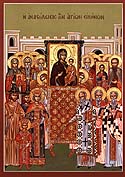
Each of the Sundays of Great Lent has its own special theme. The first Sunday is called the Feast of the Triumph of Orthodoxy. It is a historical feast commemorating the return of the icons to the churches in the year 843after the heresy of iconoclasm was overcome. The spiritual theme of the day is first of all the victory of the True Faith. “This is the victory that overcomes the world, our faith” (1Jn.5:4). Secondly, the icons of the saints bear witness that man, “created in the image and likeness of God” (Gen.1:26), becomes holy and godlike through the purification of himself as God’s living image.

The Second Sunday of Lent is the commemoration of Saint Gregory Palamas. It was Saint Gregory (d:1359) who bore living witness that men can become divine through the grace of God in the Holy Spirit; and that even in this life, by prayer and fasting, human beings can become participants of the uncreated light of God’s divine glory.

The Third Sunday of Lent is that of the Veneration of the Cross. The cross stands in the midst of the church in the middle of the lenten season not merely to remind men of Christ’s redemption and to keep before them the goal of their efforts, but also to be venerated as that reality by which man must live to be saved. “He who does not take up his cross and follow me is not worthy of me” (Mt.10:38). For in the Cross of Christ Crucified lies both “the power of God and the wisdom of God” for those being saved (1Cor.1:24).
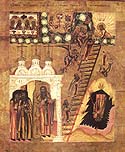
The Fourth Sunday of Lent is dedicated to Saint John of the Ladder (Climacus), the author of the work, The Ladder of Divine Ascent. The abbot of Saint Catherine’s Monastery on Mount Sinai (6th century) stands as a witness to the violent effort needed for entrance into God’s Kingdom (Mt.10:12). The spiritual struggle of the Christian life is a real one, “not against flesh and blood, but against . . . the rulers of the present darkness . . . the hosts of wickedness in heavenly places . . .” (Eph.6:12). St John encourages the faithful in their efforts for, according to the Lord, only “he who endures to the end will be saved” (Mt.24:13).

The Fifth Sunday recalls the memory of Saint Mary of Egypt, the repentant harlot. Mary tells us, first of all, that no amount of sin and wickedness can keep a person from God if he truly repents. Christ himself has come “to call sinners to repentance” and to save them from their sins (Lk.5:32). In addition, Saint Mary tells us that it is never too late in life – or in Lent – to repent. Christ will gladly receive all who come to him even at the eleventh hour of their lives. But their coming must be in serious and sincere repentance.
Lazarus Saturday and Palm Sunday
The week following the Sunday of Saint Mary of Egypt is called Palm or Branch Week. At the Tuesday services of this week the Church recalls that Jesus’ friend Lazarus has died and that the Lord is going to raise him from the dead (Jn.11). As the days continue toward Saturday, the Church, in its hymns and verses, continues to follow Christ towards Bethany to the tomb of Lazarus. On Friday evening, the eve of the celebration of the Resurrection of Lazarus, the “great and saving forty days” of Great Lent are formally brought to an end:
Having accomplished the forty days for the benefit of our souls, we pray to Thee, O Lover of Man, that we may see the holy week of Thy passion, that in it we may glorify Thy greatness and Thine unspeakable plan of salvation for our sake . . . (Vespers Hymn).

Lazarus Saturday is a paschal celebration. It is the only time in the entire Church Year that the resurrectional service of Sunday is celebrated on another day. At the liturgy of Lazarus Saturday, the Church glorifies Christ as “the Resurrection and the Life” who, by raising Lazarus, has confirmed the universal resurrection of mankind even before His own suffering and death.
By raising Lazarus from the dead before Thy passion, Thou didst confirm the universal resurrection, O Christ God! Like the children with the branches of victory, we cry out to Thee, O Vanquisher of Death: Hosanna in the highest! Blessed is he that comes in the name of the Lord! (Troparion).
Christ – the Joy, the Truth and the Light of All, the Life of the world and its Resurrection – has appeared in his goodness to those on earth. He has become the Image of our Resurrection, granting divine forgiveness to all (Kontakion).
At the Divine Liturgy of Lazarus Saturday the baptismal verse from Galatians: As many as have been baptized into Christ have put on Christ (Gal.3:27) replaces the Thrice-holy Hymn thus indicating the resurrectional character of the celebration, and the fact that Lazarus Saturday was once among the few great baptismal days in the Orthodox Church Year.
Because of the resurrection of Lazarus from the dead, Christ was hailed by the masses as the long-expected Messiah-King of Israel. Thus, in fulfillment of the prophecies of the Old Testament, He entered Jerusalem, the City of the King, riding on the colt of an ass (Zech.9:9; Jn.12:12). The crowds greeted Him with branches in their hands and called out to Him with shouts of praise: Hosanna! Blessed is He who comes in the name of the Lord! The Son of David! The King of Israel! Because of this glorification by the people, the priests and scribes were finally driven “to destroy Him, to put Him to death” (Lk.19:47; Jn.11:53, 12:10).
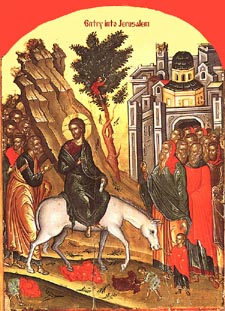
The feast of Christ’s triumphal Entry into Jerusalem, Palm Sunday, is one of the twelve major feasts of the Church. The services of this Sunday follow directly from those of Lazarus Saturday. The church building continues to be vested in resurrectional splendor, filled with hymns which continually repeat the Hosanna offered to Christ as the Messiah-King who comes in the name of God the Father for the salvation of the world.
The main troparion of Palm Sunday is the same one sung on Lazarus Saturday. It is sung at all of the services, and is used at the Divine Liturgy as the third antiphon which follows the other special psalm verses which are sung as the liturgical antiphons in the place of those normally used. The second troparion of the feast, as well as the kontakion and the other verses and hymns, all continue to glorify Christ’s triumphal manifestation “six days before the Passover” when he will give himself at the Supper and on the Cross for the life of the world.
Today the grace of the Holy Spirit has gathered us together. Let us all take up Thy cross and say: Blessed is he who comes in the name of the Lord. Hosanna in the highest! (First Verse of Vespers).
When we were buried with Thee in baptism, O Christ God, we were made worthy of eternal life by Thy resurrection. Now we praise Thee and sing: Hosanna in the highest! Blessed is he that comes in the name of the Lord! (Second Troparion).
Sitting on Thy throne in heaven, and carried on a foal on earth, O Christ God, accept the praise of angels and the songs of children who sing: BIessed is he who comes to recall Adam! (Kontakion).
At the vigil of the feast of Palm Sunday the prophecies of the Old Testament about the Messiah-King are read together with the Gospel accounts of the entry of Christ into Jerusalem. At Matins branches are blessed which the people carry throughout the celebration as the sign of their own glorification of Jesus as Saviour and King. These branches are usually palms, or, in the Slavic churches, pussy willows which came to be customary because of their availability and their early blossoming in the springtime.
As the people carry their branches and sing their songs to the Lord on Palm Sunday, they are judged together with the Jerusalem crowd. For it was the very same voices which cried Hosanna to Christ, which, a few days later, cried Crucify Him! Thus in the liturgy of the Church the lives of men continue to be judged as they hail Christ with the “branches of victory” and enter together with Him into the days of His “voluntary passion.”
Holy Week
In the Orthodox Church the last week of Christ’s life is officially called Passion Week. In popular terminology it is called Holy Week. Each day is designated in the service books as “great and holy.” There are special services every day of the week which are fulfilled in all churches. Earthly life ceases for the faithful as they “go up with the Lord to Jerusalem” (Matins of Great and Holy Monday).

Each day of Holy Week has its own particular theme. The theme of Monday is that of the sterile fig tree which yields no fruit and is condemned. Tuesday the accent is on the vigilance of the wise virgins who, unlike their foolish sisters, were ready when the Lord came to them. Wednesday the focus is on the fallen woman who repents. Great emphasis is made in the liturgical services to compare the woman, a sinful harlot who is saved, to Judas, a chosen apostle who is lost. The one gives her wealth to Christ and kisses his feet; the other betrays Christ for money with a kiss.
On each of these three days the Gospel is read at the Hours, as well as at the Vespers when the Liturgy of the Presanctified Gifts is served. The Old Testamental readings are from Exodus, Job, and the Prophets. The Gospel is also read at the Matins services which are traditionally called the “Bridegroom” services because the general theme of each of these days is the end of the world and the judgment of Christ. It is the common practice to serve the Bridegroom services at night.
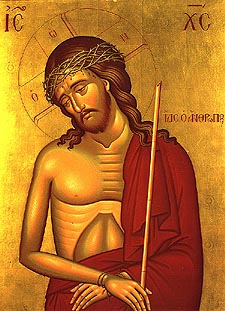
Behold, the bridegroom comes in the middle of the night and blessed is the servant whom he shall find watching, and unworthy the servant whom he shall find heedless. Take care then, O my soul, and be not weighed down by sleep that you will not be given over unto death and be excluded from the Kingdom. But rise up and call out: Holy, Holy, Holy art Thou O God, by the Theotokos have mercy on us (Troparion of the First Three Days).
During the first three days of Holy Week, the Church prescribes that the entire Four Gospels be read at the Hours up to the point in each where the passion of Christ begins. Although this is not usually possible in parish churches, an attempt is sometimes made to read at least one complete Gospel, privately or in common, before Holy Thursday.
Holy Thursday

The vigil on the eve of Holy Thursday is dedicated exclusively to the Passover Supper which Christ celebrated with his twelve apostles. The main theme of the day is the meal itself at which Christ commanded that the Passover of the New Covenant be eaten in remembrance of Himself, of His body broken and His blood shed for the remission of sins. In addition, Judas’ betrayal and Christ’s washing of His disciples feet is also central to the liturgical commemoration of the day.
In cathedral churches it is the custom for the bishop to re-enact the foot washing in a special ceremony following the Divine Liturgy. At the vigil of Holy Thursday, the Gospel of Saint Luke about the Lord’s Supper is read. At the Divine Liturgy the Gospel is a composite of all the evangelists’ accounts of the same event. The hymns and the readings of the day also all refer to the same central mystery.
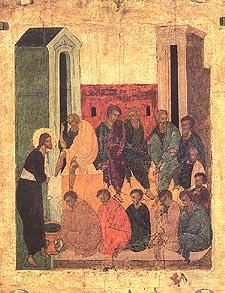
When Thy glorious disciples were enlightened at the washing of their feet before the supper, then the impious Judas was darkened by the disease of avarice, and to the lawless judges he betrayed Thee, the Righteous Judge. Behold, O lover of money, this man because of avarice hanged himself. Flee from the insatiable desire which dared such things against the Master! O Lord who deals righteously with all, glory to Thee (Troparion of Holy Thursday).
In the regions of the Master, at the Table of Immortality, in the high place, with minds lifted up, come, O ye faithful, let us eat with delight (Ninth Ode of the Canon of Matins).
The Divine Liturgy of Saint Basil is served on Holy Thursday in connection with Vespers. The long gospel of the Last Supper is read following the readings from Exodus, Job, Isaiah and the first letter of the Apostle Paul to the Corinthians (1Cor.11). The following hymn replaces the Cherubic Hymn of the offertory of the liturgy, and serves as well as the Communion and Post-Communion Hymns.
Of Thy mystical supper, O Son of God, accept me today a communicant, for I will not speak of Thy mystery to thine enemies, neither like Judas will I give Thee a kiss, but like the thief will I confess Thee: Remember me, O Lord, in Thy kingdom.
The liturgical celebration of the Lord’s Supper on Holy Thursday is not merely the annual remembrance of the institution of the sacrament of Holy Communion. Indeed the very event of the Passover Meal itself was not merely the last-minute action by the Lord to “institute” the central sacrament of the Christian Faith before His passion and death. On the contrary, the entire mission of Christ, and indeed the very purpose for the creation of the world in the first place, is so that God’s beloved creature, made in His own divine image and likeness, could be in the most intimate communion with Him for eternity, sitting at table with Him, eating and drinking in His unending kingdom. Thus, Christ the Son of God speaks to His apostles at the supper, and to all men who hear His words and believe in Him and the Father who sent Him:
Fear not, little flock, it is Your Father’s good pleasure to give you the kingdom (Lk.12:32).
You are those who have continued with Me in My trials; as My Father appointed a Kingdom for Me, so do I appoint for you that you may eat and drink at My table in My Kingdom . . . (Lk.22:28–31).
In a real sense, therefore, it is true to say that the body broken and the blood spilled spoken of by Christ at His last supper with the disciples was not merely an anticipation and preview of what was yet to come; but that what was yet to come – the cross, the tomb, the resurrection on the third day, the ascension into heaven – came to pass precisely so that men could be blessed by God to be in holy communion with him forever, eating and drinking at the mystical table of His kingdom of which there will be no end.
Thus the “Mystical Supper of the Son of God” which is continually celebrated in the Divine Liturgy of the Christian Church, is the very essence of what life in God’s Kingdom will be for eternity.
Blessed is he who shall eat bread in the Kingdom of God (Lk.14:15).
Blessed are those who are invited to the Marriage Supper of the Lamb (Rev.19:9).
Holy Friday

Matins of Holy Friday are generally celebrated on Thursday night. The main feature of this service is the reading of twelve selections from the Gospels, all of which are accounts of the passion of Christ. The first of these twelve readings is Jn.13:31–18:1. It is Christ’s long discourse with his apostles that ends with the so-called high priestly prayer. The final gospel tells of the sealing of the tomb and the setting of the watch (Mt.27:62–66).
The twelve Gospel readings of Christ’s passion are placed between the various parts of the service. The hymnology is all related to the sufferings of the Saviour and borrows heavily from the Gospels and the prophetic scriptures and psalms. The Lord’s beatitudes are added to the service after the sixth gospel reading, and there is special emphasis given to the salvation of the thief who acknowledged Christ’s Kingdom.
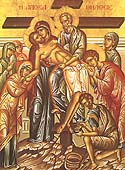
The Hours of Holy Friday repeat the Gospels of Christ’s passion with the addition at each Hour of readings from Old Testamental prophecies concerning man’s redemption, and from letters of Saint Paul relative to man’s salvation through the sufferings of Christ. The psalms used are also of a special prophetic character, e.g., Ps.2, 5, 22, 109, 139, et al.
There is no Divine Liturgy on Good Friday for the same obvious reason that forbids the celebration of the eucharist on the fasting days of lent (see “Lenten Fasting,” below).
Holy Saturday
The first service belonging to Holy Saturday – called in the Church the Blessed Sabbath – is the Vespers of Good Friday. It is usually celebrated in the mid-afternoon to commemorate the burial of Jesus.
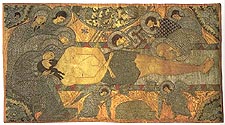
Before the service begins, a “tomb” is erected in the middle of the church building and is decorated with flowers. Also a special icon which is painted on cloth (in Greek, epitaphios; in Slavonic, plaschanitsa) depicting the dead Saviour is placed on the altar table. In English this icon is often called the winding-sheet.
Vespers begins as usual with hymns about the suffering and death of Christ. After the entrance with the Gospel Book and the singing of Gladsome Light, selections from Exodus, Job, and Isaiah 52are read. An epistle reading from First Corinthians (1:18–31) is added, and the Gospel is read once more with selections from each of the four accounts of Christ’s crucifixion and burial. The prokeimena and alleluia verses are psalm lines, heard often already in the Good Friday services, prophetic in their meaning:
They divided my garments among them and for my raiment they cast lots (Psalm.22:18).
My God, my God, why hast Thou forsaken me (Ps.22:1).
Thou hast put me in the depths of the Pit, in the regions dark and deep (Ps.88:6).
After more hymns glorifying the death of Christ, while the choir sings the dismissal song of Saint Simeon, the priest vests fully in his dark-colored robes and incenses the winding-sheet which still lies upon the altar table. Then, after the Our Father, while the people sing the troparion of the day, the priest circles the altar table with the winding-sheet carried above his head and places it into the tomb for veneration by the faithful.
The noble Joseph, when he had taken down Thy most pure body from the Tree, wrapped It in fine linen and anointed It with spices, and placed It in a new tomb (Troparion of Holy Saturday).
The Matins of Holy Saturday are usually celebrated on Friday night. They begin in the normal way with the singing of God is the Lord, the troparion The Noble Joseph, and the following troparia:
When Thou didst descend to death O Life Immortal, Thou didst slay hell with the splendor of Thy Godhead! And when from the depths Thou didst raise the dead, all the powers of heaven cried out: O Giver of Life! Christ our God! Glory to Thee!
The angel standing by the grave cried out to the women: Myrrh is proper for the dead, but Christ has shown himself a stranger to corruption.
In place of the regular psalm reading the entire Psalm 119 is read with a verse praising the dead Saviour chanted between each of its lines. This particular psalm is the verbal icon of Jesus, the righteous man whose life is in the hands of God and who, therefore, cannot remain dead. The Praises, as the verses are called, glorify God as “the Resurrection and the Life,” and marvel at his humble condescension into death.
There is in the person of Jesus Christ the perfect unification of the perfect love of man toward God and the perfect love of God toward man. It is this divine human love which is contemplated and praised over the tomb of the Savior. As the reading progresses the Praises become shorter, and gradually more concentrated on the final victory of the Lord, thus coming to their proper conclusion:
I long for Thy salvation, O Lord, Thy law is my delight (Ps.119:174).
The mind is affrighted at Thy dread and strange burial.
Let me live, that I may praise Thee, and let Thy ordinances help me (119:175).
The women with spices came early at dawn to anoint Thee
.
I have gone astray like a lost sheep, seek Thy servant, for I do not forget Thy commandments (119:176).
By Thy resurrection grant peace to the Church and salvation to Thy people!
After the final glorification of the Trinity, the church building is lighted and the first announcement of the women coming to the tomb resounds through the congregation as the celebrant censes the entire church. Here for the first time comes the clear proclamation of the good news of salvation in Christ’s resurrection.
The canon song of Matins continues to praise Christ’s victory over death by His own death, and uses each of the Old Testamental canticles as a prefigurative image of man’s final salvation through Jesus. Here for the first time there emerges the indication that this Sabbath this particular Saturday on which Christ lay dead – is truly the most blessed seventh day that ever existed. This is the day when Christ rests from His work of recreating the world. This is the day when the Word of God “through Whom all things were made” (Jn.1:3) rests as a dead man in the grave, saving the world of His own creation and opening the graves:
This is the most blessed Sabbath on which Christ sleeps, but to rise again on the third day (Kontakion and Oikos).
Again, the canon ends on the final note of the victory of Christ.
Lament not for Me, Mother, beholding Me in the grave, the son whom you have born in seedless conception, for I will arise and be glorified, and will exalt with glory, unceasingly as God, all those who with faith and love glorify you (Ninth Ode of the Canon).
As more verses of praise are sung, the celebrant again vests fully in his somber vestments and, as the great doxology is chanted, he once more censes the tomb of the Savior. Then, while the congregation with lighted candles continually repeats the song of the Thrice Holy, the faithful – led by their pastor carrying the Gospel Book with the winding-sheet of Christ held over his head – go in procession around the outside of the church building. This procession bears witness to the total victory of Christ over the powers of darkness and death. The whole universe is cleansed, redeemed and restored by the entrance of the Life of the World into death.
As the procession returns to the church building, the troparia are sung once again, and the prophecy of Ezekiel about the “dry bones” of Israel is chanted with great solemnity:
“And you shall know that I am the Lord, when I open your graves, O my people. And I will put my spirit within you and you shall live . . .” (Ezek.37:1–14).
With the victorious lines of the psalms calling God to arise, to lift up his hands, to scatter his enemies and to let the righteous rejoice; and with the repeated singing of Alleluia, the letter of the Apostle Paul to the Corinthians is read: “Christ our paschal lamb has been sacrificed” (1Cor.5.6–8). The Gospel about the sealing of the tomb is read once more, and the service is ended with intercession and benediction.
The Vespers and Matins of the Blessed Sabbath, together with the Divine Liturgy which follows, form a masterpiece of the Orthodox liturgical tradition. These services are not at all a dramatic re-enactment of the historical death and burial of Christ. Neither are they a kind of ritual reproduction of scenes of the Gospel. They are, rather, the deepest spiritual and liturgical penetration into the eternal meaning of the saving events of Christ, viewed and praised already with the full knowledge of their divine significance and power.
The Church does not pretend, as it were, that it does not know what will happen with the crucified Jesus. It does not sorrow and mourn over the Lord as if the Church itself were not the very creation which has been produced from his wounded sides and from the depths of his tomb. All through the services the victory of Christ is contemplated and the resurrection is proclaimed. For it is indeed only in the light of the victorious resurrection that the deepest divine and eternal meaning of the events of Christ’s passion and death can be genuinely grasped, adequately appreciated and properly glorified and praised.
On Holy Saturday itself, Vespers are served with the Divine Liturgy of Saint Basil the Great. This service already belongs to the Passover Sunday. It begins in the normal way with the evening psalm, the litany, the hymns following the evening Psalm 141and the entrance with the singing of the vesperal hymn, Gladsome Light. The celebrant stands at the tomb in which lies the winding-sheet with the image of the Savior in the sleep of death.
Following the evening entrance which is made with the Book of the Gospels, fifteen readings from the Old Testament scriptures are read, all of which relate to God’s work of creation and salvation which has been summed up and fulfilled in the coming of the predicted Messiah. Besides the readings in Genesis about creation, and the passover-exodus of the Israelites in the days of Moses in Exodus, there are selections from the prophecies of Isaiah, Ezekiel, Jeremiah, Daniel, Zephaniah, and Jonah as well as from Joshua and the Books of Kings, the Canticles of Moses, and of the Three Youths found in Daniel are chanted as well.
After the Old Testament readings the celebrant intones the normal liturgical exclamation for the singing of the Thrice-Holy Hymn, but in its place the baptismal verse from Galatians is sung: As many as have been baptized into Christ have put on Christ. Alleluia (Gal.3:27).
As usual in the Divine Liturgy the epistle reading follows at this point. It is the normal baptismal selection of the Orthodox Church (Rom.6:3–11). “If we have been united with him in a death like his we shall certainly be united with him in a resurrection like his” (Rom.6:5).
At this time the royal gates are closed, and the celebrants and altar servers change their robes from the dark vestments of the passion into the bright vestments of Christ’s victory over death. At this time all vestings of the church appointments are also changed into the color signifying Christ’s triumph over sin, the devil and death. This revesting takes place while the people sing the verses of Psalm 82: “Arise O Lord and judge the earth, for to Thee belong all the nations.”
After the solemn chanting of the psalm verses, to which are often added the hymn glorifying Christ as the New Passover, the Living Sacrifice who is slain, the Lamb of God who takes away the sins of the world; the celebrants emerge from the altar to announce over the tomb of Christ the glad tidings of his victorious triumph over death and his command to the apostles: “Make disciples of all nations baptizing them in the name of the Father and of the Son and of the Holy Spirit, teaching them to observe all that I have commanded . . .” (Mt.28:1.20). This Gospel text is also the reading of the baptismal ceremony of the Orthodox Church.
The Divine Liturgy then continues in the brilliance of Christ’s destruction of death. The following song replaces the Cherubic Hymn of the offertory:
Let all mortal flesh keep silent and in fear and trembling stand, pondering nothing earthly-minded. For the King of Kings and the Lord of Lords comes to be slain, to give himself as food to the faithful.
Before him go the ranks of angels: all the principalities and powers, the many-eyed cherubim and the six-winged seraphim, covering their faces, singing the hymn: Alleluia! Alleluia! Alleluia!
In place of the Hymn to the Theotokos, the ninth ode of the matinal canon is sung once again: “Lament not for Me, Mother . . . for I will arise” (see above). The communion hymn is the line of the psalm: “The Lord awoke as one asleep, and arose saving us” (Ps.78:65).
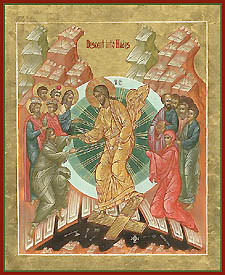
The Divine Liturgy is fulfilled in the communion with him who lies dead in his human body, and yet is enthroned eternally with God the Father; the one who, as the Creator and Life of the World, destroys death by his life-creating death. His tomb – which still stands in the center of the church – is shown to be, as the Liturgy calls it: the fountain of our resurrection.
Originally this Liturgy was the Easter baptismal liturgy of Christians. It remains today as the annual experience for every Christian of his own dying and rising with the Lord.
But if we have died with Christ, we believe that we shall also live with Him. For we know that Christ being raised from the dead will never die again; death no longer has dominion over Him (Rom.6:8–9).
Christ lies dead, yet he is alive. He is in the tomb, but already he is “trampling down death by death, and upon those in the tombs bestowing life.” There is nothing more to do now but to live through the evening of the Blessed Sabbath on which Christ sleeps, awaiting the midnight hour when the Day of our Lord will begin to dawn upon us, and the night full of light will come when we will proclaim with the angel: “He is risen, he is not here; see the tomb where they laid him” (Mk.16:6).
Easter Sunday: The Holy Pascha
A little before midnight on the Blessed Sabbath the Nocturne service is chanted. The celebrant goes to the tomb and removes the winding-sheet. He carries it through the royal doors and places it on the altar table where it remains for forty days until the day of Ascension.
At midnight the Easter procession begins. The people leave the church building singing:
The angels in heaven, O Christ our Savior, sing of Thy resurrection. Make us on earth also worthy to hymn Thee with a pure heart.
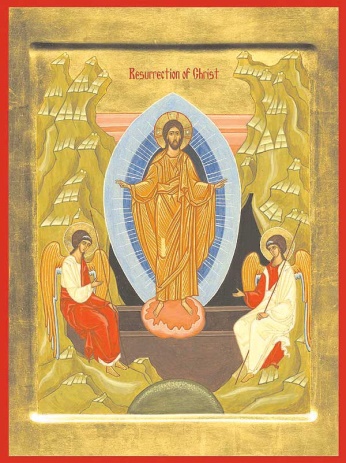
The procession circles the church building and returns to the closed doors of the front of the church. This procession of the Christians on Easter night recalls the original baptismal procession from the darkness and death of this world to the light and the life of the Kingdom of God. It is the procession of the holy passover, from death unto life, from earth unto heaven, from this age to the age to come which will never end.
Before the closed doors of the church building, the resurrection of Christ is announced. Sometimes the Gospel is read which tells of the empty tomb. The celebrant intones the blessing to the “holy, consubstantial, life-creating and undivided Trinity.” The Easter troparion is sung for the first time, together with the verses of Psalm 68 which will begin all of the Church services during the Easter season.
Let God arise, let his enemies be scattered; let those who hate him flee from before his face!
Christ is risen from the dead, trampling down death by death, and upon those in the tombs bestowing life (Troparion).
This is the day which the Lord has made, let us rejoice and be glad in it!
The people re-enter the church building and continue the service of Easter Matins which is entirely sung.
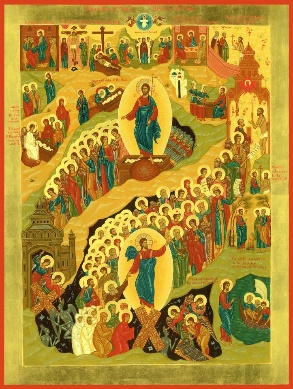
The canon hymns of Christ’s resurrection, ascribed to Saint John of Damascus, are chanted with the troparion of the feast as the constantly recurring refrain. The building is decorated with flowers and lights. The vestments are the bright robes of the resurrection. The Easter icon stands in the center of the church showing Christ destroying the gates of hell and freeing Adam and Eve from the captivity of death. It is the image of the Victor “trampling down death by his own death.” There is the continual singing and censing of the icons and the people, with the constant proclamation of the celebrant: Christ is risen! The faithful continually respond: Indeed He is risen!
It is the day of resurrection ! Let us be illumined for the feast! Pascha! The Pascha of the Lord! From death unto life, and from earth unto heaven has Christ our God led us! Singing the song of victory: Christ is risen from the dead! (First Ode of the Easter Canon).
Following the canon, the paschal verses are sung, and at the conclusion of the Easter Matins, the Easter Hours are also sung. In general, nothing is simply read in the Church services of Easter: everything is fully sung with the joyful melodies of the feast.
At the end of the Hours, before the Divine Liturgy, the celebrant solemnly proclaims the famous Paschal Sermon of Saint John Chrysostom. This sermon is an invitation to all of the faithful to forget their sins and to join fully in the feast of the resurrection of Christ. Taken literally, the sermon is the formal invitation offered to all members of the Church to come and to receive Holy Communion, partaking of Christ, the Passover Lamb, whose table is now being set in the midst of the Church. In some parishes the sermon is literally obeyed, and all of the faithful receive the eucharistic gifts of the Passover Supper of Easter night.
The Easter Divine Liturgy begins immediately with the singing once more of the festal troparion with the verses of Psalm 68. Special psalm verses also comprise the antiphons of the liturgy, through which the faithful praise and glorify the salvation of God:
Make a joyful noise to the Lord, all the earth! Sing of his name, give glory to His praise.
Let all the earth worship Thee and praise Thee! Let it praise Thy name, O most High!
That we may know Thy way upon the earth and Thy salvation among all nations.
Let the people thank Thee, O God! Let all the people give thanks to Thee.
The troparion is repeated over and over again. The baptismal line from Galatians replaces the Thrice-Holy Hymn. The epistle reading is the first nine verses of the Book of Acts. The gospel reading is the first seventeen verses of the Gospel of Saint John. The proclamation of the Word of God takes the faithful back again to the beginning, and announces God’s creation and re-creation of the world through the living Word of God, his Son Jesus Christ.
In the beginning was the Word and the Word was with God and the Word was God . . . all things were made through him . . . In Him was life and the life was the light of men. . . .
And the Word became flesh and dwelt among us full of grace and truth . . . we have beheld His glory, glory of the only-begotten Son of the Father, and from His fullness have we all received grace upon grace (Jn.1:1–17).
The Liturgy of Saint John Chrysostom continues, crowned in holy communion with the Passover Lamb at his banquet table in God’s Kingdom. Again and again the troparion of the Resurrection is sung while the faithful partake of Him “Who was dead and is alive again” (Rev.2:8).
In the Orthodox Church the feast of Easter is officially called Pascha, the word which means the Passover. It is the new Passover of the new and everlasting covenant foretold by the prophets of old. It is the eternal Passover from death to life and from earth to heaven. It is the Day of the Lord proclaimed by God’s holy prophets, “the day which the Lord has made” for His judgment over all creation, the day of His final and everlasting victory. It is the Day of the Kingdom of God, the day “which has no night” for “its light is the Lamb” (Rev.21:22–25).
The celebration of Easter in the Orthodox Church, therefore, is once again not merely an historical reenactment of the event of Christ’s Resurrection as narrated in the gospels. It is not a dramatic representation of the first Easter morning. There is no “sunrise service” since the Easter Matins and the Divine Liturgy are celebrated together in the first dark hours of the first day of the week in order to give men the experience of the “new creation” of the world, and to allow them to enter mystically into the New Jerusalem which shines eternally with the glorious light of Christ, overcoming the perpetual night of evil and destroying the darkness of this mortal and sinful world:
Shine! Shine! O New Jerusalem! The glory of the Lord has shone upon you! Exult and be glad O Zion! Be radiant O Pure Theotokos, in the Resurrection of your Son!
This is one of the main Easter hymns in the Orthodox Church. It is inspired by Isaiah’s prophecy and the final chapters of the Book of Revelation, for it is exactly tile New Creation, the New Jerusalem, the Heavenly City, the Kingdom of God, the Day of the Lord, the Marriage Feast of the Lamb with His Bride which is celebrated and realized and experienced in the Holy Spirit on the Holy Night of Easter in the Orthodox Church.
Post-Easter Sundays
Saint Thomas Sunday: Antipascha
Every day during the week of Easter, called Bright Week by the Church, the paschal services are celebrated in all their splendor. The Easter baptismal procession is repeated daily. The royal gates of the sanctuary remain open. The joy of the Resurrection and the gift of the Kingdom of eternal life continue to abound. Then, at the end of the week, on Saturday evening, the second Sunday after Easter is celebrated in remembrance of the appearance of Christ to the Apostle Thomas “after eight days” (Jn.20:26).
It is important to note that the number eight has symbolical significance in both Jewish and Christian spiritual tradition. It signifies more than completion and fullness; it signifies the Kingdom of God and the life of the world to come since seven is the number of earthly time. The sabbath, the seventh day, is the blessed day of rest in this world, the final day of the week. The “first day of the week,” the day “after Sabbath”; stressed in all of the gospels as the day of Christ’s Resurrection (Mk.16:1; Mt.28:1; Lk.24:1; Jn.20:1, 19), is therefore also “the eighth day,” the day beyond the confines of this world, the day which stands for the life of the world to come, the day of the eternal rest of the Kingdom of God (see Heb.4).

The Sunday after Easter, called the Second Sunday, is thus the eighth day of the paschal celebration, the last day of Bright Week. It is therefore called the Antipascha, and it was only on this day in the early church that the newly-baptized Christians removed their robes and entered once again into the life of this world.
In the Church services the stress is on the Apostle Thomas’ vision of Christ and the significance of the day comes to us in the words of the gospel:
Then He said to Thomas, “Put your finger here, and see My hands; and put out your hand, and place it in My side; do not be faithless, but believing.” Thomas answered Him, “My Lord and my God!” Jesus said to him, “Have you believed because you have seen Me? Blessed are those who have not seen and yet believe” (Jn.20:27–29).
We have not seen Christ with our physical eyes nor touched His risen body with our physical hands, yet in the Holy Spirit we have seen and touched and tasted the Word of Life (1Jn.1:1–4), and so we believe.
At each of the daily services until Ascension Day we sing the Easter Troparion. At each of the Sunday services beginning with Antipascha, we sing the Easter canon and hymns, and repeat the celebration of the “first day of the week” on which Christ rose from the dead. At all of the liturgies the epistle readings are taken from the Book of Acts telling us of the first Christians who lived in communion with the Risen Lord. All of the gospel readings are taken from the Gospel of Saint John, considered by many to be a gospel written particularly for those who are newly-baptized into the new life of the Kingdom of God through death and new birth in Christ, in the name of the Holy Trinity. The reason for this opinion is that all of the “signs” – as the miracles in Saint John’s Gospel are called – deal with sacramental themes involving water: wine and bread. Thus, each of the Sundays after Thomas Sunday with the exception of the third, is dedicated to the memory of one of these “signs.”
The Myrrhbearing Women
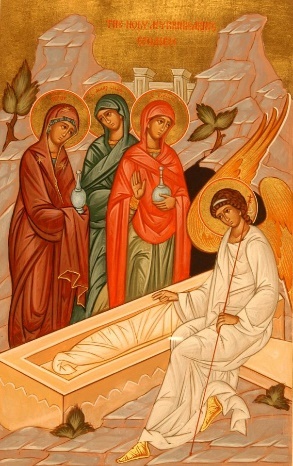
The third Sunday after Pascha is dedicated to the myrrhbearing women who cared for the body of the Saviour at his death and who were the first witnesses of His Resurrection. The three troparia of Holy Friday are sung once again and from the theme of the day:
The noble Joseph, when he had taken down Thy most pure body from the Tree, wrapped it in fine linen and anointed it with spices, and placed it in a new tomb.
When Thou didst descend to death, O Life Immortal, Thou didst slay hell with the splendor of Thy Godhead.
The angel came to the myrrhbearing women at the tomb and said: Myrrh is fitting for the dead, but Christ has shown Himself a stranger to corruption! So proclaim: The Lord is risen, granting the world great mercy.
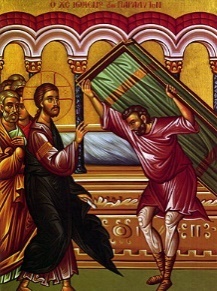
The Paralytic
The fourth Sunday is dedicated to Christ’s healing of the paralytic (Jn.5). The man is healed by Christ while waiting to be put down into the pool of water. Through baptism in the church we, too, are healed and saved by Christ for eternal life. Thus, in the church, we are told, together with the paralytic, “to sin no more that nothing worse befall you” (Jn.5:14).
The Feast of Mid-Pentecost
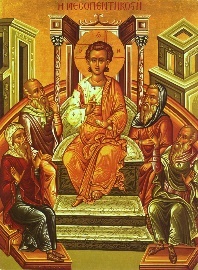
In the middle of this fourth week, the middle day between Easter and Pentecost is solemnly celebrated. It is called the feast of Mid-Pentecost, at which Christ, “in the middle of the feast” teaches men of his saving mission and offers to all “the waters of immortality” (Jn.7:14). Again we are reminded of the Master’s presence and his saving promise: “If anyone is thirsty let him come to Me and drink” (Jn.7:37). We think also once again of our death and resurrection with Christ in our baptism, and our reception of the Holy Spirit from him in our chrismation. We “look back to one, and anticipate the other” as one of the hymns of the feast puts it. We know that we belong to that kingdom of the Risen Christ where “the Spirit and the Bride say, ‘Come!’ And let him who is thirsty come, let him who desires take the water of life without price” (Rev.22:17; Is.55:1).
In the middle of the feast, O Saviour, fill my thirsting soul with the waters of godliness, as Thou didst cry unto all: If anyone is thirsty, let him come to me and drink! O Christ God, Fountain of life, glory to Thee! (Troparion).
Christ God, the Creator and Master of all, cried to all in the midst of the feast of the law: Come and drink the water of immortality! We fall before Thee and faithfully cry: Grant us Thy bounties, for Thou art the Fountain of our life! (Kontakion).
The Samaritan Woman

The fifth Sunday after Easter deals with the woman of Samaria with whom Christ spoke at Jacob’s Well (Jn.4). Again the theme is the “living water” and the recognition of Jesus as God’s Messiah (Jn.4:10–11, 25–26). We are reminded of our new life in Him, of our own drinking of the “living water,” of our own true worship of God in the Christian messianic age “in Spirit and in Truth” (Jn.4:23–24). We see as well that salvation is offered to all: Jews and Gentiles, men and women, saints and sinners.
The Blind Man
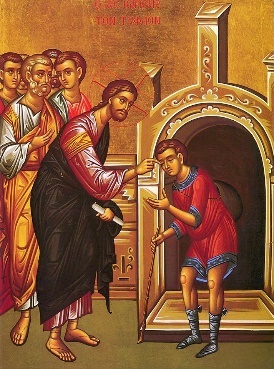
The sixth Sunday commemorates the healing of the man blind from birth (Jn.9). We are identified with that man who came to see and to believe in Jesus as the Son of God. The Lord has anointed our eyes with his own divine hands and washed them with the waters of our baptism (Jn.9:6–11).
Jesus used clay of spittle and told the man to wash in the waters of Siloam. He did so because it was the Sabbath day on which spitting, clay-making and washing were strictly forbidden. By breaking these ritual laws of the Jews, Jesus showed that He is indeed the Lord of the Sabbath, and, as such, that He is equal to God the Father Who alone, according to Jewish tradition, works on the Sabbath day in running His world.
There is scandal over the healing of the blind man on the Sabbath day. He is separated from the synagogue because of his faith in Christ. The entire Church follows this man in his fate, knowing that it is those who do not see Jesus as the Lord who are really blind and still in their sins (Jn.9:41). The others have the light of life and can see and know the Son of God, for “you have seen Him, and it is He who speaks to you” (Jn.9:37).
I come to Thee, O Christ, blind from birth in my spiritual eyes, and call to Thee in repentance: Thou art the most radiant Light of those in darkness! (Kontakion).
Ascension
Jesus did not live with His disciples after His resurrection as He had before His death. Filled with the glory of His divinity, He appeared at different times and places to His people, assuring them that it was He, truly alive in His risen and glorified body.
To them He presented Himself alive after His passion by many proofs, appearing to them during forty days, and speaking of the Kingdom of God (Acts.1:3).
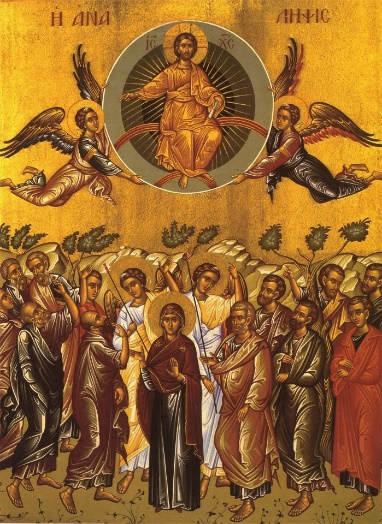
It should be noted that the time span of forty days is used many times in the Bible and signifies a temporal period of completeness and sufficiency (Gen.7:17; Ex.16:35, 24:18; Judg.3:11; 1Sam.17:16; 1Kg.19:8; Jon.3:4; Mt.4:2).
On the fortieth day after His passover, Jesus ascended into heaven to be glorified on the right hand of God (Acts.1:9–11; Mk.16:19; Lk.24:51). The ascension of Christ is His final physical departure from this world after the resurrection. It is the formal completion of His mission in this world as the Messianic Saviour. It is His glorious return to the Father Who had sent Him into the world to accomplish the work that He had given him to do (Jn.17:4–5).
. . . and lifting His hands He blessed them. While blessing them, He parted from them and was carried up into heaven. And they returned to Jerusalem with great joy (Lk.24:51–52).
The Church’s celebration of the ascension, as all such festal celebrations, is not merely the remembrance of an event in Christ’s life. Indeed, the ascension itself is not to be understood as though it were simply the supernatural event of a man floating up and away into the skies. The holy scripture stresses Christ’s physical departure and His glorification with God the Father, together with the great joy which His disciples had as they received the promise of the Holy Spirit Who was to come to assure the Lord’s presence with them, enabling them to be His witnesses to the ends of earth (Lk.24:48–53; Acts.1:8–11; Mt.28:20; Mk.16:16–14).
In the Church the believers in Christ celebrate these very same realities with the conviction that it is for them and for all men that Christ’s departure from this world has taken place. The Lord leaves in order to be glorified with God the Father and to glorify us with himself. He goes in order to “prepare a place” for and to take us also into the blessedness of God’s presence. He goes to open the way for all flesh into the “heavenly sanctuary . . . the Holy Place not made by hands” (see Hebrews 8–10). He goes in order send the Holy Spirit, Who proceeds from the Father to bear witness to Him and His gospel in the world, making Him powerfully present in the lives of disciples.
The liturgical hymns of the feast of the Ascension sing of all of these things. The antiphonal verses of the Divine Liturgy are taken from Psalms 47, 48, and 49. The troparion of the feast which is sung at the small entrance is also used as the post-communion hymn.
Thou hast ascended in glory O Christ our God, granting joy to Thy disciples by the promise of the Holy Spirit. Through the blessing they were assured that Thou art the Son of God, the Redeemer of the world! (Troparion).
When Thou didst fulfill the dispensation for our sake, and didst unite earth to heaven, Thou didst ascend in glory, O Christ our God, not being parted from those who love Thee, but remaining with them and crying: I am with you and no one will be against you! (Kontakion).
Pentecost: The Descent of the Holy Spirit

In the Old Testament Pentecost was the feast which occurred fifty days after Passover. As the passover feast celebrated the exodus of the Israelites from the slavery of Egypt, so Pentecost celebrated God’s gift of the ten commandments to Moses on Mount Sinai.
In the new covenant of the Messiah, the passover event takes on its new meaning as the celebration of Christ’s death and resurrection, the “exodus” of men from this sinful world to the Kingdom of God. And in the New Testament as well, the pentecostal feast is fulfilled and made new by the coming of the “new law,” the descent of the Holy Spirit upon the disciples of Christ.
When the day of Pentecost had come they were all together in one place. And suddenly a sound came from heaven like the rush of a mighty wind, and it filled all the house where they were sitting. And there appeared to them tongues as of fire, distributed as resting upon each one of them. And they were all filled with the Holy Spirit . . . (Acts.2:1–4).
The Holy Spirit that Christ had promised to his disciples came on the day of Pentecost (Jn.14:26, 15:26; Lk.24:49; Acts.1:5). The apostles received “the power from on high,” and they began to preach and bear witness to Jesus as the risen Christ, the King and the Lord. This moment has traditionally been called the birthday of the Church.
In the liturgical services of the feast of Pentecost, the coming of the Holy Spirit is celebrated together with the full revelation of the divine Trinity: Father, Son, and Holy Spirit. The fullness of the Godhead is manifested with the Spirit’s coming to man, and the Church hymns celebrate this manifestation as the final act of God’s self-disclosure and self-donation to the world of His creation. For this reason Pentecost Sunday is also called Trinity Day in the Orthodox tradition. Often on this day the icon of the Holy Trinity – particularly that of the three angelic figures who appeared to Abraham, the forefather of the Christian faith – is placed in the center of the church. This icon is used with the traditional pentecostal icon which shows the tongues of fire hovering over Mary and the Twelve Apostles, the original prototype of the Church, who are themselves sitting in unity surrounding a symbolic image of “cosmos,” the world.
On Pentecost we have the final fulfillment of the mission of Jesus Christ and the first beginning of the messianic age of the Kingdom of God mystically present in this world in the Church of the Messiah. For this reason the fiftieth day stands as the beginning of the era which is beyond the limitations of this world, fifty being that number which stands for eternal and heavenly fulfillment in Jewish and Christian mystical piety: seven times seven, plus one.
Thus, Pentecost is called an apocalyptic day, which means the day of final revelation. It is also called an eschatological day, which means the day of the final and perfect end (in Greek eschaton means the end). For when the Messiah comes and the Lord’s Day is at hand, the “last days” are inaugurated in which “God declares: . . . I will pour out my Spirit upon all flesh.”; This is the ancient prophecy to which the Apostle Peter refers in the first sermon of the Christian Church which was preached on the first Sunday of Pentecost (Acts.2:17; Joel.2:28–32).
Once again it must be noted that the feast of Pentecost is not simply the celebration of an event which took place centuries ago. It is the celebration of what must happen and does happen to us in the Church today. We all have died and risen with the Messiah-King, and we all have received his Most Holy Spirit. We are the “temples of the Holy Spirit.” God’s Spirit dwells in us (Rom.8; 1Cor.2–3, 12; 2Cor.3; Gal.5; Eph.2–3). We, by our own membership in the Church, have received “the seal of the gift of the Holy Spirit” in the sacrament of chrismation. Pentecost has happened to us.
The Divine Liturgy of Pentecost recalls our baptism into Christ with the verse from Galatians again replacing the Thrice-Holy Hymn. Special verses from the psalms also replace the usual antiphonal psalms of the liturgy. The epistle and gospel readings tell of the Spirit’s coming to men. The kontakion sings of the reversal of Babel as God unites the nations into the unity of his Spirit. The troparion proclaims the gathering of the whole universe into God’s net through the work of the inspired apostles. The hymns “O Heavenly King” and “We have seen the True Light” are sung for the first time since Easter, calling the Holy Spirit to “come and abide in us,” and proclaiming that “we have received the heavenly Spirit.” The church building is decorated with flowers and the green leaves of the summer to show that God’s divine Breath comes to renew all creation as the “life-creating Spirit.” In Hebrew the word for Spirit, breath and wind is the same word, ruah.
Blessed art Thou, O Christ our God, who hast revealed the fishermen as most wise by sending down upon them the Holy Spirit: through them Thou didst draw the world into Thy net. O Lover of Man, Glory to Thee (Troparion).
When the Most High came down and confused the tongues, he divided the nations. But when he distributed the tongues of fire, he called all to unity. Therefore, with one voice, we glorify the All-Holy Spirit! (Kontakion).
The Great Vespers of Pentecost evening features three long prayers at which the faithful kneel for the first time since Easter. The Monday after Pentecost is the feast of the Holy Spirit in the Orthodox Church, and the Sunday after Pentecost is the feast of All Saints. This is the logical liturgical sequence since the coming of the Holy Spirit is fulfilled in men by their becoming saints, and this is the very purpose of the creation and salvation of the world. “Thus says the Lord: Consecrate yourselves therefore, and be holy, for I your God am holy” (Lev.11:44–45; 1Pet.1:15–16).
Nativity of Christ
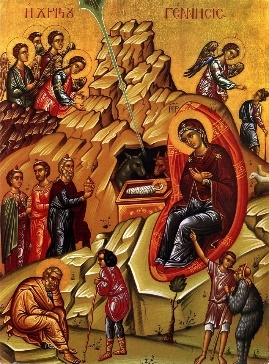
The celebration of the feast of the Nativity of Christ in the Orthodox Church is patterned after the celebration of the feast of the Lord’s Resurrection. A fast of forty days precedes the feast, with special preparatory days announcing the approaching birth of the Saviour. Thus, on Saint Andrew’s Day (November 30) and Saint Nicholas Day (December 6) songs are sung to announce the coming birthday of the Lord:
Adorn yourself, O Cavern. Make ready, O Manger. O Shepherds and wisemen, bring your gifts and bear witness. For the Virgin is coming bearing Christ in her womb (Vesperal Hymn of Saint Nicholas Day).
On the eve of Christmas, the Royal Hours are read and the Divine Liturgy of Saint Basil is served with Vespers. At these services the Old Testament prophecies of Christ’s birth are chanted, emphasizing the prophecy of Micah which foretells Bethlehem as the birthplace of the Saviour, and the prophecies of Isaiah about the appearance and character of the Messiah:
The Lord Himself will give you a sign. Behold a virgin shall conceive and bear a son, and shall call His name Immanuel, which translated is, God with us (Is.7:14–15).
God is with us, understand all ye nations, and submit yourselves, for God is with us (Is.8:9).
For unto us a Child is born, unto us a Son is given; and the government shall be upon His shoulders, and His name shall be called Wonderful, Counselor, the Everlasting Father, the Prince of Peace. Of the increase of His government and peace there will be no end (Is.9:6–7).
The Vigil of Christmas begins with Great Compline, highlighted once again by the solemn chanting of God is with us and the words of the prophecy of Isaiah. At Compline there is also the singing of the Troparion and Kontakion of the feast along with the special hymns glorifying the Saviour’s birth. There are also the special long litanies of intercession and the solemn blessing of the five loaves of bread together with the wheat and the wine of which the faithful partake and the oil with which they are anointed. This part of the festal vigil, which is done on all great feasts, is called the litya (in Greek, the artoklasia or the breaking of the bread).
At the beginning of the Christmas Matins, which together with Compline form the Christmas Vigil, the six matinal psalms begin as usual with the words: “Glory to God in the highest and on earth peace, good will among men” (Lk.2:14).
At the Christmas services these words of the angelic song are normally sung with great solemnity rather than being chanted as at the daily service. The Christmas Matins proceed as usual. The gospel reading from Matthew (1:18–25) tells of the birth of Christ, and all of the hymns and verses glorify His appearance on earth:
Christ is born, glorify Him. Christ is from heaven, go to meet Him. Christ is on earth, be ye lifted up. Sing to the Lord, all the earth. Sing out with gladness, all ye people. For He is glorified (First Ode of the Christmas Canon).
The Christmas Liturgy begins with psalms of glorification and praise. The troparion and kontakion mark the entrance with the Book of the Gospels. The baptismal line from Galatians 3.27 once again replaces the Thrice-Holy. The Epistle reading is from Galatians:
But when the time had fully come, God sent forth his Son, born of a woman, born under the law, to redeem those who were under the law, so that we might receive adoption as sons. And because you are sons, God has sent the Spirit of his Son into our hearts, crying, “Abba! Father!” So through God, you are no longer a slave but a son, and if a son then an heir (Gal.4:4–7).
The Gospel reading is the familiar Christmas story from Matthew (2:1–12), and the liturgy continues in the normal fashion. A specific two-day celebration follows, dedicated to Mary the Theotokos and Saint Stephen, the First Martyr. The period of Christmas rejoicing extends to Epiphany during which time the Christmas songs are sung and fasting and kneeling in prayer are not called for by the Church.
The feast of Christmas is formally entitled the Nativity in the Flesh of our Lord and God and Saviour Jesus Christ. At Christmas we celebrate the birth as a man of the Son of God, the one who together with the Father and the Holy Spirit is truly God from all eternity. Thus, we sing in the Church.
Today the Virgin gives birth to the Transcendent One, and the earth offers a cave to the Unapproachable One! Angels, with shepherds, glorify Him! The wise men journey with the star! Since for our sake the Eternal God is born as a little child (Kontakion).
The feast of Christmas was not a separate Church feast for the first four centuries of Christian history. It was celebrated with Epiphany in the one great feast of God’s appearance on earth in the form of the human Messiah of Israel. The Nativity began to be celebrated as such on the twenty-fifth of December in order to offset the pagan festival of the Invincible Sun which occurred on that day. It was established by the Church quite consciously as an attempt to defeat the false religion of the heathens. Thus, we discover the troparion of the feast making a polemic against the worship of the sun and the stars and calling for the adoration of Christ, the True Sun of Righteousness (Mal.4:2), who is Himself worshiped by all of the elements of nature.
Thy Nativity, O Christ our God, has shone to the world the light of wisdom! For by it, those who worshiped the stars were taught by a star to adore Thee, the Sun of Righteousness and to know Thee, the Orient from on high [Lk.1:78, translated as Dawn or Day spring]. O Lord, glory to Thee! (Troparion).
Thus, the feast of Christmas is the celebration of the world’s salvation through the Son of God who became man for our sake that, through him, we might ourselves become divine, sons of God the Father by the indwelling of his Holy Spirit in us.
Epiphany

The sixth of January is the feast of the Epiphany. Originally it was the one Christian feast of the “shining forth” of God to the world in the human form of Jesus of Nazareth. It included the celebration of Christ’s birth, the adoration of the Wisemen, and all of the childhood events of Christ such as His circumcision and presentation to the temple as well as His baptism by John in the Jordan. There seems to be little doubt that this feast, like Easter and Pentecost, was understood as the fulfillment of a previous Jewish festival, in this case the Feast of Lights.
Epiphany means shining forth or manifestation. The feast is often called, as it is in the Orthodox service books, Theophany, which means the shining forth and manifestation of God. The emphasis in the present day celebration is on the appearance of Jesus as the human Messiah of Israel and the divine Son of God, One of the Holy Trinity with the Father and the Holy Spirit.

Thus, in the baptism by John in the Jordan, Jesus identifies Himself with sinners as the “Lamb of God who takes away the sin of the world” (Jn.1:29), the “Beloved” of the Father whose messianic task it is to redeem men from their sins (Lk.3:21, Mk.1:35). And he is revealed as well as One of the Divine Trinity, testified to by the voice of the Father, and by the Spirit in the form of a dove. This is the central epiphany glorified in the main hymns of the feast:
When Thou, O Lord, wast baptized in the Jordan the worship of the Trinity was made manifest! For the voice of the Father bare witness to Thee, calling Thee his Beloved Son. And the Spirit, in the form of a dove, confirmed the truthfulness of his Word. O Christ our God, who hast revealed Thyself and hast enlightened the world, glory to Thee (Troparion).
Today Thou hast appeared to the universe, and Thy Light, O Lord, has shone on us, who with understanding praise Thee: Thou hast come and revealed Thyself, O Light Unapproachable! (Kontakion).
The services of Epiphany are set up exactly as those of Christmas, although historically it was most certainly Christmas which was made to imitate Epiphany since it was established later. Once again the Royal Hours and the Liturgy of Saint Basil are celebrated together with Vespers on the eve of the feast; and the Vigil is made up of Great Compline and Matins.
The prophecies of Epiphany repeat the God is with us from Isaiah and stress the foretelling of the Messiah as well as the coming of His forerunner, John the Baptist:
The voice of one crying in the wilderness: Prepare the way of the Lord, make His path straight. Every valley shall be filled and every mountain and hill brought low, and the crooked shall be made straight, and the rough ways shall be made smooth; and all flesh shall see the salvation of God (Is.40:3–5; Lk.3:4–6).
Once more special psalms are sung to begin the Divine Liturgy of the feast, and the baptismal line of Galatians 3:27 replaces the song of the Thrice-Holy. The gospel readings of all the Epiphany services tell of the Lord’s baptism by John in the Jordan River. The epistle reading of the Divine Liturgy tells of the consequences of the Lord’s appearing which is the divine epiphany.
For the grace of God has appeared for the salvation of all men, training us to renounce irreligion and worldly passions, and to live sober, upright and godly lives in this world, awaiting our blessed hope, the appearing of the glory of our great God and Saviour Jesus Christ, who gave himself for us to redeem us from all iniquity and to purify for himself a people of his own who are zealous for good deeds (Titus.2:11–14).
The main feature of the feast of the Epiphany is the Great Blessing of Water. It is prescribed to follow both the Divine Liturgy of the eve of the feast and the Divine Liturgy of the day itself. Usually it is done just once in parish churches at the time when most people can be present. It begins with the singing of special hymns and the censing of the water which has been placed in the center of the church building. Surrounded by candles and flowers, this water stands for the beautiful world of God’s original creation and ultimate glorification by Christ in the Kingdom of God. Sometimes this service of blessing is done out of doors at a place where the water is flowing naturally.
The voice of the Lord cries over the waters, saying: Come all ye, receive the Spirit of wisdom, the Spirit of understanding, the Spirit of the fear of God, even Christ who is made manifest.
Today the nature of water is sanctified. Jordan is divided in two, and turns back the stream of its waters, beholding the Master being baptized.
As a man Thou didst come to that river, O Christ our King, and dost hasten O Good One, to receive the baptism of a servant at the hands of the Forerunner [John], because of our sins, O Lover of Man (Hymns of the Great Blessing of Waters).
Following are three readings from the Prophecy of Isaiah concerning the messianic age:
Let the thirsty wilderness be glad, let the desert rejoice, let it blossom as a rose, let it blossom abundantly, let everything rejoice . . . (Is.35:1–10).
Go to that water, O you who thirst, and as many as have no money, let them eat and drink without price, both wine and fat . . . (Is.55:1–13).
With joy draw the water out of the wells of salvation. And in that day shall you say: Confess ye unto the Lord and call upon his Name; declare his glorious deeds . . . his Name is exalted . . . Hymn the Name of the Lord . . . Rejoice and exult . . . (Is.12:3.6).
After the epistle (1Cor.1:10–14) and the gospel reading (Mk.1:9–11) the special great litany is chanted invoking the grace of the Holy Spirit upon the water and upon those who will partake of it. It ends with the great prayer of the cosmic glorification of God in which Christ is called upon to sanctify the water, and all men and all creation, by the manifestation of his saving and sanctifying divine presence by the indwelling of the Holy and Good and Life-creating Spirit.
As the troparion of the feast is sung, the celebrant immerses the Cross into the water three times and then proceeds to sprinkle the water in the four directions of the world. He then blesses the people and their homes with the sanctified water which stands for the salvation of all men and all creation which Christ has effected by his “epiphany” in the flesh for the life of the world.
Sometimes people think that the blessing of water and the practice of drinking it and sprinkling it over everyone and everything is a “paganism” which has falsely entered the Christian Church. We know, however, that this ritual was practiced by the People of God in the Old Testament, and that in the Christian Church it has a very special and important significance.
It is the faith of Christians that since the Son of God has taken human flesh and has been immersed in the streams of the Jordan, all matter is sanctified and made pure in Him, purged of its death-dealing qualities inherited from the devil and the wickedness of men. In the Lord’s epiphany all creation becomes good again, indeed “very good,” the way that God Himself made it and proclaimed it to be in the beginning when “the Spirit of God was moving over the face of the waters” (Gen.1:2) and when the “Breath of Life” was breathing in man and in everything that God made (Gen.1:30, 2:7).
The world and everything in it is indeed “very good” (Gen.1:31) and when it becomes polluted, corrupted and dead, God saves it once more by effecting the “new creation” in Christ, his divine Son and our Lord by the grace of the Holy Spirit (Gal.6:15). This is what is celebrated on Epiphany, particularly in the Great Blessing of Water. The consecration of the waters on this feast places the entire world – through its “prime element” of watering the perspective of the cosmic creation, sanctification, and glorification of the Kingdom of God in Christ arid the Spirit. It tells us that man and the world were indeed created and saved in order to be “filled with all the fullness of God” (Eph.3:19), the “fullness of him who fills all in all” (Eph.1:22). It tells us that Christ, in Who in “the whole fullness of deity dwells bodily,” is and shall be truly “all, and in all” (Col.2:9, 3:11). It tells us as well that the “new heavens and the new earth” which God has promised through His prophets and apostles (Is.66:2; 2Peter.3:13; Rev.21:1) are truly “with us” already now in the mystery of Christ and His Church.
Thus, the sanctification and sprinkling of the Epiphany water is no pagan ritual. It is the expression of the most central fact of the Christian vision of man, his life and his world. It is the liturgical testimony that the vocation and destiny of creation is to be “filled with all the fullness of God” (Eph.3:19).
Meeting of the Lord
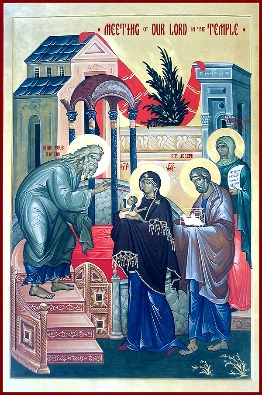
Forty days after Christ was born He was presented to God in the Jerusalem Temple according to the Mosaic Law. At this time as well His mother Mary underwent the ritual purification and offered the sacrifices as prescribed in the Law. Thus, forty days after Christmas, on the second of February, the Church celebrates the feast of the presentation called the Meeting (or Presentation or Reception) of the Lord.
The meeting of Christ by the elder Simeon and the prophetess Anna (Lk.2:22–36) is the main event of the feast of Christ’s presentation in the Temple. It was “revealed to Simeon by the Holy Spirit that he would not see death before he had seen the Lord’s Christ” (Lk.2:26) and, inspired by the same Spirit, he came to the Temple where he met the new-born Messiah, took Him in his arms and said the words which are now chanted each evening at the end of the Orthodox Vespers service:
Lord, now lettest Thou Thy servant depart in peace, according to Thy word; for mine eyes have seen Thy salvation which Thou hast prepared in the presence of all peoples, a light for the revelation to the Gentiles, and for glory to Thy people Israel (Lk.2:29–32).
At this time as well Simeon predicted that Jesus would be the “sign which is spoken against” and that He would cause “the fall and the rising of many in Israel.” He also foretold Mary’s sufferings because of her son (Luke.22:34–35). Anna also was present and, giving thanks to God “she spoke of Jesus to all who were looking for the redemption of Jerusalem” (Lk.2:38).
In the service of the feast of the Meeting of the Lord, the fact emphasized is that Christ, the Son and Word of God through Whom the world was created, now is held as an infant in Simeon’s hands; this same Son of God, the Giver of the Law, now Himself fulfills the Law, carried in arms as a human child.
Receive him, O Simeon, whom Moses on Mount Sinai beheld in the darkness as the Giver of the Law. Receive him as a babe now obeying the Law. For he it is of whom the Law and the Prophets have spoken, incarnate for our sake and saving mankind. Come let us adore him!
Let the door of heaven open today, for the Eternal Word of the Father, without giving up his divinity, has been incarnate of the Virgin in time. And as a babe of forty days he is voluntarily brought by his mother to the Temple, according to the Law. And the elder Simeon takes him in his arms and cries out: Lord now lettest Thou Thy servant depart in peace, for mine eyes have seen Thy salvation, O Lord, who has come to save the human race – glory to Thee! (Vespers Verses of the Feast).
The Vespers and Matins of the feast of the Meeting of the Lord are filled with hymns on this theme. The Divine Liturgy is celebrated with the lines from the canticle of Mary forming the prokeimenon and the words of Simeon being the verses for the Alleluia. The gospel readings tell of the meeting, while the Old Testament readings at Vespers refer to the Law of the purification in Leviticus, the vision of Isaiah in the Temple of the Thrice-Holy Lord, and the gift of faith to the Egyptians prophesied by Isaiah when the light of the Lord shall be a “revelation to the Gentiles” (Lk.2:32).
The celebration of the Meeting of the Lord in the church is not merely a historical commemoration. Inspired by the same Holy Spirit as Simeon, and led by the same Spirit into the Church of the Messiah, the members of the Church also can claim their own “meeting” with the Lord, and so also can witness that they too can “depart in peace” since their eyes have seen the salvation of God in the person of his Christ.
Rejoice, O Virgin Theotokos, Full of Grace! From you shone the Sun of Righteousness, Christ our God, enlightening those who sat in darkness! Rejoice and be glad, O righteous elder; you accepted in your arms the Redeemer of our souls who grants us the resurrection (Troparion).
By Thy nativity, Thou didst sanctify the Virgin’s womb. And didst bless Simeon’s hands, O Christ our God. Now Thou hast come and saved us through love. Grant peace to all Orthodox Christians, O only Lover of man (Kontakion).
It is customary in many churches to bless candles on the feast of the Meeting of the Lord.
Transfiguration

The transfiguration of Christ is one of the central events recorded in the gospels. Immediately after the Lord was recognized by His apostles as “the Christ [Messiah], the Son of the Living God,” He told them that “He must go up to Jerusalem and suffer many things . . . and be killed and on the third day be raised” (Mt.16). The announcement of Christ’s approaching passion and death was met with indignation by the disciples. And then, after rebuking them, the Lord took Peter, James, and John “up to a high mountain” – by tradition Mount Tabor – and was “transfigured before them.”
. . . and His face shone like the sun, and His garments became white as snow and behold, there appeared to them Moses and Elijah, talking with Him. And Peter said to Jesus, “Lord, it is well that we are here; if you wish I will make three booths here, one for You and one for Moses and one for Elijah.” He was still speaking when lo, a bright cloud overshadowed them, and a voice from the cloud said, “This is My Beloved Son, with Whom I am well pleased; listen to Him.” When the disciples heard this, they fell on their faces with awe. But Jesus came and touched them, saying, “Rise, and have no fear.” And when they lifted up their eyes, they saw no one but Jesus only. And as they were coming down the mountain, Jesus commanded them, “Tell no one the vision, until the Son of Man is raised from the dead” (Mt.17:1–92, see also Mk.9:1–9; Lk.9:28–36; 2Pet.1:16–18).
The Jewish Festival of Booths was a feast of the dwelling of God with men, and the transfiguration of Christ reveals how this dwelling takes place in and through the Messiah, the Son of God in human flesh. There is little doubt that Christ’s transfiguration took place at the time of the Festival of Booths, and that the celebration of the event in the Christian Church became the New Testamental fulfillment of the Old Testamental feast in a way similar to the feasts of Passover and Pentecost.
In the Transfiguration, the apostles see the glory of the Kingdom of God present in majesty in the person of Christ they see that “in Him, indeed, all the fullness of God was pleased to dwell,” that “in Him the whole fullness of deity dwells bodily” (Col.1:19, 2:9). They see this before the crucifixion so that in the resurrection they might know Who it is Who has suffered for them, and what it is that this one, Who is God, has prepared for those who love Him. This is what the Church celebrates in the feast of the Transfiguration.
Thou wast transfigured on the mount. O Christ God, revealing Thy glory to Thy disciples as they could bear it. Let Thine everlasting light shine upon us sinners. Through the prayers of the Theotokos, O Giver of Light, glory to Thee (Troparion).
On the mountain wast Thou transfigured, O Christ God, and Thy disciples beheld Thy glory as far as they could see it; so that when they would behold Thee crucified, they would understand that Thy suffering was voluntary, and would proclaim to the world that Thou art truly the Radiance of the Father (Kontakion).
Besides the fundamental meaning which the event of the Transfiguration has in the context of the life and mission of Christ, and in addition to the theme of the glory of God which is revealed in all of its divine splendor in the face of the Saviour, the presence of Moses and Elijah is also of great significance for the understanding and celebration of the feast. Many of the hymns refer to these two leading figures of the Old Covenant as do the three scripture readings of Vespers which tell of the manifestation of the glory of God to these holy men of old (Ex.24:12–18, 33:11–34:8; 1Kg.19:3–16).
Moses and Elijah, according to the liturgical verses, are not only the greatest figures of the Old Testament who now come to worship the Son of God in glory, they also are not merely two of the holy men to whom God has revealed himself in the prefigurative theophanies of the Old Covenant of Israel. These two figures actually stand for the Old Testament itself: Moses for the Law and Elijah for the Prophets. And Christ is the fulfillment of the Law and the Prophets (Mt.5:17).
They also stand for the living and dead, for Moses died and his burial place is known, while Elijah was taken alive into heaven in order to appear again to announce the time of God’s salvation in Christ the Messiah.
Thus, in appearing with Jesus on the mount of Transfiguration, Moses and Elijah show that the Messiah Saviour is here, and that He is the Son of God to Whom the Father Himself bears witness, the Lord of all creation, of the Old and New Testaments, of the living and the dead. The Transfiguration of Christ in itself is the fulfillment of all of the theophanies and manifestations of God, a fulfillment made perfect and complete in the person of Christ. The Transfiguration of Christ reveals to us our ultimate destiny as Christians, the ultimate destiny of all men and all creation to be transformed and glorified by the majestic splendor of God Himself.
There is little doubt that the feast of the Transfiguration of Christ belonged first to the pre-Easter season of the Church. It was perhaps celebrated on one of the Sundays of Lent, for besides certain historical evidence and the fact that today St Gregory Palamas, the great teacher of the Transfiguration of Christ, is commemorated during Lent, the event itself is one which is definitely connected with the approaching death and resurrection of the Saviour.
. . . for when they would behold Thee crucified, they would understand that Thy suffering was voluntary (Kontakion).
The feast of the Transfiguration is presently celebrated on the sixth of August, probably for some historical reason. The summer celebration of the feast, however, has lent itself very well to the theme of transfiguration. The blessing of grapes, as well as other fruits and vegetables on this day is the most beautiful and adequate sign of the final transfiguration of all things in Christ. It signifies the ultimate flowering and fruitfulness of all creation in the paradise of God’s unending Kingdom of Life where all will he transformed by the glory of the Lord.
Annunciation
The feast of the Annunciation of the Virgin Mary comes nine months before Christmas on the twenty-fifth of March. It is the celebration of the announcing of the birth of Christ to the Virgin Mary as recorded in the Gospel of Saint Luke.

In the sixth month the angel Gabriel was sent from God to a city of Galilee named Nazareth, to a virgin betrothed to a man whose name was Joseph, of the house of David; and the virgin’s name was Mary. And he came to her and said, “Hail, full of grace, the Lord is with you!” But she was greatly troubled at the saying, and considered in her mind what sort of greeting this might be. And the angel said to her, “Do not be afraid, Mary, for you have found favor with God. And behold, you will conceive in your womb and bear a Son, and you shall call His name Jesus. He will be great, and will be called the Son of the Most High; and the Lord God will give to Him the throne of His father David, and He will reign over the house of Jacob forever; and of His kingdom there will be no end.” And Mary said to the angel, “How can this be, since I have no husband?” And the angel said to her, “The Holy Spirit will come upon you, and the power of the Most High will overshadow you; therefore the Child to be born will be called holy, the Son of God. And behold, your kinswoman Elizabeth in her old age has also conceived a son, and this is the sixth month with her who was called barren. For with God nothing will be impossible.” And Mary said, “Behold, I am the handmaid of the Lord; let it be to me according to your word.” And the angel departed from her (Lk.1:26–38).
The services of the feast of the Annunciation, the Matins and the Divine Liturgy, stress again and again the joyous news of the salvation of men in the birth of the Saviour.
Today is the beginning of our salvation, the revelation of the eternal mystery. The Son of God becomes the Son of the virgin, as Gabriel announces the coming of Grace. Together with him let us cry to the Theotokos: Rejoice, O Full of Grace, the Lord is with you (Troparion).
A special feature of this feast is the Matinal Canon which has the character of a dialogue between the Archangel Gabriel and the Virgin Mary. Also among the more popular elements of the feast is the Magnification which has the form of our own salutation to the virgin mother with the words of the archangel:
With the voice of the archangel we cry to Thee, O Pure One: Rejoice, O Full of Grace, the Lord is with Thee! (Magnification).
The celebration of the Annunciation, therefore, is the feast of our own reception of the glad tidings of salvation, and our own glorification of the maiden Mary who becomes the Mother of God in the flesh.
Because the feast of the Annunciation normally comes during the season of Great Lent, the manner of celebration varies from year to year depending upon the particular day on which it falls. If the feast comes on a weekday of Lent, which is the most common case, the Divine Liturgy of the feast is served in the evening with Vespers and thus is celebrated after a full day of total abstinence. When this happens, the fasting rules for the Liturgy of the Presanctified Gifts are followed. The Divine Liturgy of the Annunciation is the only celebration of the eucharistic liturgy of Saint John Chrysostom allowed on a weekday of Great Lent.
Nativity of the Theotokos

In addition to the celebration of the Annunciation, there are three major feasts in the Church honoring Mary, the Theotokos. The first of these is the feast of her nativity which is kept on the eighth of September.
The record of the birth of Mary is not found in the Bible. The traditional account of the event is taken from the apocryphal writings which are not part of the New Testament scriptures. The traditional teaching which is celebrated in the hymns and verses of the festal liturgy is that Joachim and Anna were a pious Jewish couple who were among the small and faithful remnant – “the poor and the needy” – who were awaiting the promised messiah. The couple was old and childless. They prayed earnestly to the Lord for a child, since among the Jews barrenness was a sign of God’s disfavor. In answer to their prayers, and as the reward of their unwavering fidelity to God, the elderly couple was blessed with the child who was destined, because of her own personal goodness and holiness, to become the Mother of the Messiah-Christ.
Your nativity, O Virgin, has proclaimed joy to the whole universe. The Sun of Righteousness, Christ our God, has shone from you, O Theotokos. By annulling the curse he bestowed a blessing. By destroying death he has granted us eternal life (Troparion).
By your nativity, O most pure virgin, Joachim and Anna are freed from barrenness; Adam and Eve from the corruption of death. And we, your people, freed from the guilt of sin, celebrate and sing to you: The barren woman gives birth to the Theotokos, the Nourisher of our Life (Kontakion).
The fact that there is no Biblical verification of the facts of Mary’s birth is incidental to the meaning of the feast. Even if the actual background of the event as celebrated in the Church is questionable from an historical point of view, the divine meaning of it “for us men and for our salvation” is obvious. There had to be one born of human flesh and blood who would be spiritually capable of being the Mother of Christ, and she herself had to be born into the world of persons who were spiritually capable of being her parents.
The feast of the Nativity of the Theotokos, therefore, is a glorification of Mary’s birth, of Mary herself and of her righteous parents. It is a celebration as well of the very first preparation of the salvation of the world. For the “Vessel of Light,” the “Book of the Word of Life,” the “Door to the Orient,” the “Throne of Wisdom” is being prepared on earth by God Himself in the birth of the holy girl-child Mary.
The verses of the feast are filled with titles for Mary such as those in the quotations above. They are inspired by the message of the Bible, both the Old and New Testaments. The specific Biblical readings of the feast give indications of this.
At Vespers the three Old Testamental readings are “mariological” in their New Testamental interpretation. Thus, Jacob’s Ladder which unites heaven and earth and the place which is named “the house of God” and the “gate of heaven” (Gen.28:10–17) are taken, to indicate the union of God with men which is realized most fully and perfectly – both spiritually and physically – in Mary the Theotokos, Bearer of God: So also the vision of the temple with the “door ‘to the East’” perpetually closed and filled with the “glory of the Lord” symbolizes Mary, called in the hymns of the feast “the living temple of God filled with the divine Glory” (Ezek.43:27–44:4). Mary is also identified with the “house” which the Divine Wisdom has built for himself according to the reading from Proverbs.9:1–11.
The Gospel reading of Matins is the one read at all feasts of the Theotokos, the famous Magnificat from Saint Luke in which Mary says: “My soul magnifies the Lord and my spirit rejoices in God my Saviour, for he has regarded the low estate of his handmaiden, for behold, henceforth all generations will call me blessed” (Lk.1:47).
The epistle reading of the Divine Liturgy is the famous passage about the coming of the Son of God in “the form of a servant, being born in the likeness of man” (Phil.2:5–11) and the gospel reading is that which is always read for feasts of the Theotokos – the woman in the crowd glorifies the Mother of Jesus, and the Lord himself responds that the same blessedness which his mother receives is for all “who hear the word of God and keep it” (Lk.11:27–28).
Thus, on the feast of the Nativity of the Theotokos, as on all liturgical celebrations of Christ’s Mother, we proclaim and celebrate that through God’s graciousness to mankind every Christian receives what the Theotokos receives, the “great mercy” which is given to human persons because of Christ’s birth from the Virgin.
Entrance of the Theotokos to the Temple

The second great feast of the Theotokos is the celebration of her entrance as a child into the Jerusalem Temple which is commemorated on the twenty-first of November. Like the feast of her nativity, this feast of Mary is without direct biblical and historical reference. But like the nativity, it is a feast filled with important spiritual significance for the Christian believer.
The texts of the service tells how Mary was brought as a small child to the temple by her parents in order to be raised there among the virgins consecrated to the service of the Lord until the time of their betrothal in marriage. According to Church tradition, Mary was solemnly received by the temple community which was headed by the priest Zacharias, the father of John the Baptist. She was led to the holy place to be “nourished” there by the angels in order to become herself the “holy of holies” of God, the living sanctuary and temple of the Divine child who was to be born in her.
There is no doubt that the verses of the Old Testamental Psalm 45, used extensively in the services of the feast, provided a great inspiration for the celebration of Mary’s consecration to the service of God in the Jerusalem Temple.
Hear, O Daughter, and consider and incline your ear; forget your people and your father’s house, and the king will desire your beauty. Since he is your Lord, bow to him . . .
The princess is decked in her chamber with gold-woven robes, in many-colored robes she is led to her king, with her virgin companions, her escort, in her train.
With joy and gladness they are led along, as they enter the palace of the king.
Instead of your fathers shall be your sons; you will make them princes in all the earth. I will cause your name to be celebrated in all generations, therefore, the peoples will praise you forever and ever (Ps.45:10–17).
The Orthodox Church understands these words of the psalm to be a prophecy directly related to Mary the Theotokos. According to the Gospel of Saint Luke which is read at the Vigil of each of her feasts, Mary herself speaks the following words:
My soul magnifies the Lord and my Spirit rejoices in God my Saviour, for He has regarded the low estate of His handmaiden. For behold, hence-forth all generations shall call me blessed; for He who is mighty has done great things for me and holy is His name. And His mercy is on those who fear Him from generation to generation (Lk.1:47–50).
The main theme of the feast of Mary’s entrance to the Temple, repeated many times in the liturgical services, is the fact that she enters the Temple to become herself the living temple of God, thus inaugurating the New Testament in which are fulfilled the prophecies of old that “the dwelling of God is with man” and that the human person is the sole proper dwelling place of the Divine Presence (Ezek.37:27; Jn.14:15–23; Acts.7:47; 2Cor.6:11; Eph.2:18–22; 1Pet.2:4; Rev.22:1–4).
Today is the preview of the good will of God, of the preaching of the salvation of mankind. The Virgin appears in the temple of God, in anticipation proclaiming Christ to all. Let us rejoice and sing to her: Rejoice, O Divine Fulfillment of the Creator’s dispensation (Troparion).
The most pure Temple of the Saviour, the precious Chamber and Virgin, the Sacred Treasure of the Glory of God, is presented today to the house of the Lord. She brings with her the grace of the Spirit, which the angels of God do praise. Truly this woman is the Abode of Heaven! (Kontakion).
The fortieth chapter of Exodus about the building of the tabernacle is read at Vespers, together with passages from the First Book of Kings and the Prophecy of Ezekiel. Each one of these readings all end with exactly the same line, “for the glory of the Lord filled the house [tabernacle] of the Lord God Almighty” (Ex. 40:35; 1Kg.8:11; Ezek.44:4).
Once again on this feast, the Old Testament readings are interpreted as symbols of the Mother of God. This “glory of the Lord” is referred to the Mother of Christ and it “fills” her and all people after her who “hear the word of God and keep it” as the Gospel of the festal liturgy proclaims (Lk.11:37–28). The epistle reading at the Divine Liturgy also proclaims this very same theme (Heb.9:1–7).
Thus, the feast of the Entrance of the Theotokos into the Temple is the feast which celebrates the end of the physical temple in Jerusalem as the dwelling place of God. When the child Mary enters the temple, the time of the temple comes to an end and the “preview of the good will of God” is shown forth. On this feast we celebrate – in the person of Christ’s mother – that we too are the house and tabernacle of the Lord.
. . . We are the temple of the living God, as God said, “I will live in them and move among them, and I will be their God, and they shall be my people” (2Cor.6:16; Is.52:11).
Dormition of the Theotokos
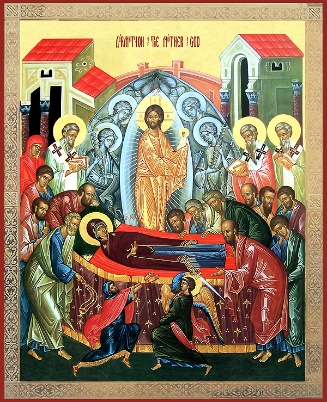
The feast of the Dormition or Falling-asleep of the Theotokos is celebrated on the fifteenth of August, preceded by a two-week fast. This feast, which is also sometimes called the Assumption, commemorates the death, resurrection and glorification of Christ’s mother. It proclaims that Mary has been “assumed” by God into the heavenly kingdom of Christ in the fullness of her spiritual and bodily existence.
As with the nativity of the Virgin and the feast of her entrance to the temple, there are no biblical or historical sources for this feast. The Tradition of the Church is that Mary died as all people die, not “voluntarily” as her Son, but by the necessity of her mortal human nature which is indivisibly bound up with the corruption of this world.
The Orthodox Church teaches that Mary is without personal sins. In the Gospel of the feast, however, in the liturgical services and in the Dormition icon, the Church proclaims as well that Mary truly needed to be saved by Christ as all human persons are saved from the trials, sufferings and death of this world; and that having truly died, she was raised up by her Son as the Mother of Life and participates already in the eternal life of paradise which is prepared and promised to all who “hear the word of God and keep it” (Lk.11:27–28).
In giving birth, you preserved your virginity. In falling asleep you did not forsake the world, O Theotokos. You were translated to life, O Mother of Life, and by your prayers, you deliver our souls from death (Troparion).
Neither the tomb, nor death, could hold the Theotokos, who is constant in prayer and our firm hope in her intercessions. For being the Mother of Life, she was translated to life, by the One who dwelt in her virginal womb (Kontakion).
The services of the feast repeat the main theme, that the Mother of Life has “passed over into the heavenly joy, into the divine gladness and unending delight” of the Kingdom of her Son (Vesperal hymn). The Old Testament readings, as well as the gospel readings for the Vigil and the Divine Liturgy, are exactly the same as those for the feast of the Virgin’s nativity and her entrance into the Temple. Thus, at the Vigil we again hear Mary say: “My soul magnifies the Lord and my Spirit rejoices in God my Saviour” (Lk.1:47). At the Divine Liturgy we hear the letter to the Philippians where Saint Paul speaks of the self-emptying of Christ who condescends to human servitude and ignoble death in order to be “highly exalted by God his Father” (Phil.2:5–11). And once again we hear in the Gospel that Mary’s blessedness belongs to all who “hear the word of God and keep it” (Lk.11:27–28).
Thus, the feast of the Dormition of the Theotokos is the celebration of the fact that all men are “highly exalted” in the blessedness of the victorious Christ, and that this high exaltation has already been accomplished in Mary the Theotokos. The feast of the Dormition is the sign, the guarantee, and the celebration that Mary’s fate is, the destiny of all those of “low estate” whose souls magnify the Lord, whose spirits rejoice in God the Saviour, whose lives are totally dedicated to hearing and keeping the Word of God which is given to men in Mary’s child, the Saviour and Redeemer of the world.
Finally it must be stressed that, in all of the feasts of the Virgin Mother of God in the Church, the Orthodox Christians celebrate facts of their own lives in Christ and the Holy Spirit. What happens to Mary happens to all who imitate her holy life of humility, obedience, and love. With her all people will be “blessed” to be “more honorable than the cherubim and beyond compare more glorious than the seraphim” if they follow her example. All will have Christ born in them by the Holy Spirit. All will become temples of the living God. All will share in the eternal life of His Kingdom who live the life that Mary lived.
In this sense everything that is praised and glorified in Mary is a sign of what is offered to all persons in the life of the Church. It is for this reason that Mary, with the divine child Jesus within her, is called in the Orthodox Tradition the Image of the Church. For the assembly of the saved is those in whom Christ dwells.
It is the custom in some churches to bless flowers on the feast of the Dormition of the Holy Theotokos.
Elevation of the Cross
The Elevation of the Cross, celebrated on the fourteenth of September, commemorates the finding of Christ’s Cross by Saint Helen, the mother of the Emperor Constantine in the fourth century; and, after it was taken by the Persians, of its recovery by the Emperor Heraclius in the seventh century at which time it was “elevated” in the Church of the Resurrection in Jerusalem. From this latter event the “universal elevation” of the Cross was celebrated annually in all of the churches of the Christian Empire.

The day of the Elevation of the Cross became, as it were, the national holiday of the Eastern Christian Empire similar to the Fourth of July in the United States. The Cross, the official emblem of the Empire which was placed on all public buildings and uniforms, was officially elevated on this day by the bishops and priests. They blessed the four directions of the universe with the Cross, while the faithful repeated the chanting of “Lord have mercy.” This ritual is still done in the churches today after the solemn presentation and elevation of the Cross at the end of the Vigil service of the holy day following the Great Doxology of Matins.
The troparion of the feast which was, one might say, the “national anthem” sung on all public occasions in the Christian Empires of Byzantium and Russia, originally petitioned God to save the people, to grant victory in war and to preserve the empire “by the virtue of the Cross.” Today the troparion, and all the hymns of the day, are “spiritualized” as the “adversaries” become the spiritually wicked and sinful including the devil and his armies, and “Orthodox Christians” replace the names of ruling officials of the Empire.
O Lord, save Thy people and bless Thine inheritance. Grant victories to the Orthodox Christians over their adversaries; and by the virtue of Thy Cross, preserve Thy habitation (Troparion).
As Thou was mercifully crucified for our sake, grant mercy to those who are called by Thy name; make all Orthodox Christians glad by Thy power, granting them victories over their adversaries, by bestowing on them the invincible trophy, Thy weapon of peace (Kontakion).
The holy day of the Elevation of the Cross, although it has an obviously “political” origin, has a place of great significance in the Church today. It remains with us as a day of fasting and prayer, a day when we recall that the Cross is the only sign worthy of our total allegiance, and that our salvation comes not by “victories” of any earthly sort but by the only true and lasting victory of the crucifixion of Christ and our co-crucifixion with him.
When we elevate the Cross and bow down before it in veneration and worship to God, we proclaim that we belong to the Kingdom “not of this world,” and that our only true and enduring citizenship is with the saints in the “city of God” (Eph.2:19; Heb.11:10; Rev.21–22).
The first Old Testamental reading of the Vespers of the day tells of the “tree” which changes the bitter waters into sweetness – the symbol of the Tree of the Cross (Ex.15:22–16:1). The second reading reminds us that the Lord chastens and corrects those whom He loves and that Divine Wisdom is “a Tree of life to those who lay hold upon her and trust in her, as in the Lord” (Prov.3:11–18). Again the reference is to the Cross which is, as the epistle reading of the day proclaims, “to those who are called . . . the power of God and the wisdom of God” (1Cor.1:24).
The third Old Testament reading is from the Prophecy of Isaiah which tells of the “city of the Lord” where both Jews and Gentiles will live together and “shall bow themselves down” at the place of God’s feet and “shall know that I the Lord am Thy Saviour and Thy Redeemer, the mighty One of Israel” (Is 60:11–16). Here we have the direct reference to God’s city where men shall worship at His feet; and together with the psalm line repeated constantly during the services which calls us to “bow before His footstool,” we have once again the reference to the Holy Cross (Ps.99:5, 110:1, et al.).
Before Thy Cross, we bow down in worship, O Master, and Thy holy resurrection, we glorify (Hymn of Veneration before the Cross).
This central hymn of the Elevation of the Cross which lasts for eight days in the Church is sung many times. It replaces the Thrice-Holy of the Divine Liturgy. The normal antiphons are also replaced by special verses from the psalms which have direct reference to Christ’s crucifixion on the Cross (Ps.22, 74, 99). At the Matins, in the gospel reading from Saint John, Christ says that when He is elevated on the Cross He will draw all men to Himself (Jn.12:28–36). The long gospel reading at the Divine Liturgy is the passion account from this same gospel.
Thus, at the Elevation of the Cross the Christians make their official rededication to the crucified Lord and pledge their undivided allegiance to Him by the adoration of His holy feet nailed to the life-creating Cross. This is the meaning of this holy day of fasting and repentance in the Church today.
Other Feasts
On each day of the year the Orthodox Church commemorates certain saints or sacred events in its history. In addition to the twelve major feast days mentioned above, the entire Orthodox Church celebrates a number of other days with special liturgical and spiritual solemnity.


First among the feasts universally celebrated by all the Orthodox are those of Saint John the Baptist (on left) of whom Christ has said that “among those born of women there has arisen none greater” (Mt.11:11; Lk.7:28).
The feasts of the apostles are also celebrated in all the churches, particularly the feast of Saints Peter and Paul (on right) which is preceded by a prescribed fasting period.
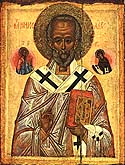
Certain other saints are especially venerated throughout the world as well, such as Saints Nicholas (on left) and George, the Prophet Elias and the Archangel Michael, together with the hierarchs, Saints Basil the Great, John Chrysostom, and Gregory the Theologian.
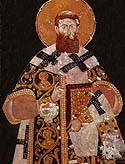
Each local church also has its own particularly holy days. In the Greek Church Saints Spiridon, Demetrios, Nektarios, and others are highly venerated, just as Saints Sergius, Seraphim, Tikhon, and Vladimir are in the Russian Church; Saint Sava (on right) in the Serbian Church; and Saint Herman in the American Church.
In addition to those special festal days of the particular national churches, there exists also the practice for certain cities, towns and monasteries to have liturgical celebrations of holy persons or events proper to their own particular interests and desires. Thus there exist certain saints, for example, which are celebrated with great solemnity in just a very few places in the Church, perhaps even in just one particular place where they have a special importance for the faithful.
It is necessary to note that in the Orthodox Church the liturgical feasts are not “institutions” which are legislated by some ecclesiastical authority apart from the interest and consent of the people. The feasts of the Church, and even the canonization of saints, always follows from the living devotion of the Christian people. If there were no popular interest and veneration of a certain holy person, there would be no official canonization and no liturgical festival established in his or her honor. Once a person is recognized as a saint, however, and it is agreed that God himself is presenting this person as a living witness to himself and his Kingdom, then the Church hierarchy will set the day of the feast and will compose the proper liturgical service and hymns to be used in the celebration. The frequency and fervor of the celebration will then depend solely upon the will of the people, and once established the feast could only disappear organically, in a way similar to its appearance. It would not, and indeed it really could not be “disestablished” by the decree of any church authority.
The Divine Liturgy
The word liturgy means common work or common action. The Divine Liturgy is the common work of the Orthodox Church. It is the official action of the Church formally gathered together as the chosen People of God. The word church, as we remember, means a gathering or assembly of people specifically chosen and called apart to perform a particular task.
The Divine Liturgy is the common action of Orthodox Christians officially gathered to constitute the Orthodox Church. It is the action of the Church assembled by God in order to be together in one community to worship, to pray, to sing, to hear God’s Word, to be instructed in God’s commandments, to offer itself with thanksgiving in Christ to God the Father, and to have the living experience of God’s eternal kingdom through communion with the same Christ Who is present in his people by the Holy Spirit.
The Divine Liturgy is always done by Orthodox Christians on the Lord’s Day which is Sunday, the “day after Sabbath” which is symbolic of the first day of creation and the last day – or as it is called in Holy Tradition, the eighth day – of the Kingdom of God. This is the day of Christ’s resurrection from the dead, the day of God’s judgment and victory predicted by the prophets, the Day of the Lord which inaugurates the presence and the power of the “kingdom to come” already now within the life of this present world.
The Divine Liturgy is also celebrated by the Church on special feast days. It is usually celebrated daily in monasteries, and in some large cathedrals and parish churches, with the exception of the week days of Great Lent when it is not served because of its paschal character.
As the common action of the People of God, the Divine Liturgy may be celebrated only once on any given day in an Orthodox Christian community. All of the members of the Church must be gathered together with their pastor in one place at one time. This includes even small children and infants who participate fully in the communion of the liturgy from the day of their entrance into the Church through baptism and chrismation. Always everyone, always together. This is the traditional expression of the Orthodox Church about the Divine Liturgy.
Because of its common character, the Divine Liturgy may never be celebrated privately by the clergy alone. It may never be served just for some and not for others, but for all. It may never be served merely for some private purposes or some specific or exclusive intentions. Thus there may be, and usually are, special petitions at the Divine Liturgy for the sick or the departed, or for some very particular purposes or projects, but there is never a Divine Liturgy which is done exclusively for private individuals or specific isolated purposes or intentions. The Divine Liturgy is always “on behalf of all and for all.”
Because the Divine Liturgy exists for no other reason than to be the official all-inclusive act of prayer, worship, teaching, and communion of the entire Church in heaven and on earth, it may not be considered merely as one devotion among many, not even the highest or the greatest. The Divine Liturgy is not an act of personal piety. It is not a prayer service. It is not merely one of the sacraments. The Divine Liturgy is the one common sacrament of the very being of the Church itself. It is the one sacramental manifestation of the essence of the Church as the Community of God in heaven and on earth. It is the one unique sacramental revelation of the Church as the mystical Body and Bride of Christ.
As the central mystical action of the whole church, the Divine Liturgy is always resurrectional in spirit. It is always the manifestation to his people of the Risen Christ. It is always an outpouring of the life-creating Spirit. It is always communion with God the Father. The Divine Liturgy, therefore, is never mournful or penitential. It is never the expression of the darkness and death of this world. It is always the expression and the experience of the eternal life of the Kingdom of the Blessed Trinity.

Saint Basil the Great
The Divine Liturgy celebrated by the Orthodox Church is called the Liturgy of Saint John Chrysostom. It is a shorter liturgy than the so-called Liturgy of Saint Basil the Great that is used only ten times during the Church Year. These two liturgies probably received their present form after the ninth century. It is not the case that they were written exactly as they now stand by the saints whose names they carry. It is quite certain, however, that the eucharistic prayers of each of these liturgies were formulated as early as the fourth and fifth centuries when these saints lived and worked in the Church.

Saint John Chrysostom
The Divine Liturgy has two main parts. The first part is the gathering, called the synaxis. It has its origin in the synagogue gatherings of the Old Testament, and is centered in the proclamation and meditation of the Word of God. The second part of the Divine Liturgy is the eucharistic sacrifice. It has its origin in the Old Testament temple worship, the priestly sacrifices of the People of God; and in the central saving event of the Old Testament, the Passover (Pascha).
In the New Testament Church Jesus Christ is the Living Word of God, and it is the Christian gospels and apostolic writings which are proclaimed and meditated at the first part of the Divine Liturgy. And in the New Testament Church, the central saving event is the one perfect, eternal and all-sufficient sacrifice of Jesus Christ, the one great High Priest who is also the Lamb of God slain for the salvation of the world, the New Passover. At the Divine Liturgy the faithful Christians participate in the voluntary self-offering of Christ to the Father, accomplished once and for all upon the Cross by the power of the Holy Spirit. In and through this unique sacrifice of Christ, the faithful Christians receive Holy Communion with God.
For centuries it was the practice of the Church to admit all persons to the first part of the Divine Liturgy, while reserving the second part strictly for those who were formally committed to Christ through baptism and chrismation in the Church. Non-baptized persons were not permitted even to witness the offering and receiving of Holy Communion by the faithful Christians. Thus the first part of the Divine Liturgy came to be called the Liturgy of the Catechumens, that is, the liturgy of those who were receiving instructions in the Christian Faith in order to become members of the Church through baptism and chrismation. It also came to be called, for obvious reasons, the Liturgy of the Word. The second part of the Divine Liturgy came to be called the Liturgy of the Faithful.
Although it is generally the practice in the Orthodox Church today to allow non-Orthodox Christians, and even non-Christians, to witness the Liturgy of the Faithful, it is still the practice to reserve actual participation in the sacrament of Holy Communion only to members of the Orthodox Church who are fully committed to the life and teachings of the Orthodox Faith as preserved, proclaimed and practiced by the Church throughout its history.
In the commentary on the Divine Liturgy which follows, we will concentrate our attention on what happens to the Church at its “common action.” By doing this we will attempt to penetrate the fundamental and essential meaning of the liturgy for man, his life and his world. This will be a definite departure from the interpretation of the Divine Liturgy which treats the service as if it were a drama enacted by the clergy and “attended” by the people, in which each part stands for some aspect of Christ’s life and work (e.g., the prothesis stands for Christ’s birth, the small entrance for the beginning of his public ministry, the gospel for his preaching, the great entrance for Palm Sunday, etc.). This latter type of interpretation of the Divine Liturgy is an invention, which, although perhaps interesting and inspiring for some, is nevertheless completely alien to the genuine meaning and purpose of the Divine Liturgy in the Orthodox Church.
Prothesis
| Before the actual beginning of the Divine Liturgy, the priest enters the Church with special prayers (photo #1), and puts on his liturgical vestments (photos #2–6). | |
 | Entrance Prayers #1: Read before the Royal Doors |
 | The Vesting #2: The Sticharion represents the Baptismal Garment |
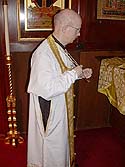 | #3: The Stole or Epitrachilion represents the dignity of the office of Priest |
 | #4: The Belt or “Zone” represents the wisdom and strength of the office of Priest |
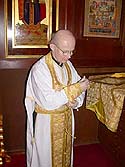 | #5: The Cuffs or “Epimanikia” represents the reminder that the Priest is tied against sin |
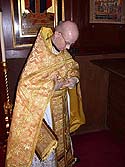 | #6: “Phelonion” represents the Priest putting on the gifts of the Holy Spirit |
 | #7: A Priest Fully Vested |
 | #8: The Priest washes his hands before beginning any of the sacred functions of the Divine Liturgy |
| He then goes to the table of oblation to prepare the bread and wine for Holy Communion. This part of the liturgy is called the prothesis or proskomede, which means preparation. | |
 | The Diskos (L) and Chalice (R) before the start of the Proskomedia |
| In its present form, the prothesis probably dates from the fourteenth century. When a bishop is celebrating the Divine Liturgy, the prothesis is performed just before the offertory procession called the Great Entrance. Otherwise it is done before the beginning of the Liturgy of the Word. At the prothesis the priest first cuts a large cube of bread from the loaf of bread, traditionally called the prosphora, which means the offering. This cube of bread is called the Lamb. It stands for Christ, the “Bread of life . . . which came down from heaven,” the “Lamb of God who takes away the sin of the world” (Jn.3:24, 6:32–15). | |
 | The prothesis begins. |
| While the priest is cutting the Lamb from the prosphora bread, he recites a verse from the Prophecy of Isaiah: “He was lead as a lamb to the slaughter . . .” (Is.53:7–8). He cuts the Lamb so that the seal with which the prosphora bread is sealed is on top, in the center. The seal is a square with the symbols of Jesus Christ (IC XC) on the top and The Victor (NI KA) on the bottom. The Lamb is then cut from the bottom in the sign of a cross so that it can be easily broken into four pieces at the time of Holy Communion in the liturgy. The priest also symbolically pierces the side of the Lamb with the liturgical knife, traditionally called the spear, reciting the words of John.19:34–35. | |
 | The wine and water are poured into the Chalice |
 | The next prosphora is blessed |
| After having poured wine mixed with water into the chalice, the priest then places a piece of bread on the diskos next to the Lamb in remembrance of the Theotokos. | |
 | The Lamb and the portion of bread for the Theotokos, the Mother of God |
| Then pieces of bread are placed on the diskos in memory of John the Baptist, the prophets, apostles, hierarchs, martyrs, monastic saints, healers, and the whole company of the righteous with special mention of the saints commemorated on that particular day. Finally a piece of bread is placed on the diskos in memory of the saint whose liturgy is being celebrated. | |
 | The particles of bread are taken from the prosphora |
 | And placed on the Diskos |
 | |
 | |
| In addition, pieces of bread are placed on the diskos for the bishop of the given church, for the civil authorities of the country and for all the faithful both living and dead, once more with particular mention by name of those particularly remembered by the local community. | |
 | Names of the living and the dead are given to the Priest for commemoration during the prothesis |
 | |
 | The commemorations are completed |
| The diskos and the chalice are then covered with special covers. | |
 | |
 | Individual covers are placed over both the Diskos and Chalice |
 | |
| While the priest recites Psalm 93, and other psalm verses with the offering of incense. | |
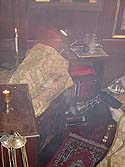 | Finally, the Aer is placed over both the Chalice and Diskos and Incenseis offered over the Holy Gifts as the Priest reads the prayers |
| He finally recites in conclusion the following prayer: O God, our God, who didst send down the Heavenly Bread, the Food for the whole world, our Lord and God Jesus Christ, to be our Savior, Redeemer, and Benefactor, blessing and sanctifying us; Bless this offering, and accept it upon Thy heavenly altar. Remember those who offer it and for whom it is offered, for Thou art good and lovest mankind. Preserve us blameless in the celebration of Thy divine mysteries. For sanctified and glorified is Thy most honorable and majestic name; of the Father and of the Son and of the Holy Spirit, now and ever and unto ages of ages. Amen. The small dismissal and benediction follow this prayer, thus ending the service of the prothesis. The prothesis is a rather late development in the history of the Divine Liturgy. It signifies the fathering of the entire Church of God into one great assembly: Christ the Head, together with the Theotokos and all the members of his Body, those already glorified with him in the presence of the Father, together with all of the faithful disciples on earth. The prothesis clearly shows that the eucharistic liturgy is always the action of the entire Church, with its head Jesus Christ, and is always offered “on behalf of all and for all.” | |
Blessed is the Kingdom
| Following the prothesis the priest (or deacon) incenses the altar, the icons, and the entire church. | |
 | Incense is offered to God |
 | The Priest censes throughout the entire Church |
 | |
| While incensing the altar table he recites lines which confess the fullness of Christ’s presence, in the grave, in death, in paradise, at the right hand of the Father, “filling all things, Thyself uncircumscribed.” He also recites Psalm 51: “Have mercy on me, O God.” | |
 | After incensing, the clergy pray “O Heavenly King”, begging for the presence of the Holy Spirit. |
| They recite the angelic salutation: “Glory to God in the highest and on earth peace, good will towards men.” | |
 | The royal doors of the iconostasis are opened and the Liturgy begins. |
| The first exclamation of the Divine Liturgy reveals the key to the entire celebration: Blessed is the Kingdom of the Father and of the Son and of the Holy Spirit, now and ever and unto ages of ages. With these words the celebrant announces the source and the goal of the divine service of the People of God, the very context and contents of the entire liturgical action. It is the Kingdom of God brought to the world by Jesus Christ, the Son of God, and mystically reigning already in the faithful disciples of Christ by the presence and power of the Holy Spirit. The Kingdom of God is eternal life in communion with God in loving obedience to his divine will. It is life in union with the Blessed Trinity; life lived toward the Father, through the Son, in the Holy Spirit. It is the life which Christ has given to men by his incarnation, crucifixion, resurrection, and glorification. It is the life to be lived already in this world by the People of God. | |
 |
To bless the Kingdom of God means to love it as one’s most precious possession. The response of the people to the proclamation of blessing by the priest is with the word Amen, which means so be it. This is the solemn affirmation that indeed the blessing of God’s Kingdom is fitting and proper. It is the official confirmation that this Kingdom is indeed the “pearl of great price” for the faithful, which once having found it, they will love it and serve it and desire to have it forever (Lk.13:14).
Only the Divine Liturgy and the other sacraments and services of the Church which were originally integrated into the eucharistic celebration, such as baptism, chrismation, and marriage begin with the solemn blessing of the Kingdom of God.
Great Litany
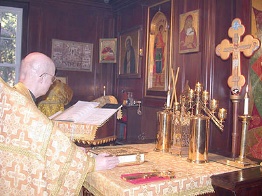
After the opening proclamation, the Great Litany is chanted. This litany begins every liturgical service of the Orthodox Church, as well as virtually all sacraments and special services. It is the all-embracing prayer of the Church for everyone and everything. It consists of petitions to which the people respond: Lord have mercy.
The Great Litany begins with prayers “in peace” and “for peace.” The people then proceed in the litany to pray for their eternal salvation; for the welfare of God’s churches and for the union of all; for the faithful and God-fearing of the particular community; for the bishops, priests, deacons and all the people of the Church; for the nation and its institutions for which all are responsible: the president, civil authorities and armed forces; for the given city and country and for all cities and countries; for good weather and abundant crops; for travelers, for the sick, the suffering and those in captivity.
Finally, after asking God for the deliverance from everything harmful and negative and for his divine help, salvation, mercy and protection, the people remember the Theotokos and all the saints and commend themselves and each other and all their life to Christ their God.
The Great Litany then ends with a doxology proper to the Holy Trinity to whom are due all glory, honor and worship forever. Once more the prayer is completed by the Amen of the people.
Antiphons
After the Great Litany, psalm verses are chanted proper to the particular occasion. These psalm verses are called the antiphons because they were, and sometimes still are sung by the people in two choirs, each responding antiphonally to the other. There are three sets of antiphons at each Divine Liturgy.
Historically the antiphons were chanted by the people in solemn procession to the church where the Divine Liturgy of the day was to be celebrated. Today, although they are now part of the service itself, they still form the joyful preparation for entrance into the worship of Christ through the Word of the Gospel and the offering and receiving of Holy Communion.
The psalms normally sung as the antiphons at the Divine Liturgy of the Lord’s Day are Psalms 103and 146. On feast days other psalms are used with particular relevance to the special celebration. To these psalm verses, refrains are added proper to the occasion.
Following the second antiphon, a hymn by the Emperor Justinian, Only-begotten Son, is always sung. It is a hymn of faith in the divinity of Christ and his incarnation, crucifixion, and resurrection as “one of the Holy Trinity” for the salvation of men.
In addition to the two sets of antiphons and the singing of Only-begotten Son, which belong to every Divine Liturgy, a third antiphon is chanted which on normal Sundays in most Orthodox Churches is the Beatitudes of Christ’s Sermon on the Mount according to the Gospel of Saint Matthew (Mt.5:3–12). The Beatitudes are sung with the refrain taken from the words of the Good Thief on the Cross: Remember us, O Lord, when Thou comest in Thy Kingdom (Lk.23:42). On festal occasions special psalm verses with the singing of the Troparion of the day constitute the third antiphon at the Divine Liturgy.
Small Entrance
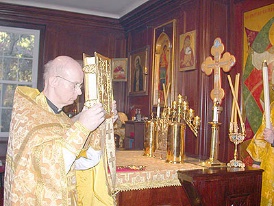
During the singing of the third antiphon, whether it be the Beatitudes or the Troparion of the day, the so-called Small Entrance is made. The Small Entrance is the solemn procession of the clergy to the altar led by the Book of the Gospels. If the bishop is celebrating, the Gospel Book is brought out to him in the center of the church in the midst of the people where he has been standing from the beginning of the liturgy.
After the exclamation: “Wisdom! Let Us Attend!” the clergy enter the royal gates of the iconostasis while all sing the Hymn of Entrance:
O come, let us worship and fall down before Christ. O Son of God . . . Save us who sing unto Thee: Alleluia.
A special line is added before the final phrase of the entrance hymn at each liturgy, proper to the celebration. Thus, for example, on the Lord’s Day this line would always be, “Who rose from the dead.”
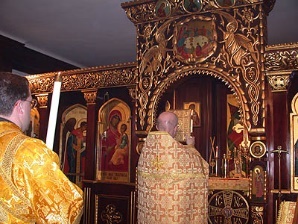
If the priest is serving the Divine Liturgy alone, or with a deacon, the Small Entrance is made by the clergy circling the altar table and coming to the middle of the church with the Gospel Book in order to enter through the royal gates of the iconostasis accompanied by the Hymn of Entrance.
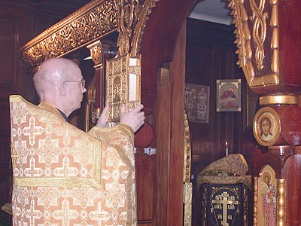
The Small Entrance is the first significant movement of the Divine Liturgy. It follows the primary liturgical action which is the gathering of the faithful into the one community of the Church of God. The Small Entrance is the movement of the entire Church through its Head Jesus Christ, in the person of the celebrant, to the altar which symbolizes the Kingdom of God. It is the movement made possible by the Gospel of Christ, the Way to the Kingdom. It can only be accomplished by following Jesus, the Living Word of God in human flesh (Jn.1:1–18).
There can be no approach to God the Father but through Christ, the Son of God (Jn.14:6). There can be no communion with God the Father except by the fulfillment of his commandments which are given by Jesus and proclaimed in the words of his Gospel. Thus it is the Gospel of Christ, the Son and Word of God, which takes us into the realm of the Father and into the eternal life of the Blessed Trinity whose Kingdom we enter and experience in the Divine Liturgy of the Church.
Technically speaking, the Small Entrance is not completed when the clergy enter the sanctuary and stand before the altar table. It is completed only with the singing of the Thrice-Holy Hymn during which the clergy proceed to the place behind the altar table (called the High Place), at which time the chief celebrant turns and blesses the people with the solemn biblical greeting: “Peace be, unto all!”
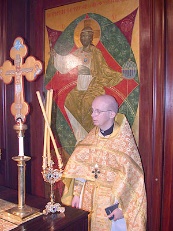
While the clergy are still before the altar table, the people sing the troparia and kontakia of the day. These are hymns which praise the saving events or holy persons celebrated liturgically at the particular gathering. On Sundays these songs always praise Christ’s resurrection from the dead.
While these hymns are being sung, the celebrant of the liturgy prays before the altar for the general absolution and forgiveness of sins of the entire assembly so that all of the people might be made worthy by God “to stand before the glory of Thy holy altar and to offer worship and praise which are due unto Thee.” There then follows the singing of the Thrice-Holy Hymn of the angels which perpetually resounds in the presence of the Kingdom of God. “Holy God! Holy Mighty! Holy Immortal! Have mercy on us!” (Is.6:1–5).
This version of the Thrice-Holy Hymn is of very ancient origin. It is a hymn to the Holy Trinity in whose presence the Christians now find themselves at the liturgy. It is within the presence of the Kingdom of God that men are made competent by Christ and the Holy Spirit to hear, to understand and to do the Word of God which will be announced to them from the throne of the Father.
Epistle
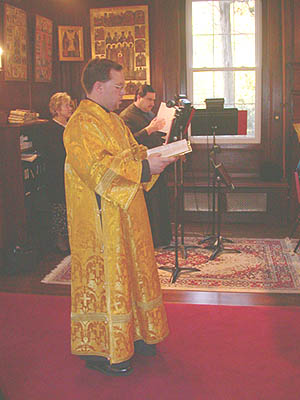
During the solemn singing of the Thrice-Holy Hymn to the Most Holy Trinity, the clergy proceed to the High Place behind the altar table, blessing Christ who “sits upon the throne of glory, upon the cherubim. . . .” From this place, as we have already mentioned, the celebrant turns and blesses the people with the Peace of Christ. After the Peace is returned, the Epistle of the Divine Liturgy is chanted, usually by a layman of the Church or one in the minor order of Reader.
The epistle reading in traditional Church language is called the apostle or the apostolic reading. This is so since the reading may be taken from the Acts of the Apostles as well as from one of the apostolic letters of the New Testament scriptures. The word epistle means letter. We should note here that the only book of the New Testament writings which is not read liturgically in the Orthodox Church is the Book of Revelation because of its apocalyptic character.
There is a series of epistle readings prescribed in regular order for each day of the Church Year, with the exception of the week days of Great Lent when the Divine Liturgy is not celebrated. There are also special epistle readings prescribed for particular Church celebrations. Thus at any given Divine Liturgy more than one epistle lesson may be chanted.
Before the actual reading of the epistle, an appointed verse from the Psalter is sung called the prokeimenon, which literally means, “that which goes before.” As usual, the prokeimenon, with its verse, is suited to the particular liturgy and prepares the people to listen to the Word of God.
Gospel
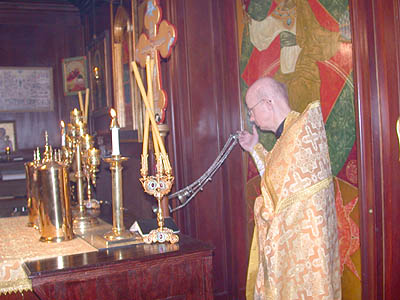
A reading from one or more of the four Christian Gospels follows the reading of the epistle at the Divine Liturgy. In between these two proclamations of the Word of God, Alleluia is solemnly chanted, once more interspersed by verses from the Psalms. At this time incense is also offered, with the incensing of the Gospel Book, the icons, the reader and all of the people.
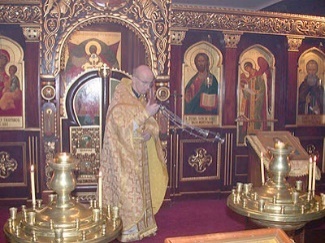
The Alleluia and the incensing at this moment in the Divine Liturgy signify the very presence of God with his People, teaching them himself through Christ the Word and the Holy Spirit (Jn.6:45). God is with men in the Church, revealing himself and his Holy Will to the world. The Gospel is God’s glad tidings of salvation, his official good news to mankind. It contains and proclaims his presence and his power among men.
The proclamation of the Gospel in the Church is a sacramental act. It is a form of man’s communion with God. It is an element of the liturgical mystery in and through which God is united with his People, and his People with him.
Just as for the epistle readings, there are prescribed readings from the Gospels for each liturgical day of the year, as well as special readings for particular Church celebrations. Thus, once more, there may be several different readings from the Gospels at any given Divine Liturgy.
Following the proclamation of the Word of God through the words of the Holy Gospel, a liturgical sermon or homily is preached. The sermon normally proclaims, and not seldom explains, the significance of the Divine Word received at the particular liturgy for the life of the People of God and the destiny of the world. In Orthodox Tradition, the sermon is an essential part of the eucharistic liturgy and participates in its general sacramental character.
Fervent Supplication
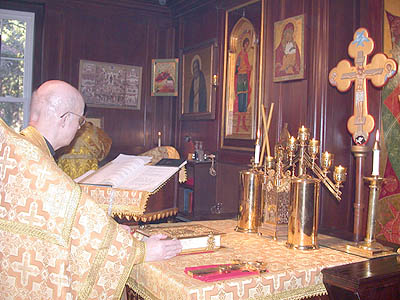
Following the readings from the holy scriptures and the liturgical sermon, the Liturgy of the Word, also called the Liturgy of the Catechumens, comes to an end with the so-called Litany of Fervent Supplication. This litany is the one through which the people pray for their own particular needs, as well as those of the entire Church, their neighbors, their country and the entire world.
At this time the intercessions are not made generally, as in the Great Litany, but very specifically on behalf of all persons in need of God’s blessings, strength and guidance. Thus prayers are made for the sick, the suffering, the needy, the afflicted and the departed by name; as well as for such specific things as national guidance, deliverance from some particular threat, etc. Also at this time special prayers of thanksgiving and praise may be offered in response to some particular blessing of God. Because the offertory will follow, prayers are also made at the end of the litany “for those who bring offerings and do good work” in the particular community.
After the completion of the Litany of Fervent Supplication, the catechumens are prayed for and dismissed from the Divine Liturgy since, as not yet baptized, they are not competent to offer and to receive the eucharistic gifts. In the early Church all those under penance for their sins, and all who for one reason or another were not receiving Holy Communion, also left the liturgical gathering at this time.
At present the dismissal of the catechumens has become only theoretically significant since it is not the case that non-communicants, or even the non-baptized, leave the gathering for the eucharistic part of the service which, we have noted, is still officially called the Liturgy of the Faithful.
After the prayer that God would illumine the catechumens with the Gospel of Truth and unite them to his Holy Church, granting them “in due time the laver of regeneration, the remission of sins and the robe of incorruption” in baptism; and after their theoretical dismissal from the liturgy, two prayers are read for the faithful who are already members of the Church, that God would hear their prayers and would make them worthy to offer and to receive the gifts of Holy Communion:
And enable us also whom Thou hast placed in this Thy service by the power of the Holy Spirit, blamelessly and without offence, in the pure witness of our conscience to call upon Thee . . .
. . . to worship Thee blamelessly with fear and with love, and to partake without condemnation of Thy Holy Mysteries, and to be accounted worthy of Thy Heavenly Kingdom. . . .
Offertory: Great Entrance
It is now time for the sacrificial offering to God. There is only one true and acceptable offering with which God is pleased. It is the offering of Jesus Christ, the Lamb of God Who offers Himself eternally to the Father for the sins of the world.
In Christ men can offer themselves and each other and all men and the entire world to God. Christ has united all things in Himself, and has taken all things upon Himself. Thus, in and through Him, men can offer all that they are, and all that they have, to God the Father. They can do this because they are in Christ, and have received the Holy Spirit from Him.
At this moment in the Divine Liturgy the celebrant prays for himself, confessing his personal unworthiness and affirming that the only Priest of the Church is Jesus:
For Thou art the One who offers and the One who is offered, the One who receives and the One who is given, O Christ our God . . .

The altar table, the icons and all of the people are incensed once again as the Cherubic Hymn is sung:
Let us who mystically represent the cherubim and sing the Thrice-holy Hymn to the life-creating Trinity, now lay aside all earthly cares.
The Gifts of bread and wine which stand for Christ, and in him, for all men and the entire world of God’s creation – for Life itself – are now offered to God. They are carried in solemn procession from the table of oblation, into the middle of the church, and through the royal doors of the iconostasis to the altar table. This procession is called the Great Entrance as distinct from the Small Entrance that was made earlier with the Book of the Gospels. In some Orthodox Churches the offertory procession of the Great Entrance is made around the entire nave of the church building, and so it is actually of greater length and solemnity than the small procession with the Gospel Book.
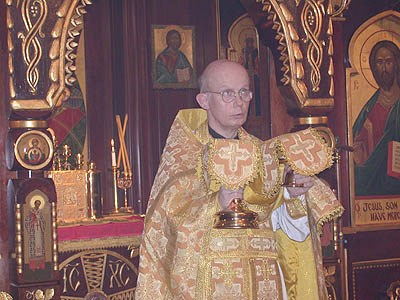
During the offertory procession of the Great Entrance, the celebrant once again prays to God on behalf of all with the prayer of the Crucified Thief: “Remember, O Lord in Thy Kingdom.” The bread and wine are placed on the altar table and the people conclude the Cherubic Hymn:
That we may receive the King of all who comes invisibly upborne by the angelic hosts. Alleluia.
At this time the celebrant quietly recites verses which call to remembrance the absolute perfection and total sufficiency of Christ and His self-offering. For the Lord Who “fills all things” with Himself makes even His tomb “the fountain of our resurrection.”
The Cherubic Hymn and the meditative verses of the celebrant just mentioned are a late addition to the Divine Liturgy. They were added in the imperial era of Byzantium in order to enhance the essential liturgical act of the offertory which is the movement of the Church offering itself to God the Father through its Head, High Priest and King Jesus Christ who is also the Suffering Servant, the Lamb of God and the New Passover; the sole sufficient sacrifice which is perfect, total and fully acceptable to the Father.
In the liturgical offertory, the faithful give themselves in sacrifice to God together with Christ. They do so through the Holy Spirit as those who have died and risen with Christ in baptism. In order for the liturgical act of offering to be genuine and true, it must be the living expression of the Church’s constant and total self-offering to God. If each member of the Church is not in perpetual sacrifice with Christ to the Father and is not “bearing his cross” by the power of the Spirit, the offertory entrance of the Divine Liturgy becomes a sterile symbol devoid of reality. As such it is done not as a movement towards God, but unto condemnation and judgment.

Thus, once again a litany is chanted and a prayer is made that God would be merciful, because of the sacrifice of Christ, and would accept His people and their offering in spite of their sins; and would allow them worthily to offer the Gifts and to receive Holy Communion with God.
O Lord God Almighty, who alone art holy, who acceptest the sacrifice of praise from those who call upon Thee with their whole heart. Accept also the prayer of us sinners, and bear it to Thy holy altar, enabling us to offer unto Thee gifts and spiritual sacrifices for our sins and for the errors of the people. Make us worthy to find grace in Thy sight that our sacrifice may be acceptable unto Thee, and that the Good Spirit of Grace may dwell upon us, and upon these Gifts here offered, and upon all Thy People . . .
At this time in the Divine Liturgy the gifts of money for the work of the Church, the propagation of the Gospel and the assistance of the poor and the needy are collected and offered to God.
Love and Faith
Before the Divine Liturgy can proceed further, there are two conditions which must be fulfilled by the faithful. These are the solemn expressions of love and of faith which are essential to the Christian life, and without which there can be no self-offering and no communion with God. Therefore at this time the proclamation is made from the altar: “Let us love one another that with one mind we may confess” . . . the faithful people continue . . . “Father, Son and Holy Spirit, the Trinity, one in essence and undivided.”
Love is the foundation of life. This is the fundamental Christian truth. Without love there can be no life, no truth and no communion with God, for God is Love (1Jn.4:8,16). Thus Jesus Christ has taught that the whole Old Testament Law and the Prophets depend on the two great commandments of love for God and men, and He has given his own “new commandment” that His disciples should love “even as I have loved you” (Jn.13:34).
Thus at the Divine Liturgy the Christians are continually called to love. The outward expression of this love in the liturgy today is the kiss of peace exchanged by the celebrating clergy, which in times past was certainly exchanged among the faithful people as well. Without this love, the liturgy cannot go on.
Following the call to love, the Symbol of Faith, also called the Creed, is chanted. The traditional introduction to the recitation of the creed in the liturgy is the exclamation: “The Doors! The Doors! In wisdom, let us attend!” The doors referred to here are the doors of the church building, and not the doors of the iconostasis as some have been known to think, since this is a call to assure that all catechumens and non-communicants have left, and that now no one may enter or leave the liturgical assembly. The historical reason for such an exclamation in the Divine Liturgy was not only that order might be kept in the church, but that the Creed might be pronounced only by those who had already officially pronounced it at baptism, and continued to confess it within the life of the Church.
The recitation of the Symbol of Faith at the Divine Liturgy stands as the official acknowledgment and formal acceptance by each individual member of the Church of his or her own baptism, chrismation and membership in the Body of Christ. The recitation of the Creed is the only place in the Divine Liturgy, with the exception of the very similar pre-communion confession of faith, where the first person pronoun is used. All through the liturgy the community prays in the plural we. Only here does each person confess for himself his own personal faith: I believe.
No person can believe for another. Each must believe for himself. A person who believes in God, in Christ, in the Holy Spirit, in the Church, in baptism and in life eternal, in short, a person who affirms and accepts his baptismal membership in the Church, is competent to participate in the Divine Liturgy. A person who cannot do this, cannot participate. He simply is not able to, since this specific faith is the specific requirement for membership in the Orthodox Church and for participation in its Divine Liturgy. Without this faith, the movement of the liturgy cannot proceed further. With it, and its official acknowledgment in the chanting of the Creed, the liturgical action goes on.
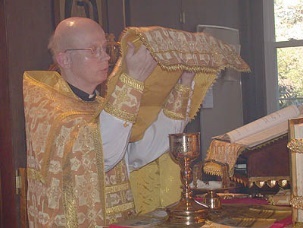
It is the custom in the Church for the clergy to fan the eucharistic gifts during the singing of the Creed. This fanning was an act of veneration used toward the earthly emperor in the Byzantine period, during which time it was incorporated into the Church’s liturgy, and used as an act of veneration toward the “presences” of the Heavenly King in the midst of His People, namely towards the book of the Gospels and the eucharistic gifts. (In some churches special liturgical fans are carried by the altar servers at all processions and expositions of the Gospel book and the eucharistic gifts.)
Eucharistic Canon: Anaphora
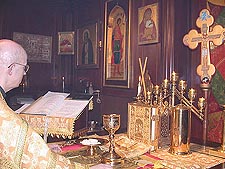
Now begins the part of the Divine Liturgy called the eucharistic canon. It is also called the anaphora, which means the lifting-up or the elevation. At this time the gifts of bread and wine which have been offered on the altar are lifted up from the altar to God the Father, and receive divine sanctification by the Holy Spirit who comes to change them into the very Body and Blood of Christ.
The general form of the eucharistic canon is that of the Old Testamental Passover ritual, now fulfilled and perfected in the new and everlasting covenant of God with men in the person and work of Jesus Christ the Messiah, “our Paschal Lamb Who has been sacrificed” (1Cor.4:7; See also Heb.5–10). Thus the eucharistic anaphora begins:
Let us stand aright! Let us stand with fear! Let us attend! That we may offer the Holy Oblation in peace.
The people respond: A mercy of peace! A sacrifice of praise!
The Holy Oblation is Christ, the Son of God who has become the Son of Man in order to offer Himself to His Father for the life of the world. In His own person Jesus is the perfect peace offering which alone brings God’s reconciling mercy. This is undoubtedly the meaning of the expression a mercy of peace, which has been a source of confusion for people over the years in all liturgical languages.
In addition to being the perfect peace offering, Jesus is also the only adequate sacrifice of praise which men can offer to God. There is nothing comparable in men to the graciousness of God. There is nothing with which men can worthily thank and praise the Creator. This is so even if men would not be sinners. Thus God himself provides men with their own most perfect sacrifice of praise. The Son of God becomes genuinely human so that human persons could have one of their own nature sufficiently adequate to the holiness and graciousness of God. Again this is Christ, the sacrifice of praise.
Thus, in Christ, all is fulfilled and accomplished. In Him the entire sacrificial system of the Old Testament, which is itself the image of the universal striving of men to be worthy of God, is fulfilled. All possible offerings are embodied and perfected in the offering of Christ on the Cross. He is the offering for peace and reconciliation and forgiveness. He is the sacrifice for supplication, thanksgiving and praise. In Him all of men’s sins and impurities are forgiven. In Him all of men’s positive aspirations are fulfilled. In Him, and in him alone, are all of men’s ways to God, and God’s ways to men, brought into one Holy Communion. Through Him alone do men have access to the Father in one Holy Spirit (Eph.2:18; Also Jn.14; 2Cor.5; Col.1).
The celebrant now addresses the congregation with the Trinitarian blessing of the Apostle Paul (2Cor.13:14). This is the more elaborate Christian salutation than the simple Peace (Shalom) of the Old Testament:
The grace of our Lord Jesus Christ, the love of God the Father,and the communion of the Holy Spirit be with all of you.
And the people respond: And with your spirit.
The grace of Christ comes first. In this grace is contained the fullness of the love of God and the communion of the Holy Spirit. The celebrant offers this entire abundant outpouring of the inner life of the Holy Trinity to the People of God. And they in turn respond with the prayer that this “fullness of God” would be with his spirit as well.
The eucharistic dialogue continues:
Let us lift up our hearts!
We lift them up unto the Lord!
Let us give thanks unto the Lord!
It is meet and right to worship the Father and the Son and the Holy Spirit; the Trinity one in essence and undivided.
As men in Christ lift up the eucharistic gifts, they lift up their hearts as well. In the Bible the heart of man stands for his whole being and life. Thus in the anaphora, as the Apostle Paul has stated, the whole man is taken up into that realm where Christ is now seated at the right hand of God.
If then you have been raised with Christ, seek the things that are above, where Christ is, seated at the right hand of God. Set your minds on things that are above, not on things that are on earth. For you have died, and your life is hid with Christ in God (Col.3:1–3).
The manner of lifting up oneself to God is through thanksgiving. The word eucharist in Greek means thanksgiving. The eucharistic Divine Liturgy is preeminently the action of lifting up one’s heart and giving thanks to God for all that He has done for man and the world in Christ and the Holy Spirit: creation, salvation and eternal glorification.
The original sin of man, the origin of all of his trouble, corruption and ultimate death, is his failure to give thanks to God. The restoration of communion with God, and with all creation in him, is through thanksgiving in Christ. Jesus is the only man truly grateful, humble and obedient to God. In him, as the only Beloved Son of God and the only perfect Adam, all men can lift up their hearts and give thanks to the Lord: “For there is . . . one mediator between God and men, the Man Christ Jesus, who gave himself as a ransom for all . . .” (1Tim.2:5).
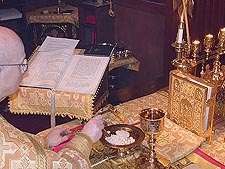
It should be noted here that the affirmation “it is meet and right” is expanded into a longer form only in the Slavic tradition of the Church. In other churches it remains in this simple and more ancient form.
With hearts lifted up to the Lord, and thanksgiving rendered to God, the prayer of the eucharistic canon continues:
It is meet and right to sing of Thee, to bless Thee, to praise Thee, to give thanks to Thee and to worship Thee in every place of Thy dominion. For Thou art God ineffable, inconceivable, invisible, incomprehensible, ever-existing and eternally the same, Thou and Thine only-begotten Son and Thy Holy Spirit. Thou it was who brought us from non-existence into being, and when we had fallen away, didst raise us up again, and didst not cease to do all things until Thou hadst brought us up to heaven and hadst endowed us with Thy Kingdom which is to come. For all these things we give thanks to Thee, and to Thine only-begotten Son and to Thy Holy Spirit; for all things of which we know and of which we know not, whether manifest or unseen; and we thank Thee for this liturgy which Thou hast found worthy to accept at our hands, though there stand by Thee thousands of archangels and hosts of angels, the Cherubim and the Seraphim, six-winged, many eyed, who soar aloft, borne on their pinions, singing the triumphant hymn, shouting, proclaiming and saying:
Holy! Holy! Holy! Lord of Sabaoth! Heaven and earth are full of Thy glory! Hosanna in the highest! Blessed is he that comes in the name of the Lord! Hosanna in the highest!
At this point in the Divine Liturgy man’s thanksgiving to God the Father for all that he has done in Christ and the Spirit is brought to its climax. The man in God remembers all things and is grateful to God. His remembrance and his thanksgiving take him into the very Presence of the Kingdom to the Throne of the Father to sing the Thrice-Holy Hymn with the angelic choirs (Is.6:1–5).

Through Christ and the Holy Spirit, the man of faith is transported in spirit to be with his Lord. The limitations of this age are left behind through grateful remembrance of Christ and his accomplishment of salvation. Thus the eucharistic prayer continues with the whole focus of attention brought to that One Man and that one night in which the Divine Son gave himself as food for the faithful, offering himself in sacrifice for the life of the world.
With these blessed powers, O Master, Who lovest mankind, we also cry aloud and say: Holy art Thou and all-holy, Thou and Thine only-begotten Son and Thy Holy Spirit! Holy art Thou and all-holy, and magnificent is Thy glory! Who hast so loved Thy world as to give Thine only-begotten Son, that whoever believes in Him should not perish but have everlasting life. Who when He had come and had fulfilled all the dispensation for us. in the night in which He was given up – or rather gave Himself up for the life of the world – He took bread in His holy, pure and blameless hands; and when He had given thanks and blessed it, and hallowed it and broken it, He gave it to his holy disciples and apostles saying:
Take! Eat! This is My Body which is broken for you for the remission of sins. Amen.
And likewise after supper, He took the cup saying: Drink of it all of you! This is My Blood of the New Testament, which is shed for you and for many for the remission of sins! Amen.
Remembering this saving commandment and all those things which have come to pass for us: the cross, the tomb, the resurrection on the third day, the ascension into heaven, the sitting at the right hand of God the Father, the second and glorious coming.
Thine own of Thine own we Offer unto Thee, in behalf of all and for all!

As the celebrant intones these last words which proclaim that all that is offered to the Father is already his – for every creature and all of creation are his, together with the Beloved Son and the Holy Spirit who are uncreated and divine – the eucharistic gifts are lifted up and elevated towards the heavens. It is the sign that the faithful Christians have been exalted together with their Lord into the Kingdom of God.
For Christ has entered, not into a sanctuary made with hands . . . but into heaven itself now to appear in the presence of God on our behalf . . . we have been sanctified through the offering of the body of Jesus Christ once for all . . . for when Christ had offered for all time a single sacrifice for sins, He sat down at the right hand of God . . . for by a single offering He has perfected for all time those who are sanctified (Heb.9:24, 10:10–14).
Heaven and earth are now blended into one, filled with the glory of God. The ages past and the ages still to come are brought into unity. The night, the supper, the cross, the tomb, the resurrection, the ascension, the kingdom to come – all merge together in the eucharistic moment of the Divine Liturgy. Man is with God in a holy communion which is “not of this world.” All boundaries of time and of space are utterly broken. All walls of division are totally destroyed. Man’s sins are forgiven in Christ, his impurities are cleansed, his corruption is healed. His mortal nature is restored to immortality with God. His created humanity is filled with the Uncreated Divinity of the All-Holy Trinity. It only remains now to seal this action by the invocation of the Spirit of God.
Epiklesis
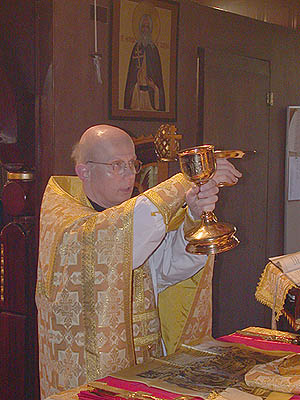
After the elevation of the eucharistic gifts to the Father, the celebrant of the Divine Liturgy prays for the Holy Spirit to come upon them, and upon all of the people, and to change (or as the Liturgy of Saint Basil says, to show) the bread and wine offered in remembrance of Christ to be the very Body and Blood of the Lord.
The prayer for the coming of the Holy Spirit is considered by the Orthodox to be an essential part of the Divine Liturgy. It is called the epiklesis, which means literally the calling upon or the invocation.

The Orthodox Church believes, as it prays, that the Holy Spirit is always “everywhere and fills all things.” The invocation of the Holy Spirit at the Divine Liturgy is the solemn affirmation that everything in life which is positive and good is accomplished by the Spirit of God. Creation, salvation, eternal glorification; the entire work of God in making and saving the world is accomplished by the power of the Holy Spirit. He is the one who dwelt in Jesus making him the Christ. He is the one by whom Christ was incarnate of the Virgin Mary. He is the one who led Christ to the cross as the innocent Victim, the one who raised Him from the dead as the triumphant Victor.
He is the one who guarantees the indwelling of God with men in the Holy Communion of the Church and in the life of the Kingdom to come.
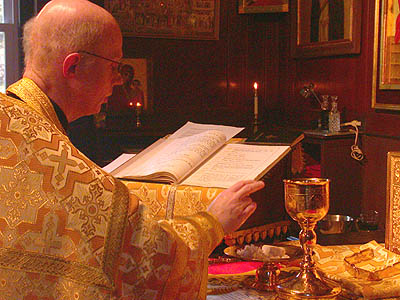
Again we offer unto Thee this reasonable and bloodless worship, and we ask Thee, and pray Thee, and supplicate Thee: Send down Thy Holy Spirit upon us and upon these gifts here offered. And make this bread the precious Body of Thy Christ.
And that which is in this cup, the precious Blood of Thy Christ.

Making the change by the Holy Spirit.
That these gifts may be to those who partake for the purification of soul, for remission of sins, for the communion of the Holy Spirit, for the fulfillment of the Kingdom of Heaven; for boldness towards Thee, and not for judgment or condemnation.
In the Orthodox Churches of the Slavic tradition, the Prayer of the Third Hour is added to the epiklesis. It is a prayer asking the Lord to send the Holy Spirit to the Church right now as He did “at the third hour” to His holy apostles and disciples on Pentecost. This prayer was added to emphasize the necessity of the Holy Spirit in the sacramental action of the Divine Liturgy, and to affirm that nothing at all may be done in Christ without the specific intervention of the Spirit of God.
Rememberances
The holy eucharist is offered in remembrance of Christ. “Do this in remembrance of Me.” Remembering Christ, and offering all things to God in and through Him, the Church is filled with the presence of the Holy Spirit. At the Divine Liturgy, the Holy Spirit comes “upon us and upon the gifts here offered.” Everything is filled with the Kingdom of God. In God’s Kingdom nothing is forgotten. All is remembered, and is thereby made alive. Thus, at this moment in the Divine Liturgy the faithful, remembering Christ, remember all men and all things in him, especially Christ’s mother, the Holy Theotokos, and all of the saints.
It is important to note here that as the Divine Liturgy is the real presence and power of the unique saving event of Christ for His people in all of its manifold elements and aspects, it is always offered for all who need to be saved. Thus the liturgical sacrifice is offered for Mary and all of the saints, as well as for the whole Church and the entire universe of God’s creation.
Again we offer unto Thee this reasonable worship for those who have fallen asleep in the faith: ancestors, fathers, patriarchs, prophets, apostles, preachers, evangelists, martyrs, confessors, ascetics, and every righteous spirit made perfect in faith.
And especially for our most holy, most pure, most blessed and glorious Lady, Theotokos and ever-virgin Mary.
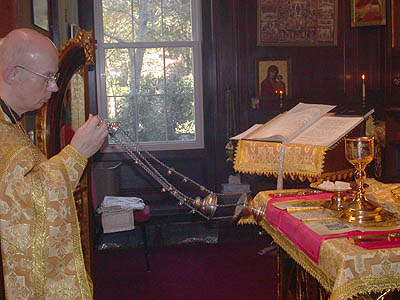
While the choir sings a hymn to the Theotokos, which often changes during the Church Year according to the various seasons and celebrations, the celebrant incenses the consecrated gifts and continues to ask God to remember John the Baptist, the saints of the day, the departed faithful, the whole Church and the entire world. Following the specific remembrance of the bishop of the given church, the people sum up all of the remembrances with the words: “And all mankind!”
There then follow even more prayers asking God to remember the city, the country, the travelers, the sick, the suffering, the captives, the benefactors of the Church, those who themselves “remember the poor” and all of the people. There is also the provision made at this point in the liturgy for remembering by name persons in need of special mercy from God.
In the Liturgy of Saint Basil, which is generally much longer and much more detailed than that of Saint John Chrysostom the remembrances are very specific and numerous, going on for more than three pages in the liturgical service book.
It is necessary to remember once again that remembrance in the Orthodox Church, and particularly the remembrance of God and by God, has a very special meaning. According to the Orthodox Faith, expressed and revealed in the Bible and the Liturgy, divine remembrance means glory and life, while divine forgetfulness means corruption and death. In Christ, God remembers man and his world. Remembering Christ, man remembers God and his Kingdom. Thus the remembrances of the Divine Liturgy are themselves a form of living communion between heaven and earth (see “Funerals,” above).
Our Father
Following the remembrances of the Divine Liturgy, the people pray to God to allow them to worship “with one mouth and one heart.” They then wish each other “the mercies of our Great God and Saviour Jesus Christ”; and, “having remembered all of the saints,” they sing the litany in which they beg God to receive the eucharistic gifts “upon His holy, heavenly and ideal altar,” and to “send down in return his divine grace and the gift of the Holy Spirit.”
Ending the litany with the prayer for “the unity of the Faith and the Communion of the Holy Spirit,” the faithful commend their lives to Christ asking to be made worthy “with boldness and without condemnation to dare to call upon the Heavenly God as Father and to say: ‘Our Father, Who art in heaven. . . ’.”
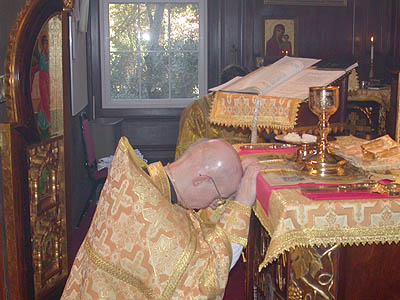
In the Old Testament the People of God did not dare to address God in prayer with the intimate name of Father. Only in Christ and because of Christ can men have such boldness. Only Christians can properly use the Lord’s Prayer that was taught to them by the Son of God. Only those who have died and risen with Christ in baptism, and have received the power to become sons of God by the Holy Spirit in chrismation are enabled to approach the All-mighty God Most High as their Father (Jn.1:12; Mt.6:9; Rom.8:14; Gal.4:4).
In the early Church the Lord’s Prayer was taught to people only after they had become members of Christ through baptism and chrismation. Just before receiving the gifts of Holy Communion “for remission of sins, for forgiveness of transgressions, for the communion of the Holy Spirit and for the inheritance of the Kingdom of Heaven,” the faithful who have become children of God in Christ and the Spirit exercise their gift of divine sonship in the Saviour. They dare pray to God as to their very own Father.
Communion
After the Our Father, the children of God receive Holy Communion. The celebrant again offers the Peace of Christ to the people, and with bowed heads they pray together for their worthy participation in Holy Communion. The celebrant prays that Christ Himself would come to distribute His Body and Blood.
Attend O Lord Jesus Christ our God, out of Thy holy dwelling place, from the throne of the glory of Thy kingdom and come to sanctify us, O Thou who sittest on high with the Father and art here invisibly present with us, and by Thy mighty hand impart unto us Thy most pure Body and precious Blood, and through us to all of the people.
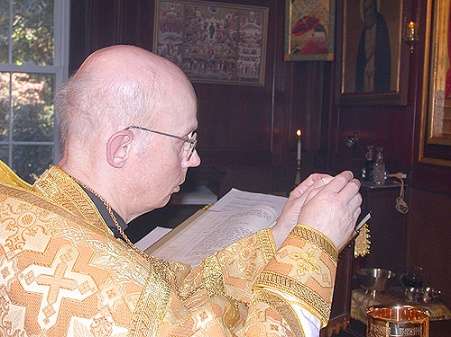
The consecrated Lamb is then elevated with the proclamation: “Holy Things are for the holy!” The people respond: “One is Holy! One is the Lord Jesus Christ! To the glory of God the Father, Amen.” The celebrant then breaks the Lamb into four pieces according to the way it was cut at the prothesis.
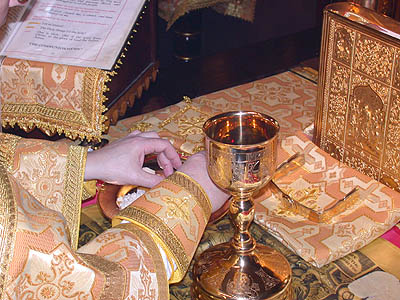
One piece of the sanctified bread (IC) is put into the chalice together with a cup of hot water which symbolizes the living character of the Risen Christ whose body and soul are reunited and filled with the Holy Spirit in the glorified life of the Kingdom of God.

The clergy then receive Holy Communion from the bread (XC), and drink from the consecrated cup. While the clergy participate in the Holy Mysteries, the people sing a special communion verse that changes according to the celebration. They may sing other hymns proper to the season as well, especially if the communion of the clergy takes a long time.

The faithful people receive Holy Communion on a spoon. They are given both the consecrated bread (NIKA), and the sanctified wine. The communion of the faithful is always from the gifts offered and sanctified at the given Divine Liturgy. Holy Communion is never taken from any “reserve.” As we have mentioned, all who are members of the Church through the sacraments of baptism and chrismation, including small children and infants, may partake of Holy Communion.
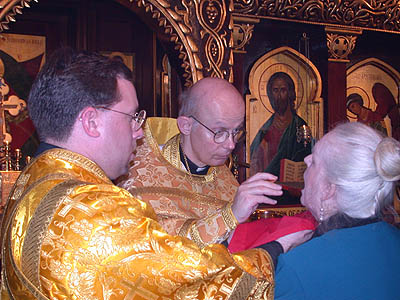
During the communion of the faithful the people sing: Receive the Body of Christ, Taste the Fountain of Immortality, Alleluia. Before the reception of Holy Communion generally, the following prayer is recited by all. It is each person’s act of personal commitment to Christ, with faith in Him and the Sacred Mysteries of His Church.
I believe O Lord and I confess that Thou art truly the Christ, the Son of the Living God, who camest into the world to save sinners, of whom I am the first (see 1Tim.1:15).
I believe also that this is truly Thine own most pure Body, and that this is truly Thine own most precious Blood. Therefore I pray Thee: Have mercy upon me and forgive me my transgressions.
And make me worthy to partake without condemnation of Thy most pure Mysteries, for the remission of sins and unto life everlasting.
Of Thy Mystical Supper, O Son of God, accept me today as a communicant. For I will not speak of Thy Mystery to Thine enemies, neither like Judas will I give Thee a kiss; but like the thief will I confess Thee: “Remember me, O Lord, in Thy Kingdom.”
May the communion of Thy Holy Mysteries be neither to my judgment, nor to my condemnation, O Lord, but to the healing of soul and body.
Following Holy Communion in some churches it is the custom of the people to take some bread and wine. This helps them to receive the holy gifts, and to have something more to eat since they have been fasting.
Thanksgiving
After the communion of the people, the celebrant blesses them with the words: “O Lord, save Thy people and bless Thine inheritance.” The people sing in response:
We have seen the True Light! We have received the Heavenly Spirit! We have found the True Faith! Worshiping the Undivided Trinity, Who has saved us.

The celebrant then blesses the faithful with the eucharistic chalice in which the gifts not received are still present, as he takes them to the table of oblation where the youngest member of the clergy consumes them. During the removal of the consecrated gifts the people sing:
Let our mouths be filled with Thy praise O Lord, that we may sing of Thy glory; for Thou hast made us worthy to partake of Thy Holy, Divine, Immortal and Life-creating Mysteries. Keep us in Thy holiness, that all the day we may meditate upon Thy righteousness. Alleluia! Alleluia! Alleluia!
A litany of thanksgiving is then sung to the Lord with prayers of gratitude that he has blessed his people with participation in the “heavenly and immortal mysteries.” The prayers also ask God to keep the whole day “perfect, holy, peaceful and sinless;” that through the reception of Holy Communion, God would “make straight our path, strengthen us all in Thy fear; guard our lives, make firm our steps. . . .”
The songs and prayers following Holy Communion in the Divine Liturgy, as all parts of the holy service, presuppose that the members of the Church are partaking in the eucharistic mysteries and are receiving the gifts of Christ’s Body and Blood. The offertory, the anaphora, the epiklesis, the remembrances, the Our Father, and the communion itself all affirm the active participation of the faithful.
Thus it is obvious from the text of the Divine Liturgy as it is always served in the Orthodox Church that the reception of Holy Communion on the part of the people is a regular and normal part of the liturgy and the life of Christians. It is not to be reserved for special days or seasons, but is to be done prayerfully and carefully at all times when the Divine Liturgy is celebrated.
It may happen that all members of the Church are not prepared to receive Holy Communion at the Divine Liturgy. It is even reasonable to expect that this will often be the case, given the present conditions of life and the great number of people who are just nominally Christians. However, be that as it may, it must be very forcefully affirmed, without any reservations or doubts, that the prayers, hymns and actions of the Divine Liturgy of the Orthodox Church presuppose the regular and normal participation of all of the people in Holy Communion; and that the failure on the part of the faithful to receive the Holy Mysteries of Christ is to deprive the Divine Liturgy of its essential meaning and purpose.
Benediction and Dismissal
After giving thanks to God for His gift of Holy Communion, the people are commanded by the celebrant of the liturgy to depart in peace. They respond to this command with the words: “In the Name of the Lord.”
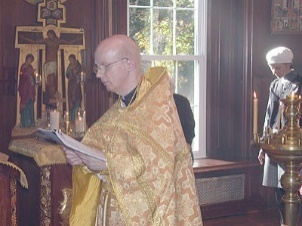
A final prayer is read in the center of the Church, or at the icon of Christ, called the ambo prayer, in which the priest asks God’s blessing and peace upon all of his people, the Church and the world. In this prayer the believers also affirm with the Apostle James that “every good gift and every perfect gift is from above, coming down from the Father of Lights” (Jas.1:17). Following this prayer which gives God “glory, thanksgiving, and worship,” the people sing three times: “Blessed be the Name of the Lord henceforth and forevermore.”
At this point the pastor of the community normally makes his announcements, greets his people and gives them his own personal blessing. The final benediction of the Divine Liturgy is then pronounced following the exclamation of glory to Christ as “our God and our Hope.”

The final liturgical blessing is the blessing of Christ. It always begins on the Lord’s Day with reference to His resurrection from the dead. On other days other references may be made to some saving aspect of the Lord’s person and work. In this final benediction the mercy and salvation of Christ, the Lover of Men, is called down upon his people through the intercessions of the Theotokos and Ever-virgin Mary, and by the prayers of the saints of the day, the saint whose liturgy is served, the saints of the particular church, as well as all other saints especially venerated by the local community, such, for example, as Saint Herman of Alaska in the American Church.

After the final benediction, the people venerate the Cross held by the celebrant, and receive pieces of the bread from which the eucharistic offering was taken at the beginning of the liturgy. This bread is called the antidoron which means literally “in place of the gifts”, since it used to be given only to those who did not actually receive Holy Communion at the liturgy. Today usually all of the people take pieces of this bread for themselves, as well as for others absent from church.
The act of dismissal in the Divine Liturgy is as much a liturgical and sacramental action as was the original act of gathering. It is the final critical step of the entire movement of the liturgy. In their dismissal from the liturgical gathering, the People of God are commanded to go forth in peace into the world to bear witness to the Kingdom of God of which they were partakers in the Liturgy of the Church. They are commanded to take everything that they have seen and heard and experienced within the Church and to make it alive in their own persons within the life of this world. Only in this way can the presence and power of the Kingdom of God which is “not of this world” extend out of the Church and into the lives of men.
Those who have seen the True Light, who have received the Heavenly Spirit, who have found the True Faith at the liturgy of the Church; those who have partaken of the holy, divine, immortal and life-creating mysteries of Christ, become competent to make the very same proclamation and testimony that was made by the apostles and by all true Christians in every age and generation. It is for this reason that the Church of God and its Divine Liturgy exist.
That which was from the beginning, which we have heard, which we have seen with our eyes, which we have looked upon and touched with our hands, concerning the Word of Life – the Life was manifest and we saw it, and testify to it, and proclaim to you the Eternal Life which was with the Father, and was made manifest to us – that which we have seen and heard we proclaim also to you, so that you may have communion with us; and our communion is with the Father and with His Son, Jesus Christ. And we are writing that your joy may be full (1Jn.1:14).
Selected Bibliography
1. The Divine Liturgy. Official translation of the Orthodox Church in America, New York, 1967.
2. The Festal Menaion. Translated from the original Greek by Mother Mary and Archimandrite Kallistos Ware, Faber and Faber, London, 1969.
3. Service Book of the Holy Orthodox-Catholic Apostolic Church. Translated by Isabel F. Hapgood, Syrian Antiochian Orthodox Archdiocese, New York, 1956.
4. Cabasilas, Nicholas, A Commentary on the Divine Liturgy, Translated by J. M. Hussey and P. A. McNulty, with an introduction by R. M. French, London, SPCK, 1960.
5. Danielou, Jean, The Bible and the Liturgy, University of Notre Dame Press, Notre Dame, 1956.
6. Meyendorff, John, Marriage: An Orthodox Perspective, 2nd Edition St. Vladimir’s Seminary Press, Crestwood, 1975.
7. Ouspensky, L. and Lossky, V., The Meaning of Icons, Olten, 1952.
8. Schmemann, A., Introduction to Liturgical Theology, Translated by A. Moorhouse, The Faith Press, London, 1966.
9. For the Life of the World; Sacraments and Orthodoxy, St. Vladimir’s Seminary Press, Crestwood, 1973.
10. Great Lent, St. Vladimir’s Seminary Press, Crestwood, 1969.
11. Of Water and the Spirit, St. Vladimir’s Seminary Press, Crestwood, 1975.
12. Liturgy and Life, Department of Religious Education, Orthodox Church in America, New York, 1975.
BOOKLETS ON WORSHIP published by The Department of Religious Education of The Orthodox Church in America
The Great Blessing of Water. Translation by Bishop Dmitri. Introduction by Father Thomas Hopko.
1. Forgiveness Sunday Vespers. Introduction by Father Alexander Schmemann.
2. Great Lent. Father Alexander Schmemann.
3. Liturgy of the Presanctified Gifts. Introduction by Father Thomas Hopko.
4. Holy. Week. Father Alexander Schmemann.
5. The Passion Gospels. Introduction by Father Paul Lazor.
6. Great and Holy Friday Vespers. Introduction by Father Paul Lazor.
7. The Praises. Introduction by Father John Meyendorff.
8. Great and Holy Saturday. Vespers and Liturgy.
9. The Vespers of Pentecost. Translated by Bishop Dmitri.
10. Baptism. Introduction by Father Paul Lazor.
11. Holy Matrimony. Introduction by Father John Meyendorff.
12. We Return to God. Child’s preparation for confession by Constance Tarasar.
13. We Praise God. The Divine Liturgy in pictures for children.
14. The Divine Liturgy. Students’ Edition.
15. If We Confess Our Sins. Adult’s preparation for confession by Father Thomas Hopko.
16. Orthodox Tracts, Sets 1, II and IV (Numbers.1–20; 31–40) also deal exclusively with themes of worship.
